Paul van Yperen's Blog, page 194
June 14, 2020
Cicely Courtneidge
British actress Cicely Courtneidge (1893–1980) was an elegantly knockabout comedienne. For 62 years, she formed a husband and wife team with comedian Jack Hulbert on stage, radio, TV and in the cinema. During the 1930s they also starred together in eleven British films and one disastrous American production.
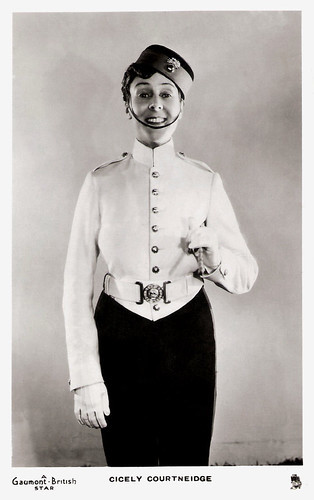
British postcard by Raphael Tuck & Sons, no. 14. Photo: Gaumont-British. Cicely Courtneidge in Soldiers of the King/The Woman in Command (Maurice Elvey, 1933).
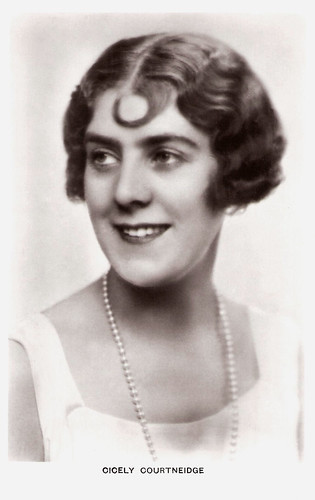
British postcard in the Picturegoer Series by Real Photograph, London, no. 326.
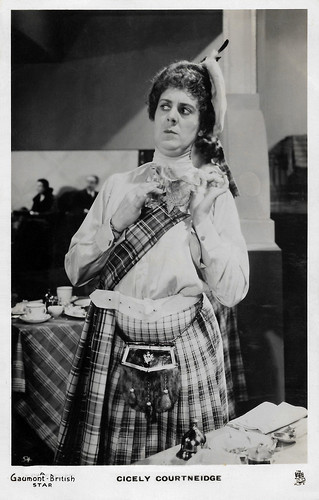
British Real Photograph postcard by Raphael Tuck & Sons, London, no. 13. Photo: Gaumont-British.
The Fairy Peaseblossom
Esmerelda Cicely Courtneidge was born in Sydney, Australia in 1893. She was the daughter of the producer Robert Courtneidge, and at the time of her birth, he was touring Australia with the J. C. Williamson company. Her mother was Rosaline May née Adams (stage name Rosie Nott), the daughter of the opera singer Cicely Nott. The family returned to England in 1894.
In 1901, at the age of eight, Courtneidge made her stage debut as the fairy Peaseblossom in her father's production of 'A Midsummer Night's Dream' at the Prince's Theatre, Manchester.
By the age of 16, she appeared in his Edwardian musical comedies in the West End in London. Her West End debut was at the Apollo Theatre in the comic opera 'Tom Jones' (1907), which had a libretto co-written by her father.
Cicely was quickly promoted from minor to major roles. Her first starring role was Eileen Cavanagh in the long-running Edwardian musical comedy 'The Arcadians', which she took over from Phyllis Dare in 1910.
In the piece that followed, 'The Mousmé' (1911), which also featured a book co-written by her father, she was cast in one of the two leading female roles alongside Florence Smithson.
Her third musical comedy was 'The Pearl Girl' (1913) with the 21-year-old Jack Hulbert , making his professional debut.
Courtneidge and Hulbert starred together in 'The Cinema Star' (1914), an adaptation by Hulbert and Harry Graham of 'Die Kino-Königin', a 1913 German comic opera by Jean Gilbert. The piece was a hit and played to full houses at the Shaftesbury Theatre until Britain and Germany went to war in August 1914. Anti-German sentiment brought the run to an abrupt halt.
Soon after the outbreak of war, Hulbert joined the army. Courtneidge continued to appear in her father's productions in the West End and on tour. But Robert Courtneidge had a series of failures and temporarily withdrew from producing.
No other producers offered Cicely leading roles in musical comedies, and she turned instead to the music hall, learning her craft as a comedienne. In variety shows, she showed off her tuneful voice, forceful humour, and vital personality, and she held the attention of the audience. By 1918 she had firmly established herself as a music-hall artiste, both in the provinces and in London.
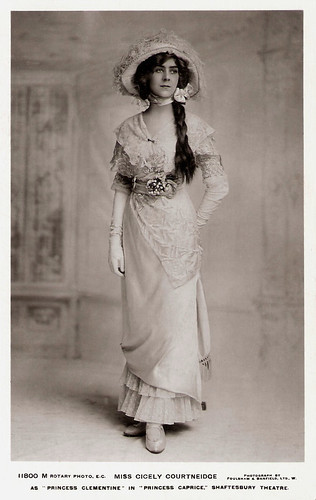
British postcard by Rotary, no. 11800 M. Photo: Foulsham & Banfield. Caption: Cicely Courtneidge in 'Princess Caprice' Shaftesbury Theatre.
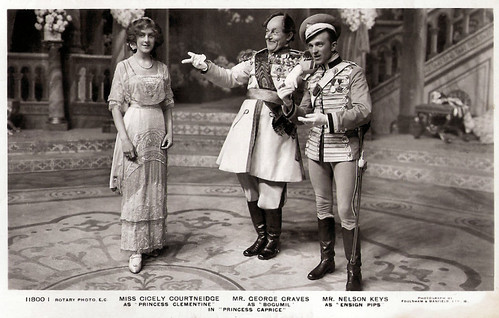
British postcard by Rotary Photo, no. 11800 I. Photo: Foulsham and Banfield Ltd.Cicely Courtneidge as Princess Clementine, George Graves as Bugumil, and Nelson Keyes as Ensign Pips in 'Princess Caprice' (1912). 'Princess Caprice' is a comedy with music, in three acts, with music by Leo Fall. The original production opened at the Shaftesbury Theatre, London, on 11 May 1912, running for 265 performances until January 1913. It was produced by Robert Courtneidge.
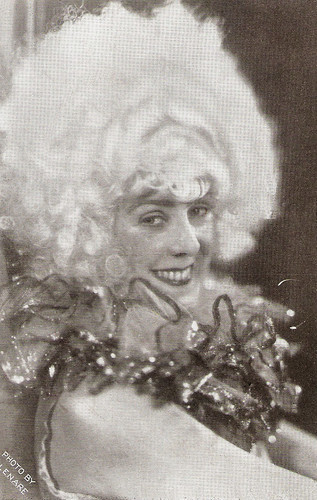
British postcard by the Apollo Theatre, London. Photo: Lenare. Sent by mail in 1925. Caption: Miss Cicely Courtneidge in 'By the Way', A New Revue With Jack Hulbert , Cicely Courtneidge and Betty Chester.
Liquidation
Cicely Courtneidge and Jack Hulbert married in 1916. They formed a professional as well as a private partnership that lasted until his death, 62 years later. Their first revue was Ring Up, by Eric Blore and Ivy St. Helier, at the Royalty Theatre in 1921. They received good notices, but the material was weak, and the show was not a great success.
Courtneidge returned to variety and appeared at the London Coliseum in 1922. In 1923, Courtneidge and Hulbert starred in 'The Little Revue', produced by Hulbert. The Times : "there is no reason why it should not have a dozen successors, all as good." There were, in fact, five successors, which were a continuous success over eight years.
In 1925, they made their Broadway debut in the revue, 'By-the-Way'. In 1931 Courtneidge and Hulbert suffered a serious setback when their financial manager had put their business into liquidation. Hulbert accepted responsibility for all the debts and to repay his creditors, he and his wife moved over to the cinema.
A boom in the film industry enabled actors to earn lucrative sums. Their first appearance in the all-star Elstree Calling (Adrian Brunel, Alfred Hitchcock, Andre Charlot, Paul Murray, Jack Hulbert, 1930) had gone down well enough for them to be offered more film roles.
During the 1930s, Courtneidge appeared in 11 British films, and one in Hollywood. She and Hulbert worked together in such Gainsborough comedies as The Ghost Train (Walter Forde, 1931) with Ann Todd , the comedy Jack's the Boy (Walter Forde, 1932) and Falling for You (Walter Forde, 1933) with Tamara Desni .
Hulbert played the dashing hero in The Ghost Train while Courtneidge played a mad spinster - a pattern that was repeated in many of their subsequent films together. For the German Ufa studio, they appeared in the musical Happy Ever After (Paul Martin, Robert Stevenson, 1932) starring Lilian Harvey .
Solo, Cicely starred in Soldiers of the King (Maurice Elvey, 1934) in which she played a double role opposite Edward Everett Horton, and scored a solid hit. Hollywood took an interest and she went over to MGM to make The Perfect Gentleman (Tim Whelan, 1935) with Frank Morgan. It was a disastrous production and a massive flop.
Back at Gainsborough, she starred in Me and Marlborough (Victor Saville, 1935) with Tom Walls , Things Are Looking Up (Albert de Courville, 1935) and Everybody Dance (Charles Reisner, 1936).
In 1937, she reunited with Jack Hulbert on-screen in Take My Tip (Herbert Mason, 1937), and on stage in 'Under Your Hat', a spy story co-written by Hulbert, with music and lyrics by Vivian Ellis. The production ran at the Palace Theatre until April 1940 and was then filmed for the cinema, Under Your Hat (Maurice Elvey, 1940).
During the 1930s, Cicely Courtneidge and Jack Hulbert also recorded for Columbia and HMV such songs as 'Why has a cow got four legs'. Solo, Courtneidge recorded her celebrated sketch 'Laughing Gas' (1931).
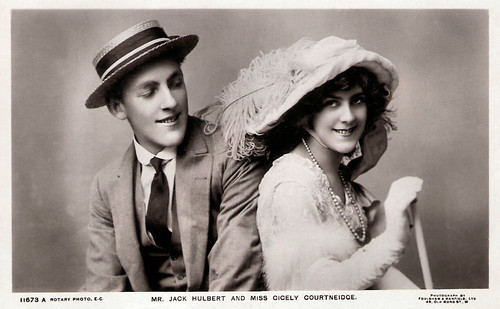
British postcard in the Rotary Photographic Series, no. 11673 A. Photo: Foulsham & Banfield.
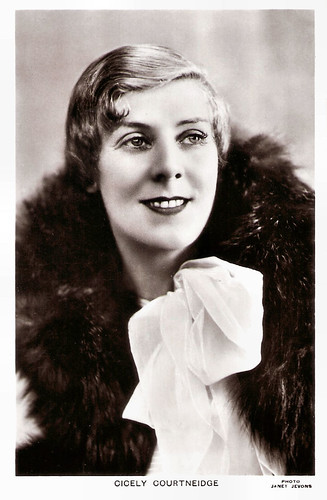
British postcard in the Picturegoer Series, London, no. 326a. Photo: Janet Jevons.
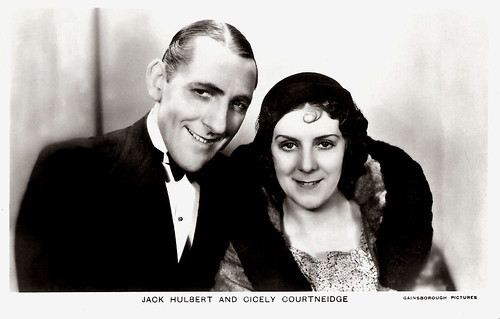
British postcard in the Film Partners Series, no. P 42. Photo: Gainsborough Pictures.
Gay's the Word
During the Second World War, Cicely Courtneidge entertained the troops and raised funds for the army. In 1941, she presented a nightly three-hour show, raising funds, and then formed a small company that she took to Gibraltar, Malta, North Africa, and Italy, performing for the services and hospitals.
She also toured in 'Hulbert Follies' (1941), and 'Full Swing' (1942), which she and Hulbert then brought to the Palace Theatre. At the end of the war, she had a long run in 'Under the Counter', a comedy in which she received glowing notices. Its theme was the black market in luxury goods and the heroine's shamelessness in manipulating it to her advantage.
This struck a chord with British audiences after the privations of the war, and the play, produced by Hulbert, ran for two years. Notable among her other successes was Courtneidge's performance in Ivor Novello 's musical 'Gay's the Word' in 1951–1952. In 1951 she was appointed CBE (Commander of the Order of the British Empire).
In 1955 she made a come-back on the screen in the crime film Miss Tulip Stays the Night (Leslie Arliss, 1955) with Jack Hulbert and Diana Dors . During the rest of the decade, she turned from musicals, revues to straight plays.
In 1962, she gave what she considered her finest film performance in The L-Shaped Room (Bryan Forbes, 1962) starring Leslie Caron . Unlike her usual parts, she played an elderly lesbian, living in a drab London flat with her cat, recalling her career as an actress and forlornly trying to keep in touch with former friends. The Times described her performance as a triumph.
In 1964, she appeared in the London production of 'High Spirits', a musical adaptation of Noël Coward's 'Blithe Spirit'. Coward himself co-directed, and the two clashed constantly. The notices for the play and for Courtneidge were both dreadful.
The last London production in which the Hulberts appeared together was a well-reviewed revival of 'Dear Octopus' at the Haymarket Theatre in 1967 with Richard Todd . In 1969, Courtneidge turned to television, playing a working-class role as Mum in the first series of the comedy On the Buses, opposite Reg Varney. Her role was played by Doris Hare in the rest of the series’ long run.
While appearing in her last West End run in 1971, she celebrated 70 years on the stage. Afterward, she continued to work for a further five years before retiring. In 1972 she was appointed DBE (Dame Commander of the Order of the British Empire).
Her last film was Not Now Darling (Ray Cooney, David Croft, 1973), a farce in which Jack Hulbert also appeared, both in supporting parts. One of her last appearances was in a royal gala performance at the Chichester Festival Theatre in June 1977, celebrating the Queen's Silver Jubilee. The performance was called God Save the Queen! and had an all-star cast, including Ingrid Bergman , Wendy Hiller and Diana Rigg .
Jack Hulbert died in 1978; Dame Cicely Courtneidge DBE died two years later, shortly after her 87th birthday, at a nursing home in Putney. She was survived by her only child, a daughter.
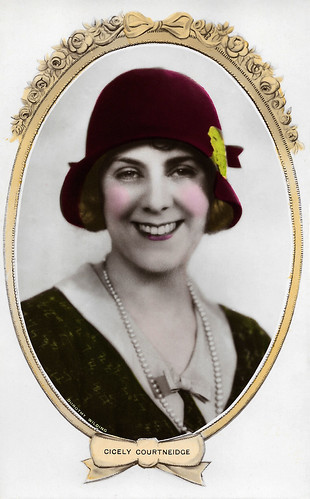
British postcard in the Cameo Series, London, no. KC 28. Photo: Dorothy Wilding.
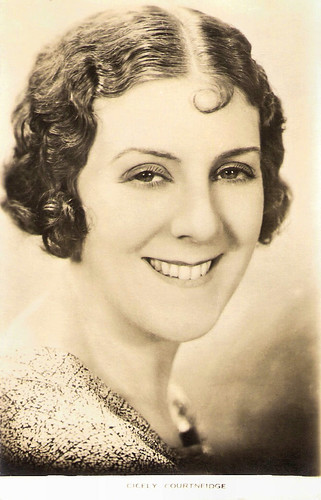
British postcard
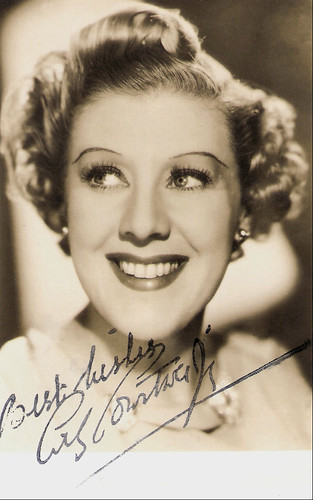
British autograph card.
Sources: David Absalom (British Pictures), Stanley Greene (Encyclopedia of the Musical theatre), The Cicely Courtneidge & Jack Hulbert Archive, Wikipedia and .

British postcard by Raphael Tuck & Sons, no. 14. Photo: Gaumont-British. Cicely Courtneidge in Soldiers of the King/The Woman in Command (Maurice Elvey, 1933).

British postcard in the Picturegoer Series by Real Photograph, London, no. 326.

British Real Photograph postcard by Raphael Tuck & Sons, London, no. 13. Photo: Gaumont-British.
The Fairy Peaseblossom
Esmerelda Cicely Courtneidge was born in Sydney, Australia in 1893. She was the daughter of the producer Robert Courtneidge, and at the time of her birth, he was touring Australia with the J. C. Williamson company. Her mother was Rosaline May née Adams (stage name Rosie Nott), the daughter of the opera singer Cicely Nott. The family returned to England in 1894.
In 1901, at the age of eight, Courtneidge made her stage debut as the fairy Peaseblossom in her father's production of 'A Midsummer Night's Dream' at the Prince's Theatre, Manchester.
By the age of 16, she appeared in his Edwardian musical comedies in the West End in London. Her West End debut was at the Apollo Theatre in the comic opera 'Tom Jones' (1907), which had a libretto co-written by her father.
Cicely was quickly promoted from minor to major roles. Her first starring role was Eileen Cavanagh in the long-running Edwardian musical comedy 'The Arcadians', which she took over from Phyllis Dare in 1910.
In the piece that followed, 'The Mousmé' (1911), which also featured a book co-written by her father, she was cast in one of the two leading female roles alongside Florence Smithson.
Her third musical comedy was 'The Pearl Girl' (1913) with the 21-year-old Jack Hulbert , making his professional debut.
Courtneidge and Hulbert starred together in 'The Cinema Star' (1914), an adaptation by Hulbert and Harry Graham of 'Die Kino-Königin', a 1913 German comic opera by Jean Gilbert. The piece was a hit and played to full houses at the Shaftesbury Theatre until Britain and Germany went to war in August 1914. Anti-German sentiment brought the run to an abrupt halt.
Soon after the outbreak of war, Hulbert joined the army. Courtneidge continued to appear in her father's productions in the West End and on tour. But Robert Courtneidge had a series of failures and temporarily withdrew from producing.
No other producers offered Cicely leading roles in musical comedies, and she turned instead to the music hall, learning her craft as a comedienne. In variety shows, she showed off her tuneful voice, forceful humour, and vital personality, and she held the attention of the audience. By 1918 she had firmly established herself as a music-hall artiste, both in the provinces and in London.

British postcard by Rotary, no. 11800 M. Photo: Foulsham & Banfield. Caption: Cicely Courtneidge in 'Princess Caprice' Shaftesbury Theatre.

British postcard by Rotary Photo, no. 11800 I. Photo: Foulsham and Banfield Ltd.Cicely Courtneidge as Princess Clementine, George Graves as Bugumil, and Nelson Keyes as Ensign Pips in 'Princess Caprice' (1912). 'Princess Caprice' is a comedy with music, in three acts, with music by Leo Fall. The original production opened at the Shaftesbury Theatre, London, on 11 May 1912, running for 265 performances until January 1913. It was produced by Robert Courtneidge.

British postcard by the Apollo Theatre, London. Photo: Lenare. Sent by mail in 1925. Caption: Miss Cicely Courtneidge in 'By the Way', A New Revue With Jack Hulbert , Cicely Courtneidge and Betty Chester.
Liquidation
Cicely Courtneidge and Jack Hulbert married in 1916. They formed a professional as well as a private partnership that lasted until his death, 62 years later. Their first revue was Ring Up, by Eric Blore and Ivy St. Helier, at the Royalty Theatre in 1921. They received good notices, but the material was weak, and the show was not a great success.
Courtneidge returned to variety and appeared at the London Coliseum in 1922. In 1923, Courtneidge and Hulbert starred in 'The Little Revue', produced by Hulbert. The Times : "there is no reason why it should not have a dozen successors, all as good." There were, in fact, five successors, which were a continuous success over eight years.
In 1925, they made their Broadway debut in the revue, 'By-the-Way'. In 1931 Courtneidge and Hulbert suffered a serious setback when their financial manager had put their business into liquidation. Hulbert accepted responsibility for all the debts and to repay his creditors, he and his wife moved over to the cinema.
A boom in the film industry enabled actors to earn lucrative sums. Their first appearance in the all-star Elstree Calling (Adrian Brunel, Alfred Hitchcock, Andre Charlot, Paul Murray, Jack Hulbert, 1930) had gone down well enough for them to be offered more film roles.
During the 1930s, Courtneidge appeared in 11 British films, and one in Hollywood. She and Hulbert worked together in such Gainsborough comedies as The Ghost Train (Walter Forde, 1931) with Ann Todd , the comedy Jack's the Boy (Walter Forde, 1932) and Falling for You (Walter Forde, 1933) with Tamara Desni .
Hulbert played the dashing hero in The Ghost Train while Courtneidge played a mad spinster - a pattern that was repeated in many of their subsequent films together. For the German Ufa studio, they appeared in the musical Happy Ever After (Paul Martin, Robert Stevenson, 1932) starring Lilian Harvey .
Solo, Cicely starred in Soldiers of the King (Maurice Elvey, 1934) in which she played a double role opposite Edward Everett Horton, and scored a solid hit. Hollywood took an interest and she went over to MGM to make The Perfect Gentleman (Tim Whelan, 1935) with Frank Morgan. It was a disastrous production and a massive flop.
Back at Gainsborough, she starred in Me and Marlborough (Victor Saville, 1935) with Tom Walls , Things Are Looking Up (Albert de Courville, 1935) and Everybody Dance (Charles Reisner, 1936).
In 1937, she reunited with Jack Hulbert on-screen in Take My Tip (Herbert Mason, 1937), and on stage in 'Under Your Hat', a spy story co-written by Hulbert, with music and lyrics by Vivian Ellis. The production ran at the Palace Theatre until April 1940 and was then filmed for the cinema, Under Your Hat (Maurice Elvey, 1940).
During the 1930s, Cicely Courtneidge and Jack Hulbert also recorded for Columbia and HMV such songs as 'Why has a cow got four legs'. Solo, Courtneidge recorded her celebrated sketch 'Laughing Gas' (1931).

British postcard in the Rotary Photographic Series, no. 11673 A. Photo: Foulsham & Banfield.

British postcard in the Picturegoer Series, London, no. 326a. Photo: Janet Jevons.

British postcard in the Film Partners Series, no. P 42. Photo: Gainsborough Pictures.
Gay's the Word
During the Second World War, Cicely Courtneidge entertained the troops and raised funds for the army. In 1941, she presented a nightly three-hour show, raising funds, and then formed a small company that she took to Gibraltar, Malta, North Africa, and Italy, performing for the services and hospitals.
She also toured in 'Hulbert Follies' (1941), and 'Full Swing' (1942), which she and Hulbert then brought to the Palace Theatre. At the end of the war, she had a long run in 'Under the Counter', a comedy in which she received glowing notices. Its theme was the black market in luxury goods and the heroine's shamelessness in manipulating it to her advantage.
This struck a chord with British audiences after the privations of the war, and the play, produced by Hulbert, ran for two years. Notable among her other successes was Courtneidge's performance in Ivor Novello 's musical 'Gay's the Word' in 1951–1952. In 1951 she was appointed CBE (Commander of the Order of the British Empire).
In 1955 she made a come-back on the screen in the crime film Miss Tulip Stays the Night (Leslie Arliss, 1955) with Jack Hulbert and Diana Dors . During the rest of the decade, she turned from musicals, revues to straight plays.
In 1962, she gave what she considered her finest film performance in The L-Shaped Room (Bryan Forbes, 1962) starring Leslie Caron . Unlike her usual parts, she played an elderly lesbian, living in a drab London flat with her cat, recalling her career as an actress and forlornly trying to keep in touch with former friends. The Times described her performance as a triumph.
In 1964, she appeared in the London production of 'High Spirits', a musical adaptation of Noël Coward's 'Blithe Spirit'. Coward himself co-directed, and the two clashed constantly. The notices for the play and for Courtneidge were both dreadful.
The last London production in which the Hulberts appeared together was a well-reviewed revival of 'Dear Octopus' at the Haymarket Theatre in 1967 with Richard Todd . In 1969, Courtneidge turned to television, playing a working-class role as Mum in the first series of the comedy On the Buses, opposite Reg Varney. Her role was played by Doris Hare in the rest of the series’ long run.
While appearing in her last West End run in 1971, she celebrated 70 years on the stage. Afterward, she continued to work for a further five years before retiring. In 1972 she was appointed DBE (Dame Commander of the Order of the British Empire).
Her last film was Not Now Darling (Ray Cooney, David Croft, 1973), a farce in which Jack Hulbert also appeared, both in supporting parts. One of her last appearances was in a royal gala performance at the Chichester Festival Theatre in June 1977, celebrating the Queen's Silver Jubilee. The performance was called God Save the Queen! and had an all-star cast, including Ingrid Bergman , Wendy Hiller and Diana Rigg .
Jack Hulbert died in 1978; Dame Cicely Courtneidge DBE died two years later, shortly after her 87th birthday, at a nursing home in Putney. She was survived by her only child, a daughter.

British postcard in the Cameo Series, London, no. KC 28. Photo: Dorothy Wilding.

British postcard

British autograph card.
Sources: David Absalom (British Pictures), Stanley Greene (Encyclopedia of the Musical theatre), The Cicely Courtneidge & Jack Hulbert Archive, Wikipedia and .
Published on June 14, 2020 22:00
June 13, 2020
Capucine
Elegant French actress and fashion model Capucine (1928-1990) appeared in 36 films and 17 television productions between 1948 and 1990. She is best known for her roles in the comedies The Pink Panther (1963) and What's New Pussycat? (1965). In 1990 she committed suicide.
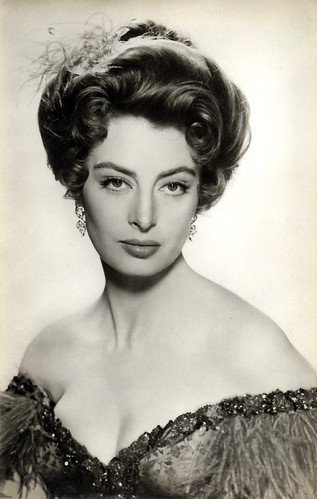
Spanish postcard by Edic. Raker, Barcelona, no. 117. Photo: Fox. Capucine in North to Alaska (Henry Hathaway, 1960).
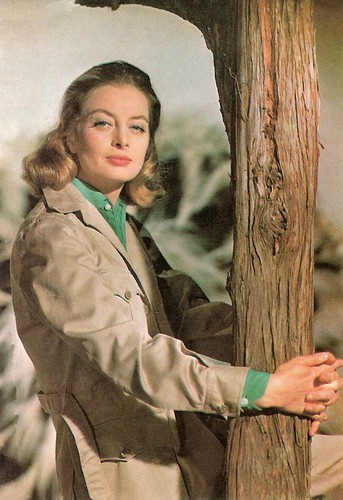
Spanish postcard by Postal Oscar Color S.A., Hospitalet (Barcelona), no. 300.
Paris, Manhattan, Hollywood
Capucine was born Germaine Hélène Irène Lefebvre in Saint-Raphaël, France in 1928. She often confused the issue by saying she was born in 1931 or 1933, and some sources report these years, but according to Wikipedia there is documentary evidence for a 1928 year of birth.
She attended school in France and received a B.A. in foreign languages. Her middle-class family wanted her to become a school teacher. When she balked at that, they suggested she work in a bank. At 17, while riding in a carriage in Paris, she was noticed by a commercial photographer. She became a fashion model, working for the fashion houses of Hubert de Givenchy, Pierre Balmain, and Christian Dior.
She had classic patrician features ( The New York Times compared her to Nefertiti) and an independent, non-conformist personality. She adopted the name Capucine, French for the nasturtium flower, a kind of watercress. While modelling in Paris, Capucine met Audrey Hepburn , and the two would remain friends for the rest of Capucine's life.
When she was sixteen, Capucine made her film debut as an extra in the French film L’Aigle à deux têtes/The Eagle Has Two Heads (Jean Cocteau, 1948) starring Edwige Feuillère . It was followed by a small part in Rendez-vous de Juillet/Rendezvous in July (Jacques Becker, 1949) starring Daniel Gélin .
In Rendez-vous de Juillet, she played the girlfriend of a character played by Pierre Trabaud. In real life, the two also fell in love and they married the next year. However, the marriage lasted only six months, and Capucine never married again.
She played small parts in the comedy Mon ami Sainfoin/My Friend Sainfoin (Marc-Gilbert Sauvajon, 1950) with Pierre Blanchar , Bertrand coeur de lion/Bernard and the Lion (Robert Dhéry, 1951) and Frou-Frou (Augusto Genina, 1955) featuring Dany Robin .
In 1956 Capucine moved to New York to model there. One night in 1957 at the Manhattan restaurant Le Pavilion, she met John Wayne and agent/producer Charles K. Feldman. Feldman signed her to a contract and she later moved in with him. Feldman brought her to Hollywood to learn English and study acting under Gregory Ratoff.
She signed a contract with Columbia Pictures in 1958 and landed her first English-speaking role as Princess Carolyne in the Franz Liszt biopic Song Without End (Charles Vidor, George Cukor, 1960) for which she was nominated for a Golden Globe Award. She became close friends with her co-star Dirk Bogarde , and often visited him at his home in France.
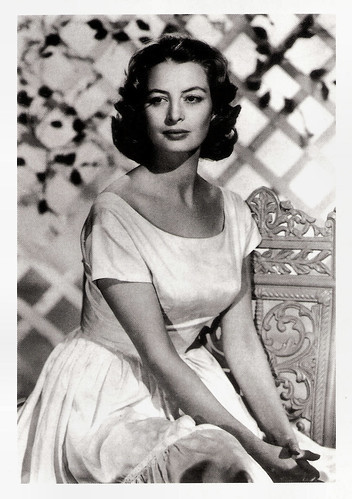
Spanish postcard in the 'Coleccion Mitos Cinematograficos' by Cacitel, no. 82.
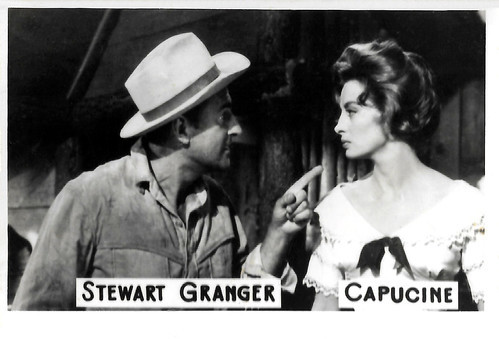
Small Romanian collectors card. Stewart Granger and Capucine in North to Alaska (Henry Hathaway, 1960).
Lesbian Hooker
For the next few years, Capucine made six more major Hollywood movies. They included the Western comedy North to Alaska (Henry Hathaway, 1960), as a prostitute who becomes the love interest of John Wayne , and the sensational melodrama Walk on the Wild Side (Edward Dmytryk, 1962), in which she portrayed a lesbian hooker opposite Laurence Harvey . The role gave her some notoriety, but also made her an icon for many lesbians.
In Hollywood, she met actor William Holden and the two began a two-year affair, despite the fact that Holden was married to Brenda Marshall. Capucine and Holden starred together in the films The Lion (Jack Cardiff, 1962) and The 7th Dawn (Lewis Gilbert, 1964). After the affair ended, she and Holden remained friends until his death in 1981.
In 1962, she moved to Switzerland where Holden had a house, and much of The Pink Panther (Blake Edwards, 1963) was shot in Europe. She played in this crime comedy Simone Clouseau, the wife of bumbling and conceited police inspector Jacques Clouseau ( Peter Sellers ). The film was nominated for an Oscar and became a huge box office a hit. This success led to a number of popular sequels and Capucine returned in two of them.
She also reunited with Peter Sellers in the cult comedy What's New Pussycat? (Clive Donner, Richard Talmadge, 1965), written by Woody Allen. Other successful films were the crime comedy The Honey Pot (Joseph L. Mankiewicz, 1967) with Rex Harrison , Fellini’s flamboyant masterpiece about ancient Rome Satyricon (Federico Fellini, 1969) and the action-thriller Soleil rouge/Red Sun (Terence Young, 1971) starring Charles Bronson .
She continued making films in Europe until her death. Among her later films were the comedy L'incorrigible/Incorrigible (Philippe de Broca, 1975) with Jean-Paul Belmondo , the romantic drama Per amore (Mino Giarda, 1976) with Michael Craig, and Bluff storia di truffe e di imbroglioni/The Con Artists (Sergio Corbucci, 1976) with Anthony Quinn and Adriano Celentano .
Except for some appearances in TV films, she spent her last decade in seclusion in Switzerland. In 1990, Capucine jumped from her eighth-floor apartment in Lausanne, where she had lived for 28 years. She had reportedly suffered from illness and depression for some time. According to IMDb, she was a manic-depressive, and on several occasions, her friend Audrey Hepburn had saved her life after suicide attempts. Capucine was 62.
The New York Times stated in its obituary that her only known survivors were her three cats (this detail is removed from the internet version of the obituary). Lenin Imports quotes her: "I used to think I needed a man to define myself. Not any more." Whether this statement was an acknowledgment that Capucine was lesbian or bisexual is not known, though she did talk in later interviews late in life about her preference for women.
Original trailer for The Pink Panther (1963). Source: Movieclips Classic Trailers (YouTube).
Trailer for Jaguar Lives! (Ernest Pintoff, 1979). Source: Arrow Video (YouTube).
Sources: Hal Erickson (AllMovie), The New York Times, Lenin Imports, Wikipedia (English and French), and .

Spanish postcard by Edic. Raker, Barcelona, no. 117. Photo: Fox. Capucine in North to Alaska (Henry Hathaway, 1960).

Spanish postcard by Postal Oscar Color S.A., Hospitalet (Barcelona), no. 300.
Paris, Manhattan, Hollywood
Capucine was born Germaine Hélène Irène Lefebvre in Saint-Raphaël, France in 1928. She often confused the issue by saying she was born in 1931 or 1933, and some sources report these years, but according to Wikipedia there is documentary evidence for a 1928 year of birth.
She attended school in France and received a B.A. in foreign languages. Her middle-class family wanted her to become a school teacher. When she balked at that, they suggested she work in a bank. At 17, while riding in a carriage in Paris, she was noticed by a commercial photographer. She became a fashion model, working for the fashion houses of Hubert de Givenchy, Pierre Balmain, and Christian Dior.
She had classic patrician features ( The New York Times compared her to Nefertiti) and an independent, non-conformist personality. She adopted the name Capucine, French for the nasturtium flower, a kind of watercress. While modelling in Paris, Capucine met Audrey Hepburn , and the two would remain friends for the rest of Capucine's life.
When she was sixteen, Capucine made her film debut as an extra in the French film L’Aigle à deux têtes/The Eagle Has Two Heads (Jean Cocteau, 1948) starring Edwige Feuillère . It was followed by a small part in Rendez-vous de Juillet/Rendezvous in July (Jacques Becker, 1949) starring Daniel Gélin .
In Rendez-vous de Juillet, she played the girlfriend of a character played by Pierre Trabaud. In real life, the two also fell in love and they married the next year. However, the marriage lasted only six months, and Capucine never married again.
She played small parts in the comedy Mon ami Sainfoin/My Friend Sainfoin (Marc-Gilbert Sauvajon, 1950) with Pierre Blanchar , Bertrand coeur de lion/Bernard and the Lion (Robert Dhéry, 1951) and Frou-Frou (Augusto Genina, 1955) featuring Dany Robin .
In 1956 Capucine moved to New York to model there. One night in 1957 at the Manhattan restaurant Le Pavilion, she met John Wayne and agent/producer Charles K. Feldman. Feldman signed her to a contract and she later moved in with him. Feldman brought her to Hollywood to learn English and study acting under Gregory Ratoff.
She signed a contract with Columbia Pictures in 1958 and landed her first English-speaking role as Princess Carolyne in the Franz Liszt biopic Song Without End (Charles Vidor, George Cukor, 1960) for which she was nominated for a Golden Globe Award. She became close friends with her co-star Dirk Bogarde , and often visited him at his home in France.

Spanish postcard in the 'Coleccion Mitos Cinematograficos' by Cacitel, no. 82.

Small Romanian collectors card. Stewart Granger and Capucine in North to Alaska (Henry Hathaway, 1960).
Lesbian Hooker
For the next few years, Capucine made six more major Hollywood movies. They included the Western comedy North to Alaska (Henry Hathaway, 1960), as a prostitute who becomes the love interest of John Wayne , and the sensational melodrama Walk on the Wild Side (Edward Dmytryk, 1962), in which she portrayed a lesbian hooker opposite Laurence Harvey . The role gave her some notoriety, but also made her an icon for many lesbians.
In Hollywood, she met actor William Holden and the two began a two-year affair, despite the fact that Holden was married to Brenda Marshall. Capucine and Holden starred together in the films The Lion (Jack Cardiff, 1962) and The 7th Dawn (Lewis Gilbert, 1964). After the affair ended, she and Holden remained friends until his death in 1981.
In 1962, she moved to Switzerland where Holden had a house, and much of The Pink Panther (Blake Edwards, 1963) was shot in Europe. She played in this crime comedy Simone Clouseau, the wife of bumbling and conceited police inspector Jacques Clouseau ( Peter Sellers ). The film was nominated for an Oscar and became a huge box office a hit. This success led to a number of popular sequels and Capucine returned in two of them.
She also reunited with Peter Sellers in the cult comedy What's New Pussycat? (Clive Donner, Richard Talmadge, 1965), written by Woody Allen. Other successful films were the crime comedy The Honey Pot (Joseph L. Mankiewicz, 1967) with Rex Harrison , Fellini’s flamboyant masterpiece about ancient Rome Satyricon (Federico Fellini, 1969) and the action-thriller Soleil rouge/Red Sun (Terence Young, 1971) starring Charles Bronson .
She continued making films in Europe until her death. Among her later films were the comedy L'incorrigible/Incorrigible (Philippe de Broca, 1975) with Jean-Paul Belmondo , the romantic drama Per amore (Mino Giarda, 1976) with Michael Craig, and Bluff storia di truffe e di imbroglioni/The Con Artists (Sergio Corbucci, 1976) with Anthony Quinn and Adriano Celentano .
Except for some appearances in TV films, she spent her last decade in seclusion in Switzerland. In 1990, Capucine jumped from her eighth-floor apartment in Lausanne, where she had lived for 28 years. She had reportedly suffered from illness and depression for some time. According to IMDb, she was a manic-depressive, and on several occasions, her friend Audrey Hepburn had saved her life after suicide attempts. Capucine was 62.
The New York Times stated in its obituary that her only known survivors were her three cats (this detail is removed from the internet version of the obituary). Lenin Imports quotes her: "I used to think I needed a man to define myself. Not any more." Whether this statement was an acknowledgment that Capucine was lesbian or bisexual is not known, though she did talk in later interviews late in life about her preference for women.
Original trailer for The Pink Panther (1963). Source: Movieclips Classic Trailers (YouTube).
Trailer for Jaguar Lives! (Ernest Pintoff, 1979). Source: Arrow Video (YouTube).
Sources: Hal Erickson (AllMovie), The New York Times, Lenin Imports, Wikipedia (English and French), and .
Published on June 13, 2020 22:00
June 12, 2020
J.R.P.R., Paris
J.R.P.R. was a French postcard publisher, located in Paris. The company produced more than 500 postcards with International stars of the late silent cinema or scenes of such classic films as Ben-Hur: A Tale of the Christ (Fred Niblo, 1925) and L'Argent/The Money (Marcel L'Herbier, 1928). The French photos were mostly shot by either Studio Lorelle or G.L. Manuel Frères. We selected 26 postcards.
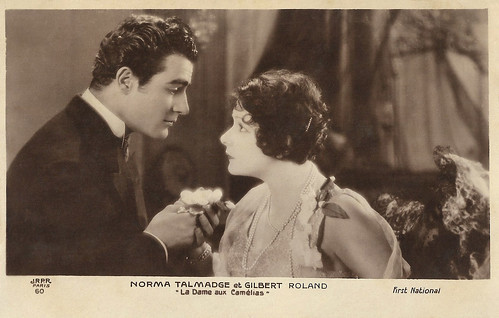
French postcard by J.R.P.R., Paris, no. 60. Photo: First National. Gilbert Roland and Norma Talmadge in Camille (Fred Niblo, 1926).
Mexican-born American film star Gilbert Roland (1905–1994) was often cast in the typical 'Latin Lover' role during the silent era. Roland later played romantic lead roles in Spanish language adaptations of American films. In the mid-1940s, he featured in the popular film series around The Cisco Kid. Beginning in the 1940s, critics began to take notice of his acting and he was praised for his supporting roles in John Huston's We Were Strangers (1949), The Bad and the Beautiful (1952), and Cheyenne Autumn (1964). His last film appearance was in the Western Barbarosa (1984). Norma Talmadge (1894–1957) was an American actress and film producer of the silent era. A major box-office-draw for more than a decade, her career reached a peak in the early 1920s, when she ranked among the most popular idols of the American screen.
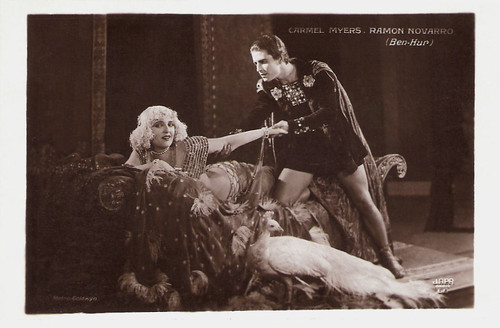
French postcard by J.R.P.R, Paris. no. 69. Photo: MGM. Carmel Myers and Ramon Novarro in Ben-Hur: A Tale of the Christ (Fred Niblo, 1925).
In Ben-Hur: A Tale of the Christ (Fred Niblo, 1925), silent film star Ramon Novarro plays the Jewish prince Judah Ben-Hur, who seeks to find his family and to revenge himself upon his childhood friend Messala (Francis X. Bushman) who had him wrongly imprisoned. A slip of brick during a Roman parade causes Judah to be sent off as a galley slave, his property confiscated and his mother (Claire McDowell) and sister imprisoned. Years later, as a result of his determination to stay alive and his willingness to aid his Roman master, Judah returns to his homeland an exalted and wealthy Roman athlete. Unable to find his mother and sister, and believing them dead, he can think of nothing else than revenge against Messala. Ramon Novarro was promoted by MGM as a 'Latin Lover' and became known as a sex symbol after the death of Rudolph Valentino. Ben-Hur was Novarro's greatest success. His revealing costumes caused a sensation.

French postcard by J.R.P.R., Paris, no. 80. Photo: G.L. Manuel Frères.
Henry Roussel (1875–1946), also known as Henry Roussell, was a French silent film actor, film director, and screenwriter best known for his silent films of the 1910s and 1920s. He starred in well over 40 films between 1912 and 1939 and directed such films as Visages voilés... âmes closes (1921), Les opprimés (1923), Violettes impériales/Imperial Violets (1924) and Paris' Girls (1929), while in the early 1910s he was a regular actor of the Eclair company, often directed by Maurice Tourneur, and later on had memorable parts in e.g. Les nouveaux messieurs (1929).
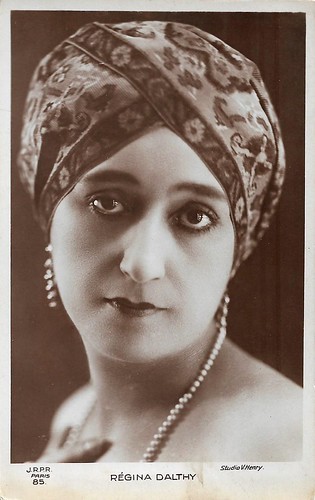
French postcard by J.R.P.R., Paris, no. 85. Photo: Studio V. Henry.
Little is known about Régina Dalthy, but her claim of fame is she played 'the other woman', the young marchioness Severo, in La sirène de tropiques (Mario Nalpas, Henri Étiévant, 1927), starring Josephine Baker and Pierre Batcheff. In the film her father, played by Georges Melchior, sends his daughter's fiancé to the tropics, plotting that he will never return. But young André (Batcheff) returns to Paris, followed by Papitou (Baker), a young black girl who saves his life and is secretly in love with him. Dalthy acted in three more films: the Brazilian silent comedy Augusto Aníbal Quer Casar (Luiz de Barros, 1923), La symphonie pathétique (1928), again directed by Nalpas and Etievant, and starring famous French boxer Georges Carpentier, and finally, the Franco-Spanish production La bodega (Benito Perojo, 1930), starring Gabriel Gabrio, Colette Darfeuil, and Enrique de Rivero, and shot in Andalucia and the Paris Pathé Natan studio.
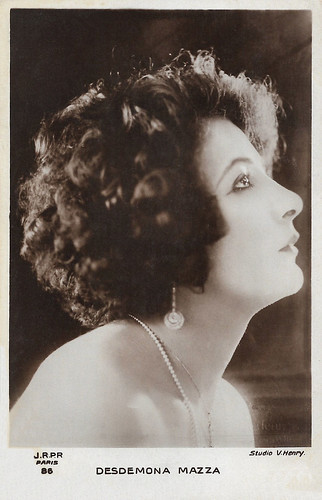
French postcard by J.R.P.R., Paris, no. 86. Photo: V. Henry.
Italian actress Desdemona Mazza (1901-?) appeared in Italian and French silent films. She worked with such directors as Louis Mercanton, Julien Duvivier and Marcel L’Herbier.
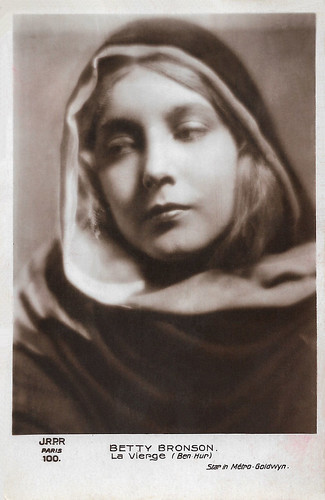
French postcard by J.R.P.R., Paris, no. 100. Photo: Metro-Goldwyn. Betty Bronson as The Holy Virgin in Ben-Hur (Fred Niblo, 1925).
Betty Bronson (1906-1971) was personally selected by J.M. Barrie to star in Peter Pan (Herbert Brenon, 1924). It remains her most famous part, even if she had a small but significant part as The Holy Virgin Mary in Ben-Hur (Fred Niblo, 1925) and starred in the delicious but less popular A Kiss for Cinderella (1925), again directed by Brenon and again based on Barrie. In the early sound era, Bronson played in the Al Jolson films The Singing Fool (1929) and its sequel Sonny Boy (1929) and had the female lead in the Jack Benny movie, The Medicine Man (1930).
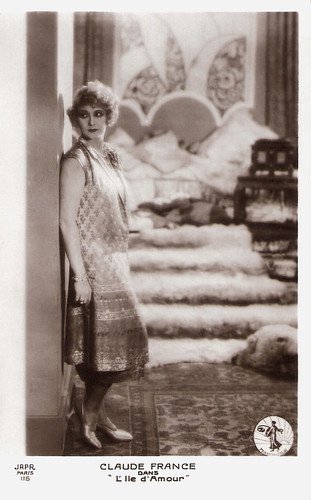
French postcard by J.R.P.R., Paris, no. 115. Photo: France-Film. Claude France in L'île d'amour/Island of Love (Berte Dagmar, Jean Durand, 1929).
Claude France (1893-1928) was a French actress of the 1920s. Two months before her greatest triumph opened in the cinemas, she committed suicide by opening the gas.
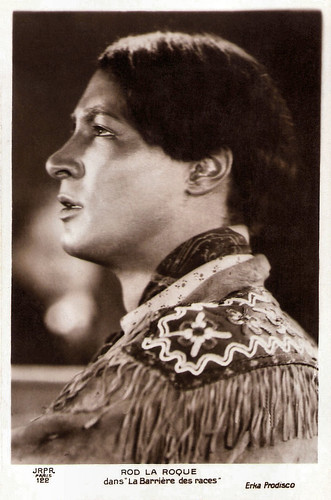
French postcard by J.R.P.R., Paris, no. 122. Photo: Erka Prodisco. Rod La Rocque in Braveheart (Alan Hale, 1925), which French release title was La barrière des races.
Rod La Rocque (1898-1969) was an American film actor between the 1910s and the 1930s. The dark-haired, tall actor often played the love interests of female stars, such as Pola Negri's in Ernst Lubitsch's drama Forbidden Paradise (1924).
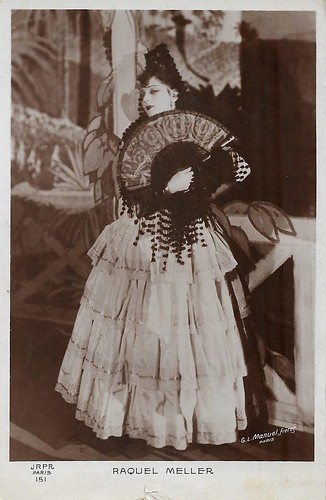
French postcard by J.R.P.R., Paris, no. 151. Photo: G.L. Manuel Frères.
Spanish actress, singer, and diva Raquel Meller acted mainly in French silent films. She was already a highly popular singer before debuting as a film actress in 1919.
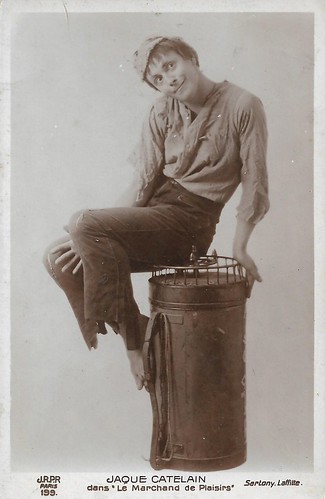
French postcard by J.R.P.R., Paris, no. 199. Jaque Catelain in Le marchand de plaisirs (Jaque Catelain, 1923). Photo: Sartony, Lafitte. This was one of two films Catelain directed himself, in addition to his prolific career as a silent film actor.
Jaque Catelain (1897-1965) was one of the most well-known faces of the French silent era. Catelain, also written Jaque-Catelain, Jacques Catelain and Jacque Cathelain, was originally named Jacques Guerin-Castelain.
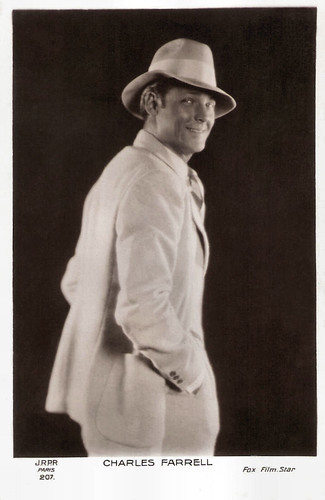
French postcard by J.R.P.R., Paris, no. 207. Photo: Fox.
Good-looking American actor Charles Farrell (1900-1990) was a Hollywood matinée idol of the Jazz Age and Depression-era. He seems now forgotten, but between 1927 and 1934, he was very popular thanks to his teaming with Janet Gaynor in 12 screen romances, including 7th Heaven (1927), Street Angel (1928), and Lucky Star (1929). He retired from films in the early 1940s, but TV audiences of the 1950s would see him as Gale Storm's widower dad in the television series My Little Margie (1952-1955).
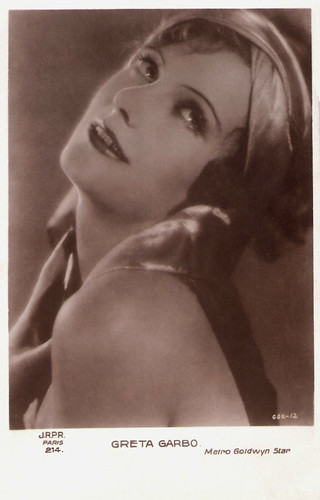
French postcard by J.R.P.R., Paris, no. 214. Photo: Metro-Goldwyn-Mayer.
Swedish Greta Garbo (1905-1990) was one of the greatest and most glamorous film stars ever produced by the Hollywood studio system. She was part of the Golden Age of the silent cinema of the 1920s and was one of the few actors who made a glorious transition to the talkies. She started her career in the European cinema and would always stay more popular in Europe than in the USA.

French postcard by J.R.P.R., Paris, no. 301. Ernst Van Duren in the French silent film Figaro (Gaston Ravel, 1929), based on the play by Beaumarchais. Van Duren played the title role. Location shooting was done at the Château de Rochefort-sur-Yvelines.
Little is known about French actor Ernst Van Duren aka Ernest van Duren aka Edmond Van Duren aka Van Duren (?-1930). The Dutch press at the time claimed he was Hungarian but of Dutch origin. What is known is that from 1921, he formed a famous dance couple with Edmonde Guy, the muse of the painter Kees van Dongen. He performed with her all over Europe and the US, where they were engaged by Florenz Ziegfeld for his 'Palm Beach Follies' (1926). Guy and Van Duren were known for their steamy performances and daring outfits. Van Duren was also known for his ephebic beauty, while his dance clearly had feminine aspects. Guy's sisters Christine and Marie were professional dancers too, known as The Guy Sisters, and often performed in choreographies by their brother Paul.
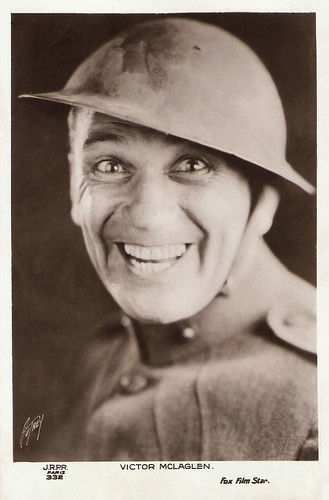
French postcard by J.R.P.R., Paris, no. 332. Photo: Max Munn Autrey / Fox. Victor McLaglen in What Price Glory (Raoul Walsh, 1926).
Victor McLaglen (1886-1959) was a Scottish boxer and World War I veteran who became a successful film actor. He started in British silent films, and later became a popular character actor in Hollywood, with a particular knack for playing drunks.
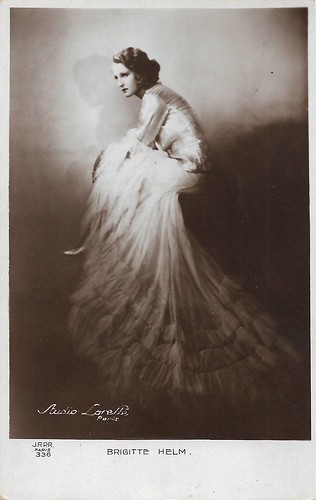
French postcard by J.R.P.R., no. 336. Photo: Studio Lorelle (Lucien Lorelle), Paris. Brigitte Helm in L'Argent/The Money (Marcel L'Herbier, 1928).
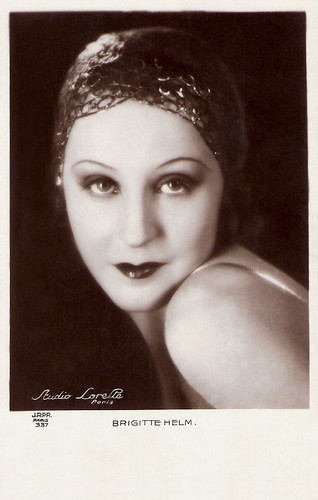
French postcard by J.R.P.R., no. 337. Photo: Studio Lorelle, Paris. Brigitte Helm in L'Argent/The Money (Marcel L'Herbier, 1928).

French postcard by J.R.P.R., no. 338. Photo: Studio Lorelle, Paris. Brigitte Helm in L'Argent/The Money (Marcel L'Herbier, 1928).
German actress Brigitte Helm (1908-1996) is still famous for her dual role as Maria and her double the evil Maria, the Maschinenmensch, in the silent SF classic Metropolis (Fritz Lang, 1927). After Metropolis she made a string of over 30 films in which she almost always had the starring role. She easily made the transition to sound films, before she abruptly retired in 1935.
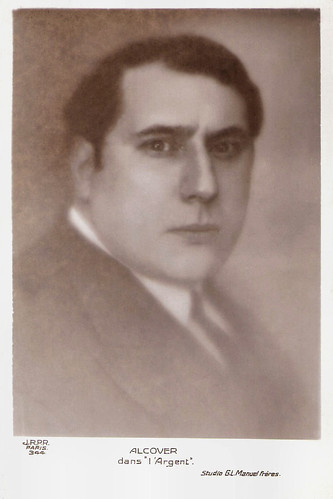
French postcard by J.R.P.R., Paris, no. 344. Pierre Alcover in L'Argent (Marcel L'Herbier, 1928). Photo: Studio G.L. Manuel Frères.
Pierre Alcover (1893-1957) knew a remarkable career from warehouseman at Les Halles in Paris to top actor, often playing bad guys, such as the head spy in La chèvre aux pieds d'or (Jacques Robert, 1925) and the scheming banker in L'Argent (1928) by Marcel L'Herbier, but also law enforcers such as police officers and wardens, e.g. Criminel (1933), or simple men such as the ambitious new pilot on a barge in L'Hirondelle et la mesange (André Antoine, 1924), and the violent but good-hearted convict in La petite Lise (Jean Grémillon 1930). Guy Bellinger on IMDb : "On the silver screen, his imposing stature and his gruff tone predisposed him to violent roles, on either side of the law. [...] Anyway, whether a lawbreaker or a law enforcer, Pierre Alcover brought the same conviction (no pun intended) to the role he was given to play. One of the great character actors of the 1920s and 1930s."
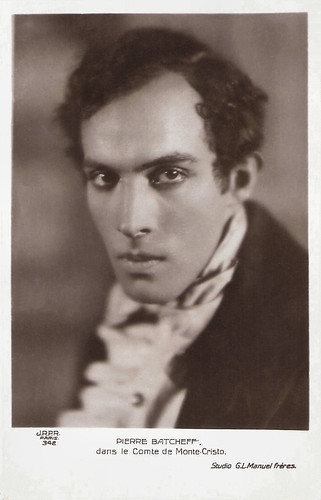
French postcard by J.R.P.R., Paris, no. 348. Photo: Studio G.L. Manuel Frères. Pierre Batcheff in Le Comte de Monte-Christo/Monte Cristo (Henri Fescourt, 1929).
Pierre Batcheff (1901-1932) was a French film actor who became famous for his part in the surrealist film Un Chien andalou (Luis Bunuel, Salvador Dali, 1929).
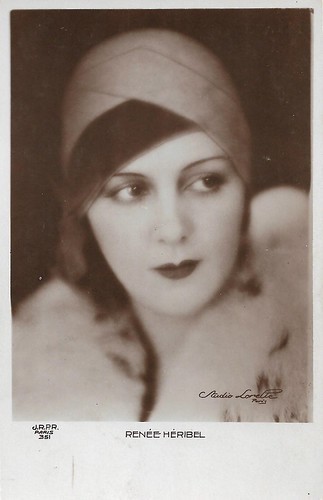
French postcard by J.R.P.R., Paris, no. 351. Photo: Studio Lorelle, Paris.
French actress Renée Héribel (1903-1952) knew to launch a short but impressive film career in the second half of the 1920s.
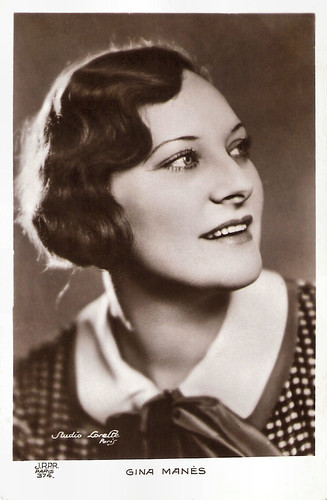
French postcard by J.R.P.R., Paris, no. 374. Photo: Studio Lorelle.
French actress Gina Manès (1893-1989) starred in some 90 films between 1916 and 1966. She is best known for the silent classics Coeur fidèle (1923) and Thérèse Raquin (1928).
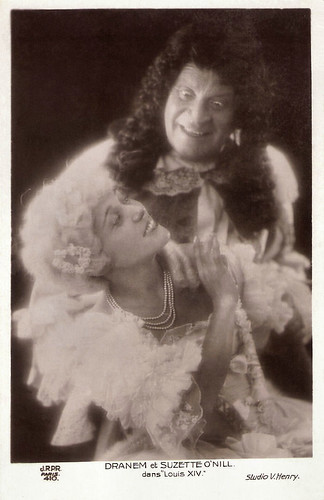
French postcard by J.R.P.R., Paris, no. 410. Photo: Studio V. Henry. Dranem and Suzette O'Nill in the stage operetta 'Louis XIV' (1929)
Dranem (1869-1935) was a French comic singer, music hall, stage and film actor.
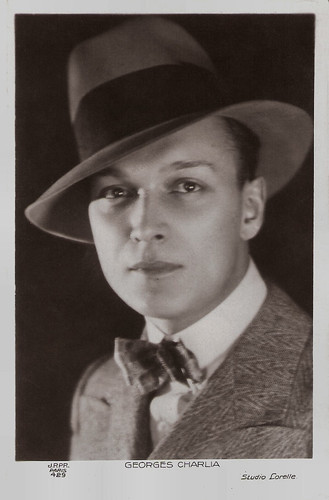
French postcard by J.R.P.R., Paris, no. 429. Photo: Studio Lorelle.
French actor Georges Charlia (1894-1984) played in 22 silent and sound films. He worked with such famous directors of the French avant-garde cinema as Germaine Dulac, Jean Epstein, and Alberto Cavalcanti.
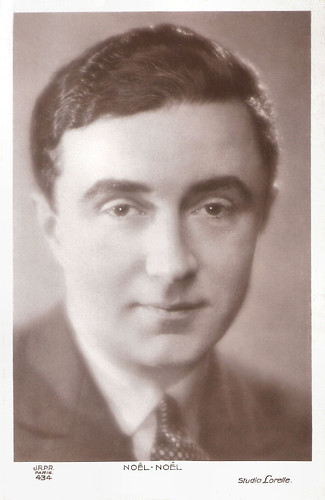
French postcard by J.R.P.R., Paris, no. 434. Photo: Studio Lorelle.
Noël-Noël (1897-1989) was a beloved French character actor and screenwriter. He appeared in 45 films between 1931 and 1966. His talents were diversified and he was known for his strong leftist political beliefs which seeped into many of his film scripts.
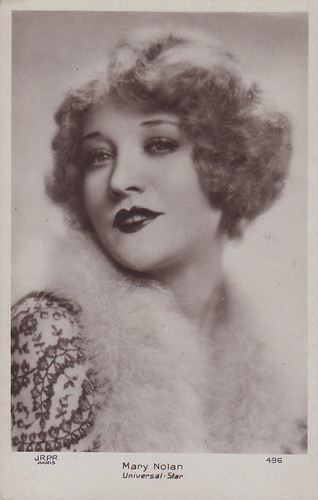
French postcard by J.R.P.R., Paris, no. 496. This is Betty Compson , not Mary Nolan . Collection: Marlene Pilaete.
Betty Compson (1897-1974) was an American actress and film producer. She peaked in silent cinema and early talkies and is best known for her performances as a suicidal prostitute rescued by a stoker (George Bancroft) in The Docks of New York (Joseph Von Sternberg, 1928), and as the manipulative carnival girl Carrie in the part-talkie The Barker (George Fitzmaurice, 1928), the latter earning a nomination for the Academy Award for Best Actress.
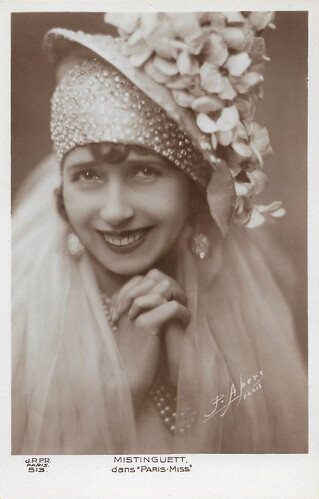
French postcard by J.R.P.R., Paris, no. 513. Photo: P. Apers. Mistinguett in the revue 'Paris Miss' at the Casino de Paris in 1930.
French actress and singer Mistinguett (1875-1956) captivated Paris with her risqué routines. She went on to become the most popular French entertainer of her time and the highest-paid female entertainer in the world. She appeared more than 60 times in the cinema.
Source: Rosspostcards.com.

French postcard by J.R.P.R., Paris, no. 60. Photo: First National. Gilbert Roland and Norma Talmadge in Camille (Fred Niblo, 1926).
Mexican-born American film star Gilbert Roland (1905–1994) was often cast in the typical 'Latin Lover' role during the silent era. Roland later played romantic lead roles in Spanish language adaptations of American films. In the mid-1940s, he featured in the popular film series around The Cisco Kid. Beginning in the 1940s, critics began to take notice of his acting and he was praised for his supporting roles in John Huston's We Were Strangers (1949), The Bad and the Beautiful (1952), and Cheyenne Autumn (1964). His last film appearance was in the Western Barbarosa (1984). Norma Talmadge (1894–1957) was an American actress and film producer of the silent era. A major box-office-draw for more than a decade, her career reached a peak in the early 1920s, when she ranked among the most popular idols of the American screen.

French postcard by J.R.P.R, Paris. no. 69. Photo: MGM. Carmel Myers and Ramon Novarro in Ben-Hur: A Tale of the Christ (Fred Niblo, 1925).
In Ben-Hur: A Tale of the Christ (Fred Niblo, 1925), silent film star Ramon Novarro plays the Jewish prince Judah Ben-Hur, who seeks to find his family and to revenge himself upon his childhood friend Messala (Francis X. Bushman) who had him wrongly imprisoned. A slip of brick during a Roman parade causes Judah to be sent off as a galley slave, his property confiscated and his mother (Claire McDowell) and sister imprisoned. Years later, as a result of his determination to stay alive and his willingness to aid his Roman master, Judah returns to his homeland an exalted and wealthy Roman athlete. Unable to find his mother and sister, and believing them dead, he can think of nothing else than revenge against Messala. Ramon Novarro was promoted by MGM as a 'Latin Lover' and became known as a sex symbol after the death of Rudolph Valentino. Ben-Hur was Novarro's greatest success. His revealing costumes caused a sensation.

French postcard by J.R.P.R., Paris, no. 80. Photo: G.L. Manuel Frères.
Henry Roussel (1875–1946), also known as Henry Roussell, was a French silent film actor, film director, and screenwriter best known for his silent films of the 1910s and 1920s. He starred in well over 40 films between 1912 and 1939 and directed such films as Visages voilés... âmes closes (1921), Les opprimés (1923), Violettes impériales/Imperial Violets (1924) and Paris' Girls (1929), while in the early 1910s he was a regular actor of the Eclair company, often directed by Maurice Tourneur, and later on had memorable parts in e.g. Les nouveaux messieurs (1929).

French postcard by J.R.P.R., Paris, no. 85. Photo: Studio V. Henry.
Little is known about Régina Dalthy, but her claim of fame is she played 'the other woman', the young marchioness Severo, in La sirène de tropiques (Mario Nalpas, Henri Étiévant, 1927), starring Josephine Baker and Pierre Batcheff. In the film her father, played by Georges Melchior, sends his daughter's fiancé to the tropics, plotting that he will never return. But young André (Batcheff) returns to Paris, followed by Papitou (Baker), a young black girl who saves his life and is secretly in love with him. Dalthy acted in three more films: the Brazilian silent comedy Augusto Aníbal Quer Casar (Luiz de Barros, 1923), La symphonie pathétique (1928), again directed by Nalpas and Etievant, and starring famous French boxer Georges Carpentier, and finally, the Franco-Spanish production La bodega (Benito Perojo, 1930), starring Gabriel Gabrio, Colette Darfeuil, and Enrique de Rivero, and shot in Andalucia and the Paris Pathé Natan studio.

French postcard by J.R.P.R., Paris, no. 86. Photo: V. Henry.
Italian actress Desdemona Mazza (1901-?) appeared in Italian and French silent films. She worked with such directors as Louis Mercanton, Julien Duvivier and Marcel L’Herbier.

French postcard by J.R.P.R., Paris, no. 100. Photo: Metro-Goldwyn. Betty Bronson as The Holy Virgin in Ben-Hur (Fred Niblo, 1925).
Betty Bronson (1906-1971) was personally selected by J.M. Barrie to star in Peter Pan (Herbert Brenon, 1924). It remains her most famous part, even if she had a small but significant part as The Holy Virgin Mary in Ben-Hur (Fred Niblo, 1925) and starred in the delicious but less popular A Kiss for Cinderella (1925), again directed by Brenon and again based on Barrie. In the early sound era, Bronson played in the Al Jolson films The Singing Fool (1929) and its sequel Sonny Boy (1929) and had the female lead in the Jack Benny movie, The Medicine Man (1930).

French postcard by J.R.P.R., Paris, no. 115. Photo: France-Film. Claude France in L'île d'amour/Island of Love (Berte Dagmar, Jean Durand, 1929).
Claude France (1893-1928) was a French actress of the 1920s. Two months before her greatest triumph opened in the cinemas, she committed suicide by opening the gas.

French postcard by J.R.P.R., Paris, no. 122. Photo: Erka Prodisco. Rod La Rocque in Braveheart (Alan Hale, 1925), which French release title was La barrière des races.
Rod La Rocque (1898-1969) was an American film actor between the 1910s and the 1930s. The dark-haired, tall actor often played the love interests of female stars, such as Pola Negri's in Ernst Lubitsch's drama Forbidden Paradise (1924).

French postcard by J.R.P.R., Paris, no. 151. Photo: G.L. Manuel Frères.
Spanish actress, singer, and diva Raquel Meller acted mainly in French silent films. She was already a highly popular singer before debuting as a film actress in 1919.

French postcard by J.R.P.R., Paris, no. 199. Jaque Catelain in Le marchand de plaisirs (Jaque Catelain, 1923). Photo: Sartony, Lafitte. This was one of two films Catelain directed himself, in addition to his prolific career as a silent film actor.
Jaque Catelain (1897-1965) was one of the most well-known faces of the French silent era. Catelain, also written Jaque-Catelain, Jacques Catelain and Jacque Cathelain, was originally named Jacques Guerin-Castelain.

French postcard by J.R.P.R., Paris, no. 207. Photo: Fox.
Good-looking American actor Charles Farrell (1900-1990) was a Hollywood matinée idol of the Jazz Age and Depression-era. He seems now forgotten, but between 1927 and 1934, he was very popular thanks to his teaming with Janet Gaynor in 12 screen romances, including 7th Heaven (1927), Street Angel (1928), and Lucky Star (1929). He retired from films in the early 1940s, but TV audiences of the 1950s would see him as Gale Storm's widower dad in the television series My Little Margie (1952-1955).

French postcard by J.R.P.R., Paris, no. 214. Photo: Metro-Goldwyn-Mayer.
Swedish Greta Garbo (1905-1990) was one of the greatest and most glamorous film stars ever produced by the Hollywood studio system. She was part of the Golden Age of the silent cinema of the 1920s and was one of the few actors who made a glorious transition to the talkies. She started her career in the European cinema and would always stay more popular in Europe than in the USA.

French postcard by J.R.P.R., Paris, no. 301. Ernst Van Duren in the French silent film Figaro (Gaston Ravel, 1929), based on the play by Beaumarchais. Van Duren played the title role. Location shooting was done at the Château de Rochefort-sur-Yvelines.
Little is known about French actor Ernst Van Duren aka Ernest van Duren aka Edmond Van Duren aka Van Duren (?-1930). The Dutch press at the time claimed he was Hungarian but of Dutch origin. What is known is that from 1921, he formed a famous dance couple with Edmonde Guy, the muse of the painter Kees van Dongen. He performed with her all over Europe and the US, where they were engaged by Florenz Ziegfeld for his 'Palm Beach Follies' (1926). Guy and Van Duren were known for their steamy performances and daring outfits. Van Duren was also known for his ephebic beauty, while his dance clearly had feminine aspects. Guy's sisters Christine and Marie were professional dancers too, known as The Guy Sisters, and often performed in choreographies by their brother Paul.

French postcard by J.R.P.R., Paris, no. 332. Photo: Max Munn Autrey / Fox. Victor McLaglen in What Price Glory (Raoul Walsh, 1926).
Victor McLaglen (1886-1959) was a Scottish boxer and World War I veteran who became a successful film actor. He started in British silent films, and later became a popular character actor in Hollywood, with a particular knack for playing drunks.

French postcard by J.R.P.R., no. 336. Photo: Studio Lorelle (Lucien Lorelle), Paris. Brigitte Helm in L'Argent/The Money (Marcel L'Herbier, 1928).

French postcard by J.R.P.R., no. 337. Photo: Studio Lorelle, Paris. Brigitte Helm in L'Argent/The Money (Marcel L'Herbier, 1928).

French postcard by J.R.P.R., no. 338. Photo: Studio Lorelle, Paris. Brigitte Helm in L'Argent/The Money (Marcel L'Herbier, 1928).
German actress Brigitte Helm (1908-1996) is still famous for her dual role as Maria and her double the evil Maria, the Maschinenmensch, in the silent SF classic Metropolis (Fritz Lang, 1927). After Metropolis she made a string of over 30 films in which she almost always had the starring role. She easily made the transition to sound films, before she abruptly retired in 1935.

French postcard by J.R.P.R., Paris, no. 344. Pierre Alcover in L'Argent (Marcel L'Herbier, 1928). Photo: Studio G.L. Manuel Frères.
Pierre Alcover (1893-1957) knew a remarkable career from warehouseman at Les Halles in Paris to top actor, often playing bad guys, such as the head spy in La chèvre aux pieds d'or (Jacques Robert, 1925) and the scheming banker in L'Argent (1928) by Marcel L'Herbier, but also law enforcers such as police officers and wardens, e.g. Criminel (1933), or simple men such as the ambitious new pilot on a barge in L'Hirondelle et la mesange (André Antoine, 1924), and the violent but good-hearted convict in La petite Lise (Jean Grémillon 1930). Guy Bellinger on IMDb : "On the silver screen, his imposing stature and his gruff tone predisposed him to violent roles, on either side of the law. [...] Anyway, whether a lawbreaker or a law enforcer, Pierre Alcover brought the same conviction (no pun intended) to the role he was given to play. One of the great character actors of the 1920s and 1930s."

French postcard by J.R.P.R., Paris, no. 348. Photo: Studio G.L. Manuel Frères. Pierre Batcheff in Le Comte de Monte-Christo/Monte Cristo (Henri Fescourt, 1929).
Pierre Batcheff (1901-1932) was a French film actor who became famous for his part in the surrealist film Un Chien andalou (Luis Bunuel, Salvador Dali, 1929).

French postcard by J.R.P.R., Paris, no. 351. Photo: Studio Lorelle, Paris.
French actress Renée Héribel (1903-1952) knew to launch a short but impressive film career in the second half of the 1920s.

French postcard by J.R.P.R., Paris, no. 374. Photo: Studio Lorelle.
French actress Gina Manès (1893-1989) starred in some 90 films between 1916 and 1966. She is best known for the silent classics Coeur fidèle (1923) and Thérèse Raquin (1928).

French postcard by J.R.P.R., Paris, no. 410. Photo: Studio V. Henry. Dranem and Suzette O'Nill in the stage operetta 'Louis XIV' (1929)
Dranem (1869-1935) was a French comic singer, music hall, stage and film actor.

French postcard by J.R.P.R., Paris, no. 429. Photo: Studio Lorelle.
French actor Georges Charlia (1894-1984) played in 22 silent and sound films. He worked with such famous directors of the French avant-garde cinema as Germaine Dulac, Jean Epstein, and Alberto Cavalcanti.

French postcard by J.R.P.R., Paris, no. 434. Photo: Studio Lorelle.
Noël-Noël (1897-1989) was a beloved French character actor and screenwriter. He appeared in 45 films between 1931 and 1966. His talents were diversified and he was known for his strong leftist political beliefs which seeped into many of his film scripts.

French postcard by J.R.P.R., Paris, no. 496. This is Betty Compson , not Mary Nolan . Collection: Marlene Pilaete.
Betty Compson (1897-1974) was an American actress and film producer. She peaked in silent cinema and early talkies and is best known for her performances as a suicidal prostitute rescued by a stoker (George Bancroft) in The Docks of New York (Joseph Von Sternberg, 1928), and as the manipulative carnival girl Carrie in the part-talkie The Barker (George Fitzmaurice, 1928), the latter earning a nomination for the Academy Award for Best Actress.

French postcard by J.R.P.R., Paris, no. 513. Photo: P. Apers. Mistinguett in the revue 'Paris Miss' at the Casino de Paris in 1930.
French actress and singer Mistinguett (1875-1956) captivated Paris with her risqué routines. She went on to become the most popular French entertainer of her time and the highest-paid female entertainer in the world. She appeared more than 60 times in the cinema.
Source: Rosspostcards.com.
Published on June 12, 2020 22:00
June 11, 2020
Eleanor Boardman
Eleanor Boardman (1898-1991) was an American stage and screen actress, famous for the silent classic The Crowd (1928), directed by her husband King Vidor.
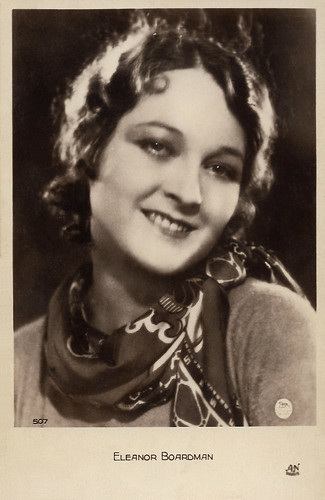
French postcard by A.N., Paris, no. 507. Photo: Metro-Goldwyn-Film.
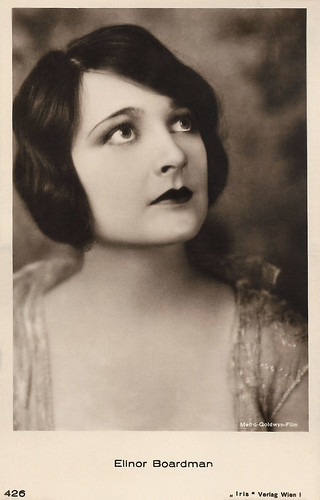
Austrian postcard by Iris Verlag, Wien, no. 426. Photo: Metro-Goldwyn-Film.
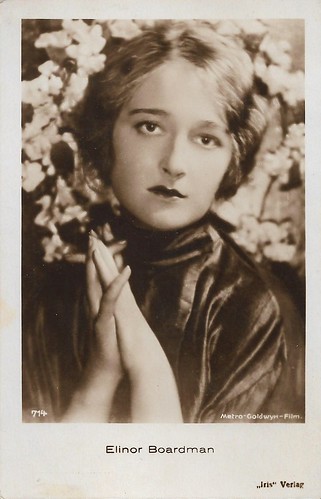
Austrian postcard by Iris Verlag, Wien, no. 714. Photo: Metro-Goldwyn-Film. The first name of Boardman is misspelled.
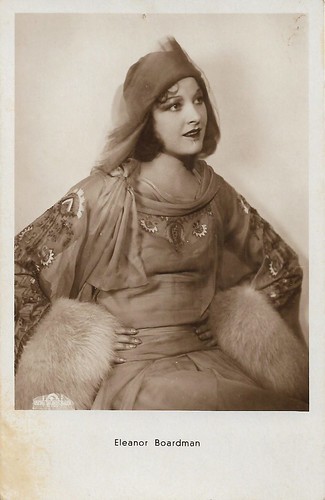
Austrian postcard by Iris Verlag, no. 6115. Photo: Metro-Goldwyn-Mayer.
The New Face of 1922
Eleanor Boardman was born in Philadelphia, Illinois, in 1898. She always wanted to be an actress, and as soon as she graduated from Philadelphia's Academy of Fine Arts, she headed for New York to conquer Broadway. An attempt to become a stage actress came to naught when Eleanor came down with laryngitis.
When Broadway proved not quite ready to be conquered yet, she took whatever jobs she could find. She became a photographer's model. Her best work was as 'The Eastman Kodak Girl' for the Eastman company in the late 1910s. In that capacity she heard that the Selwyn Organisation, a major producer of Broadway plays, was looking for girls with no stage experience. Since she was more than qualified in that respect, she tried out for the job and before she knew it she was in the chorus line of 'Rock-a-Bye-Baby' until the show closed three months later.
She then got a job in another Selwyn production, 'A Very Good Young Man', but that show closed not long after opening. It was at this time that a casting director for Goldwyn Pictures hit the Broadway scene looking for new faces. She tested for him and impressed him enough that he finally picked her out of a pool of more than 1000 young girls who tested for the opportunity to go to Hollywood. She was chosen by Goldwyn Pictures as their 'New Face of 1922', through which she signed a contract with the company.
After several successful supporting roles, she played the lead in Rupert Hughes' Souls for Sale (1923), also with Frank Mayo, Richard Dix , and Lew Cody. Boardman plays a runaway wife who ends up in Hollywood and from an extra becomes a star. Her husband (Cody), apparently a dangerous robber and killer of wives, pursues her. The film gives an insight view of Hollywood and many silent stars had cameos in the film.
That same year, Boardman's growing popularity was reflected by her inclusion on the list of WAMPAS Baby Stars. When Goldwyn was absorbed into MGM, Boardman became one of that studio's earliest, busiest and most popular leading ladies.
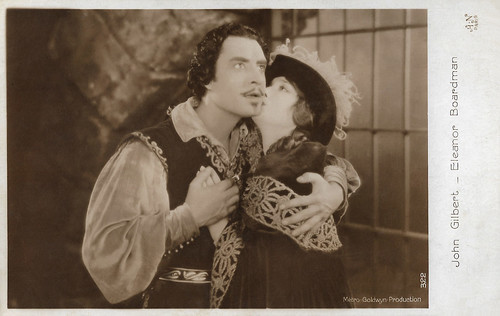
French postcard by A.N., Paris, no. 322. Photo: Metro-Goldwyn-Production. John Gilbert and Eleanor Boardman in Bardelys the Magnificent (King Vidor, 1926).
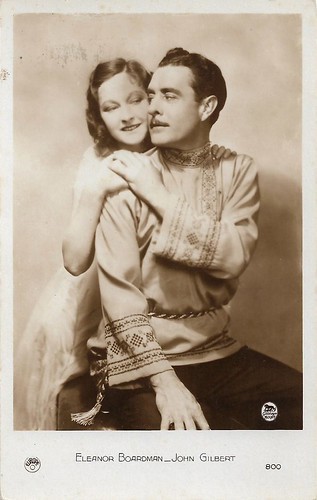
French postcard by Europe, no. 800. Photo: Metro-Goldwyn-Mayer. John Gilbert and Eleanor Boardman in Redemption (Fred Niblo, 1930).
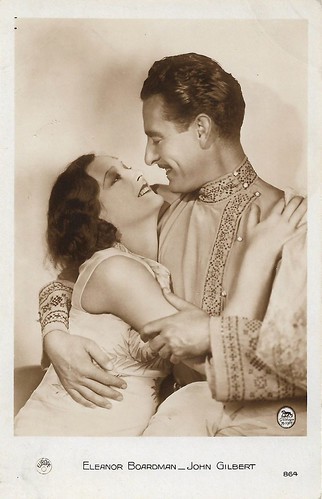
French postcard by Europe, no. 864. Photo: Metro-Goldwyn-Mayer. John Gilbert and Eleanor Boardman in Redemption (Fred Niblo, 1930).
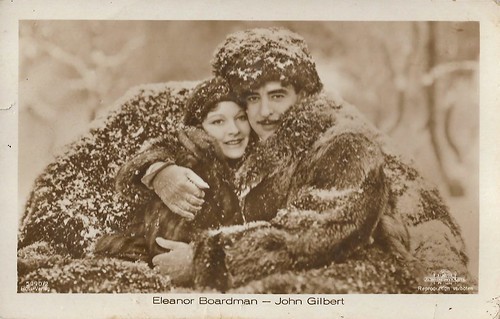
German postcard by Ross Verlag, Berlin, no. 5090/2. Photo: Metro-Goldwyn-Mayer. Eleanor Boardman and John Gilbert in the early sound film Redemption (Fred Niblo, 1930).
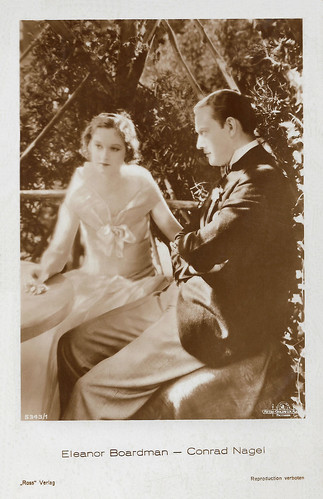
German postcard by Ross Verlag, Berlin, no. 5343/1, 1930-1931. Photo: MGM. Eleanor Boardman and Conrad Nagel in The Only Thing (1925).
King Vidor
Eleanor Boardman appeared in more than 30 films during her career, achieving her greatest success in director King Vidor's The Crowd (1928). Hal Erickson at AllMovie : "customed to glamourous, sophisticated roles, Eleanor balked when she was asked in 1928 by then-husband King Vidor to appear as the plain, tenement dwelling housewife in Vidor's The Crowd. She acceded to his wishes, and the result was one of the actress' finest performances (and certainly her most memorable)."
Other memorable titles were e.g. The Circle (Frank Borzage, 1925), Bardelys the Magnificent (King Vidor, 1926) with John Gilbert , and Tell It to the Marines (George W. Hill, 1926) with William Haines and Lon Chaney .
She managed to survive the switchover to sound films with good roles in such films as The Great Meadow (Charles Brabin, 1931) and The Squaw Man (Cecil B. DeMille, 1931) featuring Warner Baxter, but her MGM contract was terminated as the result of an economy drive. Boardman retired from acting in 1935 and retreated from Hollywood. Her only subsequent appearance was in an interview filmed for Kevin Brownlow and David Gill's British documentary series Hollywood (1980).
From 1926 to 1931, Eleanor Boardman was married to King Vidor and she had two daughters, Antonia (1927-2012) and Belinda (1930), with him. She and Vidor were scheduled to be married at a double ceremony with John Gilbert and Greta Garbo . Garbo got cold feet and did not show up. Boardman and Vidor did get married at the home of Marion Davies , who gave the bride away.
After her retirement, she moved to Europe, where she married director Harry d'Abbadie d'Arrast in 1940. He had directed her final film, the multinational (and multilingual) d'Arrast project The Three-Cornered Hat (Harry d'Abbadie d'Arrast, 1935) with Victor Varconi . After the war, she divided her time between the United States and their chateau in the Pyrenees Mountains. After her husband's death in 1968, she permanently relocated back to the United States, where she settled into Montecito, an upper-class suburb of San Bernardino, California, living in a house she designed.
Eleanor Boardman died in her sleep at her home in 1991, at the age of 93. Her ashes were scattered in Santa Barbara near her home. After her death, she was profiled in 'Speaking of Silents: First Ladies of the Screen' by William Drew in 1997. For her contributions to the film industry, Boardman has a motion pictures star on the Hollywood Walk of Fame. Her star is located at 6928 Hollywood Boulevard.
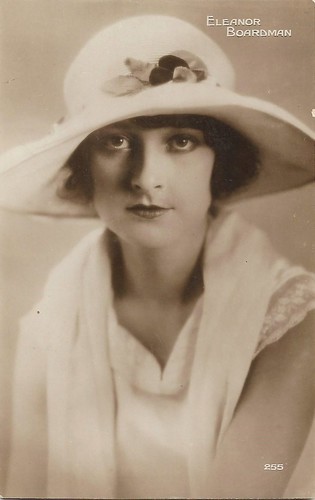
French postcard by Editions Cinémagazine, no. 255.
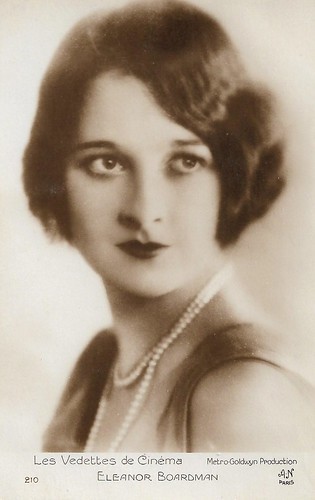
French postcard in the Les vedettes de cinéma series by A.N., Paris, no. 210. Photo: Metro Goldwyn Production.
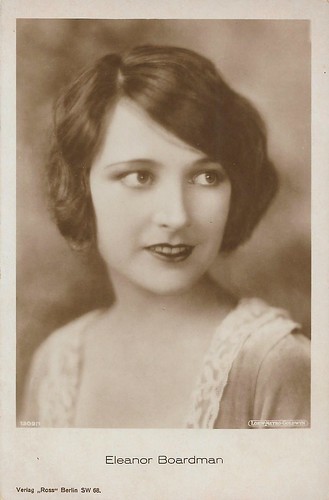
German postcard by Ross Verlag, Berlin, no. 1309/1, 1927-1928. Photo: Loew-Metro-Goldwyn. It was in 1924 that Marcus Loew who already owed Metro Pictures bought the company Goldwyn Pictures. In 1925 the company would be named Metro-Goldwyn-Mayer. So this photo may date of 1924.
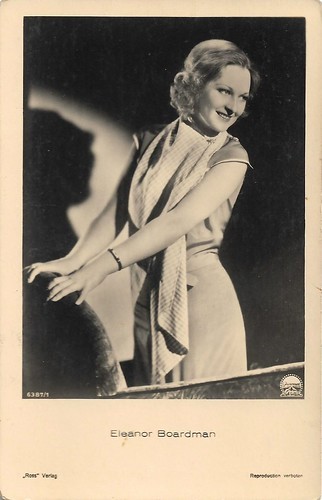
German postcard by Ross Verlag, Berlin, no. 6387/1, 1931-1932. Photo: Paramount. The only early 1930s Paramount film in which Eleanor Boardman acted was Women Love Once (Edward Goodman, 1931) with Paul Lukas and herself in the leads.
Three Reasons: The Crowd. Source: Robert Nishimura (YouTube).
Source: Hal Erickson (AllMovie), Wikipedia and .

French postcard by A.N., Paris, no. 507. Photo: Metro-Goldwyn-Film.

Austrian postcard by Iris Verlag, Wien, no. 426. Photo: Metro-Goldwyn-Film.

Austrian postcard by Iris Verlag, Wien, no. 714. Photo: Metro-Goldwyn-Film. The first name of Boardman is misspelled.

Austrian postcard by Iris Verlag, no. 6115. Photo: Metro-Goldwyn-Mayer.
The New Face of 1922
Eleanor Boardman was born in Philadelphia, Illinois, in 1898. She always wanted to be an actress, and as soon as she graduated from Philadelphia's Academy of Fine Arts, she headed for New York to conquer Broadway. An attempt to become a stage actress came to naught when Eleanor came down with laryngitis.
When Broadway proved not quite ready to be conquered yet, she took whatever jobs she could find. She became a photographer's model. Her best work was as 'The Eastman Kodak Girl' for the Eastman company in the late 1910s. In that capacity she heard that the Selwyn Organisation, a major producer of Broadway plays, was looking for girls with no stage experience. Since she was more than qualified in that respect, she tried out for the job and before she knew it she was in the chorus line of 'Rock-a-Bye-Baby' until the show closed three months later.
She then got a job in another Selwyn production, 'A Very Good Young Man', but that show closed not long after opening. It was at this time that a casting director for Goldwyn Pictures hit the Broadway scene looking for new faces. She tested for him and impressed him enough that he finally picked her out of a pool of more than 1000 young girls who tested for the opportunity to go to Hollywood. She was chosen by Goldwyn Pictures as their 'New Face of 1922', through which she signed a contract with the company.
After several successful supporting roles, she played the lead in Rupert Hughes' Souls for Sale (1923), also with Frank Mayo, Richard Dix , and Lew Cody. Boardman plays a runaway wife who ends up in Hollywood and from an extra becomes a star. Her husband (Cody), apparently a dangerous robber and killer of wives, pursues her. The film gives an insight view of Hollywood and many silent stars had cameos in the film.
That same year, Boardman's growing popularity was reflected by her inclusion on the list of WAMPAS Baby Stars. When Goldwyn was absorbed into MGM, Boardman became one of that studio's earliest, busiest and most popular leading ladies.

French postcard by A.N., Paris, no. 322. Photo: Metro-Goldwyn-Production. John Gilbert and Eleanor Boardman in Bardelys the Magnificent (King Vidor, 1926).

French postcard by Europe, no. 800. Photo: Metro-Goldwyn-Mayer. John Gilbert and Eleanor Boardman in Redemption (Fred Niblo, 1930).

French postcard by Europe, no. 864. Photo: Metro-Goldwyn-Mayer. John Gilbert and Eleanor Boardman in Redemption (Fred Niblo, 1930).

German postcard by Ross Verlag, Berlin, no. 5090/2. Photo: Metro-Goldwyn-Mayer. Eleanor Boardman and John Gilbert in the early sound film Redemption (Fred Niblo, 1930).

German postcard by Ross Verlag, Berlin, no. 5343/1, 1930-1931. Photo: MGM. Eleanor Boardman and Conrad Nagel in The Only Thing (1925).
King Vidor
Eleanor Boardman appeared in more than 30 films during her career, achieving her greatest success in director King Vidor's The Crowd (1928). Hal Erickson at AllMovie : "customed to glamourous, sophisticated roles, Eleanor balked when she was asked in 1928 by then-husband King Vidor to appear as the plain, tenement dwelling housewife in Vidor's The Crowd. She acceded to his wishes, and the result was one of the actress' finest performances (and certainly her most memorable)."
Other memorable titles were e.g. The Circle (Frank Borzage, 1925), Bardelys the Magnificent (King Vidor, 1926) with John Gilbert , and Tell It to the Marines (George W. Hill, 1926) with William Haines and Lon Chaney .
She managed to survive the switchover to sound films with good roles in such films as The Great Meadow (Charles Brabin, 1931) and The Squaw Man (Cecil B. DeMille, 1931) featuring Warner Baxter, but her MGM contract was terminated as the result of an economy drive. Boardman retired from acting in 1935 and retreated from Hollywood. Her only subsequent appearance was in an interview filmed for Kevin Brownlow and David Gill's British documentary series Hollywood (1980).
From 1926 to 1931, Eleanor Boardman was married to King Vidor and she had two daughters, Antonia (1927-2012) and Belinda (1930), with him. She and Vidor were scheduled to be married at a double ceremony with John Gilbert and Greta Garbo . Garbo got cold feet and did not show up. Boardman and Vidor did get married at the home of Marion Davies , who gave the bride away.
After her retirement, she moved to Europe, where she married director Harry d'Abbadie d'Arrast in 1940. He had directed her final film, the multinational (and multilingual) d'Arrast project The Three-Cornered Hat (Harry d'Abbadie d'Arrast, 1935) with Victor Varconi . After the war, she divided her time between the United States and their chateau in the Pyrenees Mountains. After her husband's death in 1968, she permanently relocated back to the United States, where she settled into Montecito, an upper-class suburb of San Bernardino, California, living in a house she designed.
Eleanor Boardman died in her sleep at her home in 1991, at the age of 93. Her ashes were scattered in Santa Barbara near her home. After her death, she was profiled in 'Speaking of Silents: First Ladies of the Screen' by William Drew in 1997. For her contributions to the film industry, Boardman has a motion pictures star on the Hollywood Walk of Fame. Her star is located at 6928 Hollywood Boulevard.

French postcard by Editions Cinémagazine, no. 255.

French postcard in the Les vedettes de cinéma series by A.N., Paris, no. 210. Photo: Metro Goldwyn Production.

German postcard by Ross Verlag, Berlin, no. 1309/1, 1927-1928. Photo: Loew-Metro-Goldwyn. It was in 1924 that Marcus Loew who already owed Metro Pictures bought the company Goldwyn Pictures. In 1925 the company would be named Metro-Goldwyn-Mayer. So this photo may date of 1924.

German postcard by Ross Verlag, Berlin, no. 6387/1, 1931-1932. Photo: Paramount. The only early 1930s Paramount film in which Eleanor Boardman acted was Women Love Once (Edward Goodman, 1931) with Paul Lukas and herself in the leads.
Three Reasons: The Crowd. Source: Robert Nishimura (YouTube).
Source: Hal Erickson (AllMovie), Wikipedia and .
Published on June 11, 2020 22:00
June 10, 2020
Photo by Atelier Jacobi
Atelier Jacobi was a Berlin film studio, which made numerous film star photos for Ross Verlag postcards. The Jacobi family had the most famous portrait-photography business in Germany, with studios in Thorn, Poznan, and Berlin. The main photographer of the studio during the late 1920s and early 1930s was Lotte Jacobi (1896–1990) who was the fourth generation of the photographer family Jacobi. She captured the heady spirit of the Weimar Republic, particularly the intellectual and artistic elite who lived in Berlin or passed through it, before Lotte fled the Nazis in 1935.
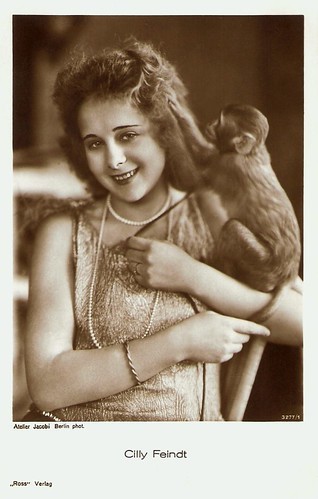
German postcard by Ross Verlag, Berlin, no. 3277/1, 1928-1929. Photo: Atelier Jacobi, Berlin.
The tiny, dainty blonde Cilly Feindt (1909-1999) was a German star of the circus ring. In her heyday, she was regarded as one of the finest Haute Ecole horse riders of her time.
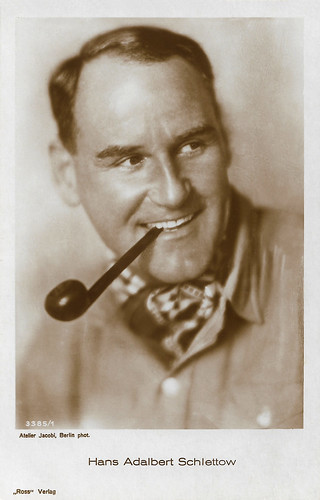
German postcard by Ross Verlag, no. 3385/1, 1928-1929. Photo: Atelier Jacobi, Berlin.
German actor Hans Adalbert Schlettow (1887-1945) appeared between 1917 and 1945 in about 150 German films. He played sinister characters in some masterpieces of the German silent cinema, but in real life, Schlettow proved to be a sinister character as well.
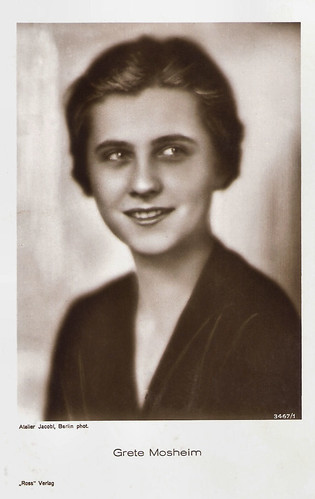
German postcard by Ross Verlag, no. 3467/1, 1928-1929. Photo: Atelier Jacobi, Berlin.
Grete Mosheim (1905-1986) was a German film, theatre and television actress of Hungarian Jewish ancestry. In the late 1920s and early 1930s, she was a star in German cinema.

German postcard by Ross Verlag, no. 3751/1, 1928-1929. Photo: Atelier Jacobi, Berlin.
Austrian actor Fred Louis Lerch (1902-1985) was a handsome star of the Weimar cinema. In the 1950s, he would work again for German films as a production manager.
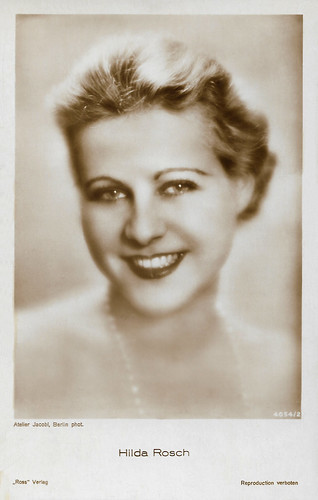
German postcard by Ross Verlag, no. 4054/2, 1929-1930. Photo: Atelier Jacobi, Berlin.
German actress Hilda Rosch only appeared in eight films between 1928 and 1931.
A family of photographers
Lotte Jacobi came from a German Jewish family of photographers. Her great-grandfather Samuel Jacobi had reportedly been an apprentice to Louis Daguerre, the photographic pioneer who invented the Daguerreotype process. Samuel, who had been a glazier, founded a photographic studio in the 1840s.
Lotte and her less-known sister Ruth Jacobi (1899-1995) were the daughters of Samuel's grandson Sigismund Jacobi and his wife Mia Jacobi née Lublinski.
From 1920, Ruth Jacobi learned her craft in the photography school of the Lette-Verein photographic school for women in Berlin, then worked for five years in her family's new photo studio at Joachimstaler Strasse 5, later Kurfürstendamm, in Berlin.
Ruth moved to New York in 1928, joining her husband, Hans Richter, whom she had married two years earlier. There she lived and photographed the Jews in the Lower East Side. Returning to Europe in the early 1930s, she divorced Richter in 1933 and then married the Hungarian physician Maurus Roth in Budapest.
The Jacobi-Roth couple emigrated to the USA in 1935. There they lived in Queens. Ruth and her sister Lotte opened a photo studio in New York. During Ruth Jacobi's lifetime, there were no exhibitions of her pictures; however, some have been published.
The dust jacket of Michael Gold’s best-selling novel 'Jews Without Money' (1930) showed one of her pictures. Between 1937 and 1939 she was able to publish several pictures in Popular Photography. Some of her portraits of Albert Einstein were used in a biography of the scientist in 1939 and 'U.S. Camera 1940', an illustrated book on the centenary of photography also featured a photograph by Ruth Jacobi-Roth.
Ruth abandoned the craft of photography for which her sister, Lotte Jacobi, became famous, and spent decades living quietly as a doctor’s wife in Astoria, Queens. Ruth died in 1995 and had no children. Her photos and negatives lay in storage with a relative in Mission Viejo, Calif.
In 2004, archivist Aubrey Pomerance learned of the trove of photographs by the lesser-known Ms. Jacobi. Pomerance was the chief archivist at the Jewish Museum Berlin. Pomerance arranged for the Jewish Museum Berlin to acquire much of the collection - some 800 prints and 3,000 negatives - in 2005. And after years of research and preparation, he mounted an exhibition of around 70 images, 'Ruth Jacobi: Photographs', in 2009 in Berlin.
Sewell Chan in The New York Times in 2009: "I was struck by Ruth Jacobi’s images on a recent vacation in Berlin during a visit to the museum, which was designed by Daniel Libeskind and opened in September 2001 (two days before the 9/11 attacks). The works evoked other famous images of early 20th-century life on the Lower East Side — like those made by Helen Levitt and Rebecca Lepkoff — but with a different sensibility and mood."
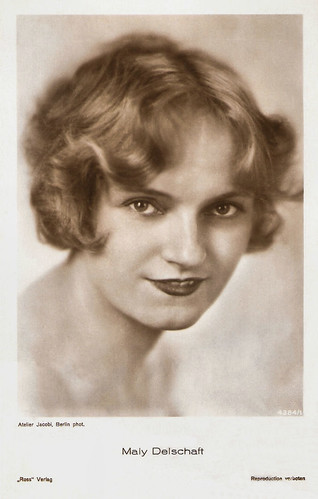
German postcard by Ross Verlag, no. 4384/1, 1929-1930. Photo: Atelier Jacobi, Berlin.
Forgotten diva Maly Delschaft (1898-1995) began her career in the theatre and then became a star in the German silent cinema. During the Nazi era, she appeared mainly in supporting roles. After the Second World War, she worked in East Germany for the state-controlled DEFA studio.
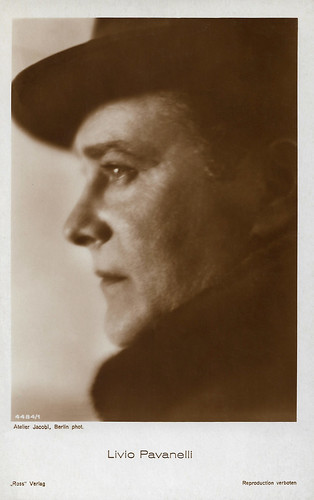
German postcard by Ross Verlag, no. 4484/1, 1929-1930. Photo: Atelier Jacobi, Berlin.
Livio Pavanelli (1881-1958) was an Italian actor of the Italian and in particular German silent cinema. He also worked in Italian sound cinema as an actor and as a production manager. He directed four Italian films, both in the silent and the sound era.
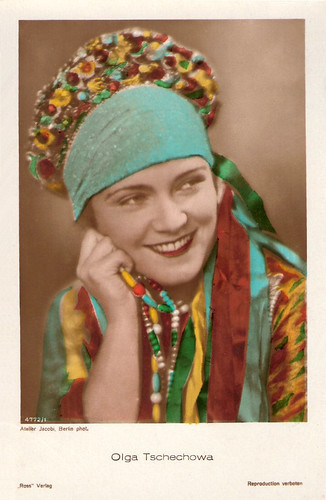
German postcard by Ross Verlag, no. 4772/1, 1929-1930. Photo: Atelier Jacobi, Berlin.
Dignified German-Russian actress Olga Tschechova (1897-1980) was one of the most popular stars of the silent film era. She remained a mysterious person throughout her life and was reportedly a Russian agent in Nazi Germany.
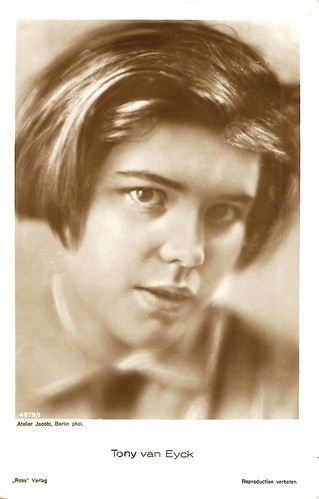
German postcard. Ross Verlag, no. 4879/1, 1929-1930. Photo: Atelier Jacobi, Berlin.
German actress Toni van Eyck (1910-1988) became a star playing a rape victim in the Aufklärungsfilm Gefahren der Liebe/Hazards of Love (1931). Despite this film's success, she stayed primarily a stage actress.
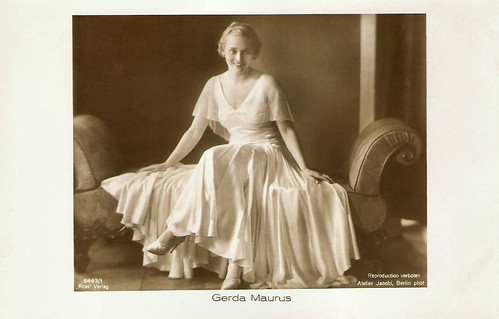
German postcard by Ross Verlag, no. 5463/1, 1930-1931. Photo: Atelier Jacobi, Berlin.
Austrian actress Gerda Maurus (1903-1968) was a star of the silent screen. With her protruded cheekbones and her forceful look, she bewitched many men, including her director Fritz Lang and Nazi Minister Josef Goebbels.
My style is the style of the people I photograph
Johanna Alexandra Jacobi was born in 1895 in Thorn, West Prussia (now Torun, Poland). She was the eldest of three children. The name "Lotte" was a nickname given to her by her father. She began her photographic career at 14, documenting the world around her with a homemade pinhole camera.
In 1916 she married Fritz Honig, and a year later she gave birth to a son, John Frank. The marriage did not last, and in 1924 they divorced. In 1925, she joined her parents and her sister, Ruth, in Berlin, where the family had moved in 1921.
From 1925 till 1927, she attended the Bavarian State Academy of Photography and studied art history at the University of Munich. Lotte was in her early thirties when she finished her studies. Jacobi entered the family photography business in 1927. Following an apprenticeship with her father, she became the director of Atelier Jacobi. During this same period, she began her professional career as a photographer, represented by Agentur Schostal (Schostal Photo Agency) and she also produced four films, the most important being Portrait of the Artist, a study of Josef Scharl.
She was equipped for the job not only by talent but by temperament. An emancipated woman with a leftist political slant, she had an inquiring approach and a knack for bringing subjects to her lens. Her subjects were the arts, theatre, film, and dance. Her aim was to capture each sitter's individuality. "In making portraits, I refuse to photograph myself," she said. "My style is the style of the people I photograph."
One of her famous subjects was Peter Lorre . She was allowed only one image, and it turned out to be a classic, with Lorre shot as close up as possible. She captured his villainous look but softened the angle by shooting from above.
Her interest in modern dance led her to take photos of dancers in action, aided by her own quickness and new camera technology. Her now-classic photographs of Lotte Lenya holding a cigarette, Emil Jannings casually peeling an apple, and the dancer Claire Bauroff captured the essence of Berlin theatre life.
In 1932 her leftist sympathies led her to do a series of Ernst Thalmann, the Communist candidate that year against Hitler. From October 1932 to January 1933, she made a long trip to the Soviet Union which resulted in rare and interesting shots of street scenes in Moscow and the republics of Tajikistan and Uzbekistan.
She returned to Berlin in February 1933, one month after Hitler came to power. The Nazis questioned her about her trip, her political sympathies, and her Jewish background. After her father's death, Jacobi took on ownership of the Atelier Jacobi with a non-Jewish business partner, Alexander Bender, hoping to avoid Aryanisation. However, Bender did not meet the race law requirements and the studio is threatened with expulsion from the Reichspressekammer. In September 1935, she finally left Germany together with her son.
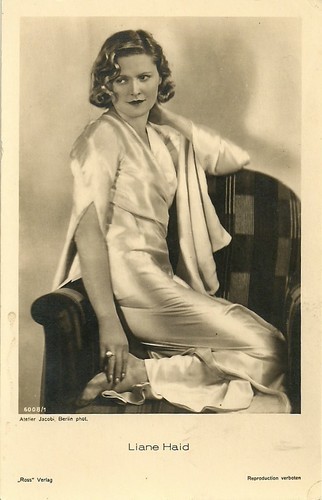
German postcard by Ross Verlag, no. 6008/1, 1931-1932. Photo: Atelier Jacobi, Berlin.
Prima ballerina, dancer, singer and actress Liane Haid (1895-2000) was the first film star of Austria. She was the epitome of the Süßes Wiener Mädel (Sweet Viennese Girl) and from the mid-1910s on she made close to a hundred films.
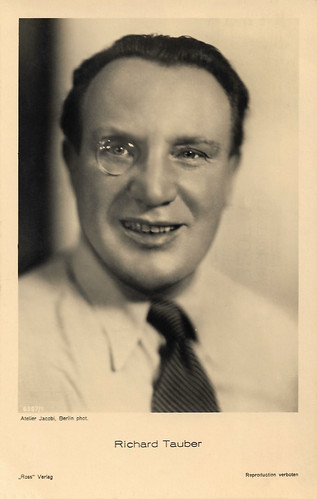
German postcard by Ross Verlag, no. 6307/1, 1931-1932. Photo: Atelier Jacobi, Berlin.
Austrian opera singer Richard Tauber (1891-1948) was one of the world's finest Mozartian tenors of the 20th century. Some critics commented that "his heart felt every word he sang". He also tested the then-new talking pictures in such popular musical films as Ich küsse Ihre Hand, Madame (1929) with Marlene Dietrich, Das Land des Lächelns (1930) and Melodie der Liebe (1932).
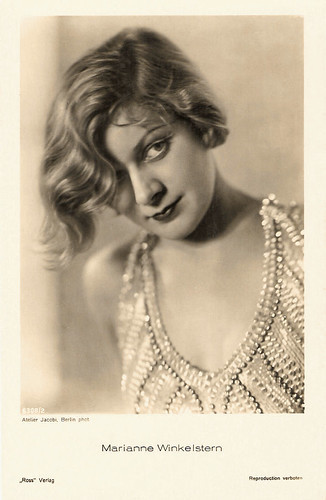
German postcard by Ross Verlag, no. 6308/2, 1931-1932. Photo: Atelier Jacobi, Berlin.
German actress Marianne Winkelstern (1910-1966) became well known as a ballerina in Germany and England. In Germany, she appeared in some silent films and early sound films.
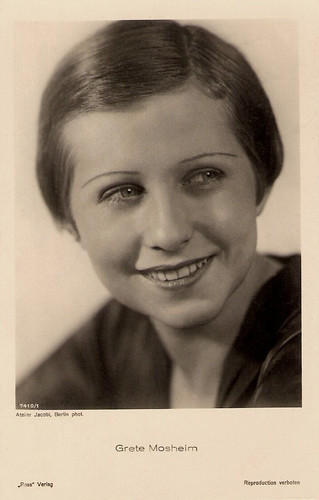
German postcard by Verlag Ross, Berlin, no. 7410/1, 1932-1933. Photo: Atelier Jacobi, Berlin.
Margaret 'Grete' Mosheim (1905-1986) was a German film, theatre and television actress of Hungarian Jewish ancestry. In the late 1920s and early 1930s, she was a star of the Weimar cinema.
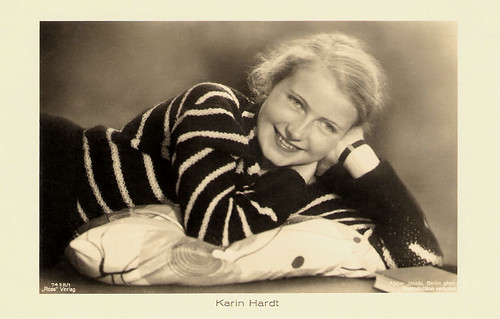
German postcard by Ross Verlag, no. 7438/1, 1932-1933. Photo: Atelier Jacobi, Berlin.
German actress Karin Hardt (1910-1992) made her cinema debut as a pure and disarmingly natural backfisch, looking for happiness. Her impressive career with many film, theatre, and television appearances lasted for six decades.
A dreamy Einstein, in a rumpled leather jacket, hair askew
Lotte Jacobi arrived in September 1935 in New York City. With her sister Ruth Jacobi Roth, she opened a studio in Manhattan, but Lotte struggled to find work. An important American contact was Albert Einstein, whom she and her family had photographed in Germany.
He agreed to work with her when, in 1938, Life magazine commissioned a photo essay on the scientist. She made several informal photographs at Einstein's home in Princeton, N.J., in conversations with his students, but Life felt they were too casual and decided not to publish them.
However, in 1942, the magazine U.S. Camera, at the instigation of Edward Steichen, published a photo of a dreamy Einstein, in a rumpled leather jacket, hair askew, that became one of the most famous images of him.
In the 1940s Jacobi explored the technique of photogenics, expressive abstract images made by drawing with a flashlight on photographic paper. The process had been extensively explored in the early 20th century by Man Ray and Laszlo Moholy-Nagy.
In 1940, in New York, she married her second husband (she and her first husband had divorced), Erich Reiss, a German avant-garde publisher and writer, who was rescued from a Nazi death camp. He died in 1951.
In 1955, Jacobi left New York with her son and daughter-in-law and moved to Deering, New Hampshire, a move that changed her life. There she opened a new studio and served as a mentor to younger artists for 30 years. She continued her interest in the forms of nature, taking pictures of snow, water, and other phenomena in the countryside.
She remained active as a portrait photographer, developing a new set of subjects and friends, including the poets Robert Frost and May Sarton, the ecological activists Helen and Scott Nearing, and a fellow photographer, Paul Caponigro. Among her other notable portraits – all in black and white – were those of the dramatist Kurt Weill, Eleanor Roosevelt, Marc Chagall, and the musician Pablo Casals.
Lotte Jacobi passed away in 1990 at the age of 93. She bequeathed a collection of 47,000 negatives to the University of New Hampshire. Her earlier work was lost to the Nazis, but this post offers a glimpse of the film star portraits she took in Berlin.
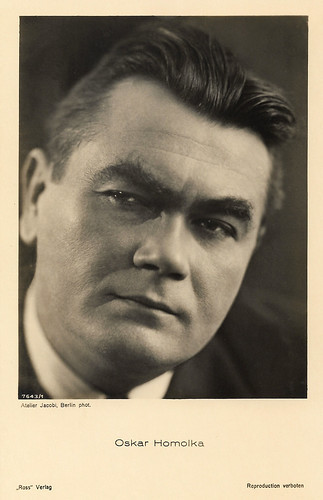
German postcard by Ross Verlag, no. 7643/1, 1932-1933. Photo: Atelier Jacobi, Berlin.
Austrian film and theatre actor Oskar Homolka (1898-1978) had a stocky appearance, bushy eyebrows and a rather Slavic-sounding name, which led many to believe he was Eastern European or Russian. His expressive face predestined him to play character roles as a scoundrel, pimp or communist spy.
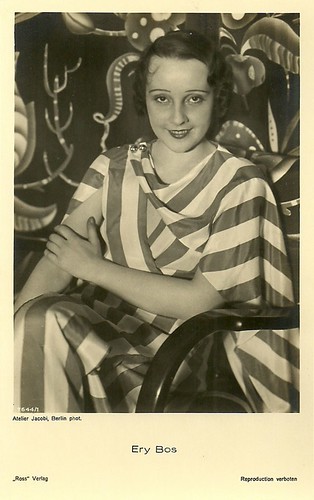
German postcard by Ross Verlag, no. 7644/1, 1932-1933. Photo: Atelier Jacobi.
The Dutch-German actress Ery Bos (1910-2005) had a short but productive film career in the early German sound film. In only three years, from 1932 to 1934 she took part in a dozen films.

German postcard by Ross Verlag, no. 8113/1, 1933-1934. Photo: Atelier Jacobi, Berlin / Ufa.
Popular actress Renate Müller (1906-1937) was the toast of late 1920s Berlin. She had a comet-like career in the early German sound cinema, that was abruptly ended by her mysterious early death.
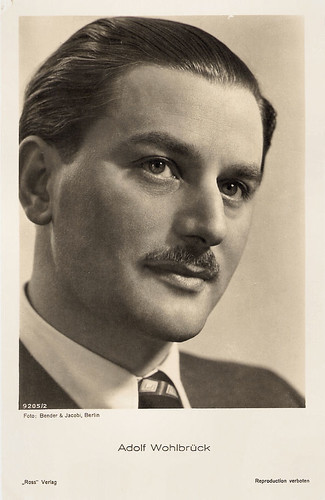
German postcard by Ross Verlag, no. 9205/2, 1935-1936. Photo: Bender & Jacobi, Berlin. These portraits of Adolf Wohlbrück were taken when Lotte Jacobi and her non-Jewish business partner Alexander Bender had taken over Atelier Jacobi.
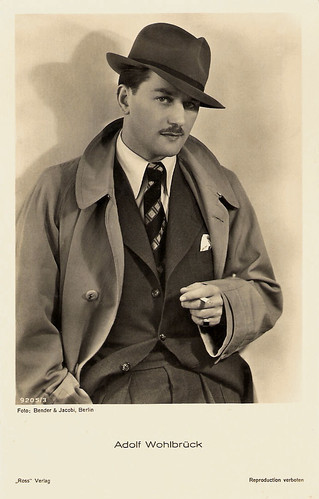
German postcard by Ross Verlag, no. 9205/3, 1935-1936. Photo: Bender & Jacobi, Berlin.
Dark and handsome Adolf Wohlbrück (1896-1967) was a distinguished Austrian actor who starred in early German sound films as Walzerkrieg (1933) and Viktor und Viktoria (1933). After the rise of Hitler, he settled in Great Britain where he appeared as Anton Walbrook in such film classics as The Life and Death of Colonel Blimp (1943) and The Red Shoes (1948). He also played the ringmaster in La Ronde (1950).
Sources: Sewell Chan (The New York Times), Lynne Warren (Encyclopedia of Twentieth-Century Photography), Jewish Virtual Library, Wikipedia and Peoplepill.com (German).

German postcard by Ross Verlag, Berlin, no. 3277/1, 1928-1929. Photo: Atelier Jacobi, Berlin.
The tiny, dainty blonde Cilly Feindt (1909-1999) was a German star of the circus ring. In her heyday, she was regarded as one of the finest Haute Ecole horse riders of her time.

German postcard by Ross Verlag, no. 3385/1, 1928-1929. Photo: Atelier Jacobi, Berlin.
German actor Hans Adalbert Schlettow (1887-1945) appeared between 1917 and 1945 in about 150 German films. He played sinister characters in some masterpieces of the German silent cinema, but in real life, Schlettow proved to be a sinister character as well.

German postcard by Ross Verlag, no. 3467/1, 1928-1929. Photo: Atelier Jacobi, Berlin.
Grete Mosheim (1905-1986) was a German film, theatre and television actress of Hungarian Jewish ancestry. In the late 1920s and early 1930s, she was a star in German cinema.

German postcard by Ross Verlag, no. 3751/1, 1928-1929. Photo: Atelier Jacobi, Berlin.
Austrian actor Fred Louis Lerch (1902-1985) was a handsome star of the Weimar cinema. In the 1950s, he would work again for German films as a production manager.

German postcard by Ross Verlag, no. 4054/2, 1929-1930. Photo: Atelier Jacobi, Berlin.
German actress Hilda Rosch only appeared in eight films between 1928 and 1931.
A family of photographers
Lotte Jacobi came from a German Jewish family of photographers. Her great-grandfather Samuel Jacobi had reportedly been an apprentice to Louis Daguerre, the photographic pioneer who invented the Daguerreotype process. Samuel, who had been a glazier, founded a photographic studio in the 1840s.
Lotte and her less-known sister Ruth Jacobi (1899-1995) were the daughters of Samuel's grandson Sigismund Jacobi and his wife Mia Jacobi née Lublinski.
From 1920, Ruth Jacobi learned her craft in the photography school of the Lette-Verein photographic school for women in Berlin, then worked for five years in her family's new photo studio at Joachimstaler Strasse 5, later Kurfürstendamm, in Berlin.
Ruth moved to New York in 1928, joining her husband, Hans Richter, whom she had married two years earlier. There she lived and photographed the Jews in the Lower East Side. Returning to Europe in the early 1930s, she divorced Richter in 1933 and then married the Hungarian physician Maurus Roth in Budapest.
The Jacobi-Roth couple emigrated to the USA in 1935. There they lived in Queens. Ruth and her sister Lotte opened a photo studio in New York. During Ruth Jacobi's lifetime, there were no exhibitions of her pictures; however, some have been published.
The dust jacket of Michael Gold’s best-selling novel 'Jews Without Money' (1930) showed one of her pictures. Between 1937 and 1939 she was able to publish several pictures in Popular Photography. Some of her portraits of Albert Einstein were used in a biography of the scientist in 1939 and 'U.S. Camera 1940', an illustrated book on the centenary of photography also featured a photograph by Ruth Jacobi-Roth.
Ruth abandoned the craft of photography for which her sister, Lotte Jacobi, became famous, and spent decades living quietly as a doctor’s wife in Astoria, Queens. Ruth died in 1995 and had no children. Her photos and negatives lay in storage with a relative in Mission Viejo, Calif.
In 2004, archivist Aubrey Pomerance learned of the trove of photographs by the lesser-known Ms. Jacobi. Pomerance was the chief archivist at the Jewish Museum Berlin. Pomerance arranged for the Jewish Museum Berlin to acquire much of the collection - some 800 prints and 3,000 negatives - in 2005. And after years of research and preparation, he mounted an exhibition of around 70 images, 'Ruth Jacobi: Photographs', in 2009 in Berlin.
Sewell Chan in The New York Times in 2009: "I was struck by Ruth Jacobi’s images on a recent vacation in Berlin during a visit to the museum, which was designed by Daniel Libeskind and opened in September 2001 (two days before the 9/11 attacks). The works evoked other famous images of early 20th-century life on the Lower East Side — like those made by Helen Levitt and Rebecca Lepkoff — but with a different sensibility and mood."

German postcard by Ross Verlag, no. 4384/1, 1929-1930. Photo: Atelier Jacobi, Berlin.
Forgotten diva Maly Delschaft (1898-1995) began her career in the theatre and then became a star in the German silent cinema. During the Nazi era, she appeared mainly in supporting roles. After the Second World War, she worked in East Germany for the state-controlled DEFA studio.

German postcard by Ross Verlag, no. 4484/1, 1929-1930. Photo: Atelier Jacobi, Berlin.
Livio Pavanelli (1881-1958) was an Italian actor of the Italian and in particular German silent cinema. He also worked in Italian sound cinema as an actor and as a production manager. He directed four Italian films, both in the silent and the sound era.

German postcard by Ross Verlag, no. 4772/1, 1929-1930. Photo: Atelier Jacobi, Berlin.
Dignified German-Russian actress Olga Tschechova (1897-1980) was one of the most popular stars of the silent film era. She remained a mysterious person throughout her life and was reportedly a Russian agent in Nazi Germany.

German postcard. Ross Verlag, no. 4879/1, 1929-1930. Photo: Atelier Jacobi, Berlin.
German actress Toni van Eyck (1910-1988) became a star playing a rape victim in the Aufklärungsfilm Gefahren der Liebe/Hazards of Love (1931). Despite this film's success, she stayed primarily a stage actress.

German postcard by Ross Verlag, no. 5463/1, 1930-1931. Photo: Atelier Jacobi, Berlin.
Austrian actress Gerda Maurus (1903-1968) was a star of the silent screen. With her protruded cheekbones and her forceful look, she bewitched many men, including her director Fritz Lang and Nazi Minister Josef Goebbels.
My style is the style of the people I photograph
Johanna Alexandra Jacobi was born in 1895 in Thorn, West Prussia (now Torun, Poland). She was the eldest of three children. The name "Lotte" was a nickname given to her by her father. She began her photographic career at 14, documenting the world around her with a homemade pinhole camera.
In 1916 she married Fritz Honig, and a year later she gave birth to a son, John Frank. The marriage did not last, and in 1924 they divorced. In 1925, she joined her parents and her sister, Ruth, in Berlin, where the family had moved in 1921.
From 1925 till 1927, she attended the Bavarian State Academy of Photography and studied art history at the University of Munich. Lotte was in her early thirties when she finished her studies. Jacobi entered the family photography business in 1927. Following an apprenticeship with her father, she became the director of Atelier Jacobi. During this same period, she began her professional career as a photographer, represented by Agentur Schostal (Schostal Photo Agency) and she also produced four films, the most important being Portrait of the Artist, a study of Josef Scharl.
She was equipped for the job not only by talent but by temperament. An emancipated woman with a leftist political slant, she had an inquiring approach and a knack for bringing subjects to her lens. Her subjects were the arts, theatre, film, and dance. Her aim was to capture each sitter's individuality. "In making portraits, I refuse to photograph myself," she said. "My style is the style of the people I photograph."
One of her famous subjects was Peter Lorre . She was allowed only one image, and it turned out to be a classic, with Lorre shot as close up as possible. She captured his villainous look but softened the angle by shooting from above.
Her interest in modern dance led her to take photos of dancers in action, aided by her own quickness and new camera technology. Her now-classic photographs of Lotte Lenya holding a cigarette, Emil Jannings casually peeling an apple, and the dancer Claire Bauroff captured the essence of Berlin theatre life.
In 1932 her leftist sympathies led her to do a series of Ernst Thalmann, the Communist candidate that year against Hitler. From October 1932 to January 1933, she made a long trip to the Soviet Union which resulted in rare and interesting shots of street scenes in Moscow and the republics of Tajikistan and Uzbekistan.
She returned to Berlin in February 1933, one month after Hitler came to power. The Nazis questioned her about her trip, her political sympathies, and her Jewish background. After her father's death, Jacobi took on ownership of the Atelier Jacobi with a non-Jewish business partner, Alexander Bender, hoping to avoid Aryanisation. However, Bender did not meet the race law requirements and the studio is threatened with expulsion from the Reichspressekammer. In September 1935, she finally left Germany together with her son.

German postcard by Ross Verlag, no. 6008/1, 1931-1932. Photo: Atelier Jacobi, Berlin.
Prima ballerina, dancer, singer and actress Liane Haid (1895-2000) was the first film star of Austria. She was the epitome of the Süßes Wiener Mädel (Sweet Viennese Girl) and from the mid-1910s on she made close to a hundred films.

German postcard by Ross Verlag, no. 6307/1, 1931-1932. Photo: Atelier Jacobi, Berlin.
Austrian opera singer Richard Tauber (1891-1948) was one of the world's finest Mozartian tenors of the 20th century. Some critics commented that "his heart felt every word he sang". He also tested the then-new talking pictures in such popular musical films as Ich küsse Ihre Hand, Madame (1929) with Marlene Dietrich, Das Land des Lächelns (1930) and Melodie der Liebe (1932).

German postcard by Ross Verlag, no. 6308/2, 1931-1932. Photo: Atelier Jacobi, Berlin.
German actress Marianne Winkelstern (1910-1966) became well known as a ballerina in Germany and England. In Germany, she appeared in some silent films and early sound films.

German postcard by Verlag Ross, Berlin, no. 7410/1, 1932-1933. Photo: Atelier Jacobi, Berlin.
Margaret 'Grete' Mosheim (1905-1986) was a German film, theatre and television actress of Hungarian Jewish ancestry. In the late 1920s and early 1930s, she was a star of the Weimar cinema.

German postcard by Ross Verlag, no. 7438/1, 1932-1933. Photo: Atelier Jacobi, Berlin.
German actress Karin Hardt (1910-1992) made her cinema debut as a pure and disarmingly natural backfisch, looking for happiness. Her impressive career with many film, theatre, and television appearances lasted for six decades.
A dreamy Einstein, in a rumpled leather jacket, hair askew
Lotte Jacobi arrived in September 1935 in New York City. With her sister Ruth Jacobi Roth, she opened a studio in Manhattan, but Lotte struggled to find work. An important American contact was Albert Einstein, whom she and her family had photographed in Germany.
He agreed to work with her when, in 1938, Life magazine commissioned a photo essay on the scientist. She made several informal photographs at Einstein's home in Princeton, N.J., in conversations with his students, but Life felt they were too casual and decided not to publish them.
However, in 1942, the magazine U.S. Camera, at the instigation of Edward Steichen, published a photo of a dreamy Einstein, in a rumpled leather jacket, hair askew, that became one of the most famous images of him.
In the 1940s Jacobi explored the technique of photogenics, expressive abstract images made by drawing with a flashlight on photographic paper. The process had been extensively explored in the early 20th century by Man Ray and Laszlo Moholy-Nagy.
In 1940, in New York, she married her second husband (she and her first husband had divorced), Erich Reiss, a German avant-garde publisher and writer, who was rescued from a Nazi death camp. He died in 1951.
In 1955, Jacobi left New York with her son and daughter-in-law and moved to Deering, New Hampshire, a move that changed her life. There she opened a new studio and served as a mentor to younger artists for 30 years. She continued her interest in the forms of nature, taking pictures of snow, water, and other phenomena in the countryside.
She remained active as a portrait photographer, developing a new set of subjects and friends, including the poets Robert Frost and May Sarton, the ecological activists Helen and Scott Nearing, and a fellow photographer, Paul Caponigro. Among her other notable portraits – all in black and white – were those of the dramatist Kurt Weill, Eleanor Roosevelt, Marc Chagall, and the musician Pablo Casals.
Lotte Jacobi passed away in 1990 at the age of 93. She bequeathed a collection of 47,000 negatives to the University of New Hampshire. Her earlier work was lost to the Nazis, but this post offers a glimpse of the film star portraits she took in Berlin.

German postcard by Ross Verlag, no. 7643/1, 1932-1933. Photo: Atelier Jacobi, Berlin.
Austrian film and theatre actor Oskar Homolka (1898-1978) had a stocky appearance, bushy eyebrows and a rather Slavic-sounding name, which led many to believe he was Eastern European or Russian. His expressive face predestined him to play character roles as a scoundrel, pimp or communist spy.

German postcard by Ross Verlag, no. 7644/1, 1932-1933. Photo: Atelier Jacobi.
The Dutch-German actress Ery Bos (1910-2005) had a short but productive film career in the early German sound film. In only three years, from 1932 to 1934 she took part in a dozen films.

German postcard by Ross Verlag, no. 8113/1, 1933-1934. Photo: Atelier Jacobi, Berlin / Ufa.
Popular actress Renate Müller (1906-1937) was the toast of late 1920s Berlin. She had a comet-like career in the early German sound cinema, that was abruptly ended by her mysterious early death.

German postcard by Ross Verlag, no. 9205/2, 1935-1936. Photo: Bender & Jacobi, Berlin. These portraits of Adolf Wohlbrück were taken when Lotte Jacobi and her non-Jewish business partner Alexander Bender had taken over Atelier Jacobi.

German postcard by Ross Verlag, no. 9205/3, 1935-1936. Photo: Bender & Jacobi, Berlin.
Dark and handsome Adolf Wohlbrück (1896-1967) was a distinguished Austrian actor who starred in early German sound films as Walzerkrieg (1933) and Viktor und Viktoria (1933). After the rise of Hitler, he settled in Great Britain where he appeared as Anton Walbrook in such film classics as The Life and Death of Colonel Blimp (1943) and The Red Shoes (1948). He also played the ringmaster in La Ronde (1950).
Sources: Sewell Chan (The New York Times), Lynne Warren (Encyclopedia of Twentieth-Century Photography), Jewish Virtual Library, Wikipedia and Peoplepill.com (German).
Published on June 10, 2020 22:00
June 9, 2020
Enrico Glori
Enrico Glori (1901-1966) was a talented and experienced character actor in over 126 French and Italian films between 1934 and 1963. The Italian specialised in sadistic, treacherous and violent roles.

Italian postcard by B.F.F. (Ballerini & Fratini, Firenze) Editori, no. 2188. Photo: Bragaglia.
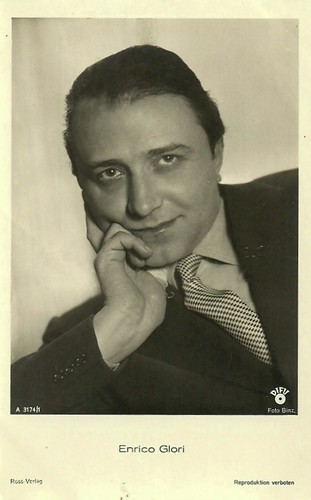
German postcard by Ross Verlag, no. A 3174/1, 1941-1944. Photo: Binz / Difu.
Perfidious, cruel and devious men
Enrico Glori was born as Enrico Musy in Naples in 1901, into a rich and wealthy Neapolitan family of remote French origins.
He graduated in law, and at the age of thirty, he moved to France where for a period he worked as a journalist. He also took an interest in theater. In Paris, he inaugurated and directed the Teatro degli Italiani for three years and during this activity, he came into contact with Pierre Chenal and Sacha Guitry who convinced him to try the experience of cinema.
Enrico Glori made his debut as a film actor in La Rue sans nom/Street Without a Name (Pierre Chenal, 1934), starring Constant Rémy and Gabriel Gabrio . In France, Glori also played several character roles on stage.
In 1937, he returned to Italy, when Chenal convinced him to accept a role in the film version of Il fu Mattia Pascal/He Was Mattia Pascal (Pierre Chenal, 1937) with Pierre Blanchar and Isa Miranda .
Following this interpretation, between the late 1930s and early 1940s, Glori was constantly assigned roles of perfidious, cruel and devious men, thanks also to his physical adherence to these characters. Together with Osvaldo Valenti, he became the villain par excellence of the Italian cinema of the time.
Glori never obtained leading parts, except for the brilliant title character of Il barone di Corbò/Baron Corbo (Gennaro Righelli, 1939), based on the eponymous play by Luigi Antonelli.
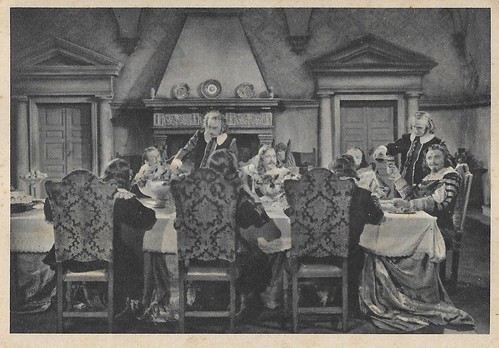
Italian postcard by S.A. Grafitalia, Milano (Milan), no. 5. Photo: Film Lux. Enrico Glori as Don Rodrigo (far right at the table) in I promessi Sposi/The Spirit and the Flesh (Mario Camerini, 1941).
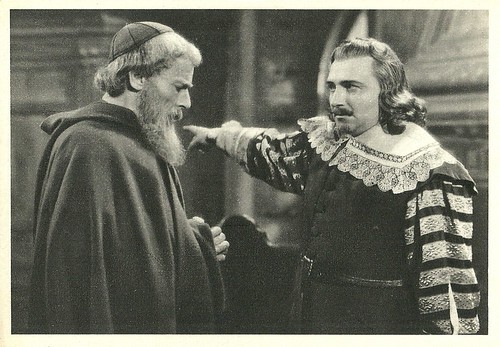
Italian postcard by S.A. Grafitalia, Milano (Milan), no. 6. Photo: Film Lux. Publicity still for I Promessi Sposi/The Spirit and the Flesh (Mario Camerini, 1941). Don Rodrigo (Enrico Glori) chases Padre Cristoforo (Luis Hurtado) from his house. He refuses to allow Renzo and Lucia to marry because he wants Lucia for himself.
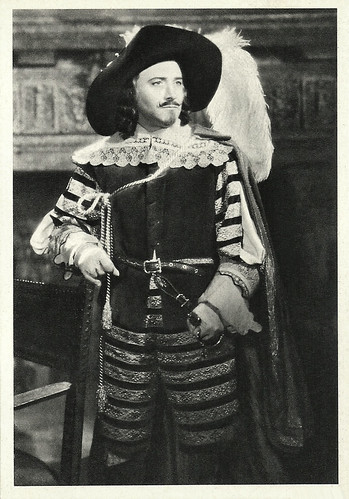
Italian postcard by S.A. Grafitalia, Milano (Milan), no. 10. Photo: Film Lux. Enrico Glori as Don Rodrigo in I Promessi Sposi/The Spirit and the Flesh (Mario Camerini, 1941).
Fellini wanted him for the umpteenth villain role
Among Enrico Glori's most notable interpretations of this period are the smuggler of Sotto la croce del sud/Under the Southern Cross (Guido Brignone, 1938) who pays for his faults by dying atrociously in the quicksands, the criminal head of staff Bertini at the department store in Grandi magazzini/Department Store (Mario Camerini, 1939), and the cowardly murderer Lorenzo Loredano in Il fornaretto di Venezia/The bakery boy of Venice (Duilio Coletti, 1939)
He is best remembered as the cruel and lustful Don Rodrigo in the 1941 film version of I promessi/The Spirit and the Flesh (Mario Camerini, 1941), adapted from the classic novel 'I promessi sposi' (The Betrothed) by Alessandro Manzoni.
The repetitiveness of these roles, however, led Glori, after the war, to alternate acting in films with theatrical activity. In 1949 he starred with Lamberto Picasso and Camillo Pilotto in 'Corruzione al palazzo di giustizia' (Corruption at the courthouse), a drama written by Ugo Betti and directed by Orazio Spadaro. Also in the same year, on the occasion of performances of D'Annunzio's plays, he appeared in Pescara in 'La figlia di Iorio' (Iorio's Daughter), with Camillo Pilotto and Elena Zareschi.
In 1957 he became part of the Torrieri-Pisu stage company. In the same period, Glori worked in several films directed among others by Raffaello Matarazzo, Vittorio De Sica , Michelangelo Antonioni, Alberto Lattuada, Eduardo De Filippo , and Mauro Bolognini.
Federico Fellini wanted him for the umpteenth role of 'villain' in the orgy scene of La dolce vita (1960). He also appeared in many mythological Peplum films, always in antagonistic, minor roles.
Glori also acted on television in several screenplays, but always limited himself to secondary roles, under directors such as Sandro Bolchi, Daniele D'Anza, Edmo Fenoglio, Mario Lanfranchi, Mario Landi, and Anton Giulio Majano.
In 1966, due to health problems, Glori stopped all activities. Shortly after retiring from the scene, he died in Rome on 22 April 1966. Enrico Glori was married to the actress Gianna Pacetti with whom he had a son, Gianni Musy, who would become an actor and voice actor. His granddaughters are the actresses Mascia Musy and Maria Stella Musy.

Italian postcard by ASER (A. Scarmiglia Edizioni, Roma), no. 253. Photo: Bragaglia / Atlas Tirrenia.
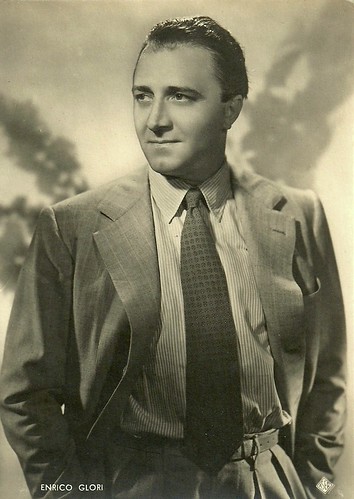
Italian postcard by ASER (A. Scarmiglia Edizioni Roma), no. 257. Photo: De Antonis.
Sources: Wikipedia (Italian and English), and . Click here for Glori in Grandi Magazzini, and here for the quicksand scene in Sotto la croce del sud.

Italian postcard by B.F.F. (Ballerini & Fratini, Firenze) Editori, no. 2188. Photo: Bragaglia.

German postcard by Ross Verlag, no. A 3174/1, 1941-1944. Photo: Binz / Difu.
Perfidious, cruel and devious men
Enrico Glori was born as Enrico Musy in Naples in 1901, into a rich and wealthy Neapolitan family of remote French origins.
He graduated in law, and at the age of thirty, he moved to France where for a period he worked as a journalist. He also took an interest in theater. In Paris, he inaugurated and directed the Teatro degli Italiani for three years and during this activity, he came into contact with Pierre Chenal and Sacha Guitry who convinced him to try the experience of cinema.
Enrico Glori made his debut as a film actor in La Rue sans nom/Street Without a Name (Pierre Chenal, 1934), starring Constant Rémy and Gabriel Gabrio . In France, Glori also played several character roles on stage.
In 1937, he returned to Italy, when Chenal convinced him to accept a role in the film version of Il fu Mattia Pascal/He Was Mattia Pascal (Pierre Chenal, 1937) with Pierre Blanchar and Isa Miranda .
Following this interpretation, between the late 1930s and early 1940s, Glori was constantly assigned roles of perfidious, cruel and devious men, thanks also to his physical adherence to these characters. Together with Osvaldo Valenti, he became the villain par excellence of the Italian cinema of the time.
Glori never obtained leading parts, except for the brilliant title character of Il barone di Corbò/Baron Corbo (Gennaro Righelli, 1939), based on the eponymous play by Luigi Antonelli.

Italian postcard by S.A. Grafitalia, Milano (Milan), no. 5. Photo: Film Lux. Enrico Glori as Don Rodrigo (far right at the table) in I promessi Sposi/The Spirit and the Flesh (Mario Camerini, 1941).

Italian postcard by S.A. Grafitalia, Milano (Milan), no. 6. Photo: Film Lux. Publicity still for I Promessi Sposi/The Spirit and the Flesh (Mario Camerini, 1941). Don Rodrigo (Enrico Glori) chases Padre Cristoforo (Luis Hurtado) from his house. He refuses to allow Renzo and Lucia to marry because he wants Lucia for himself.

Italian postcard by S.A. Grafitalia, Milano (Milan), no. 10. Photo: Film Lux. Enrico Glori as Don Rodrigo in I Promessi Sposi/The Spirit and the Flesh (Mario Camerini, 1941).
Fellini wanted him for the umpteenth villain role
Among Enrico Glori's most notable interpretations of this period are the smuggler of Sotto la croce del sud/Under the Southern Cross (Guido Brignone, 1938) who pays for his faults by dying atrociously in the quicksands, the criminal head of staff Bertini at the department store in Grandi magazzini/Department Store (Mario Camerini, 1939), and the cowardly murderer Lorenzo Loredano in Il fornaretto di Venezia/The bakery boy of Venice (Duilio Coletti, 1939)
He is best remembered as the cruel and lustful Don Rodrigo in the 1941 film version of I promessi/The Spirit and the Flesh (Mario Camerini, 1941), adapted from the classic novel 'I promessi sposi' (The Betrothed) by Alessandro Manzoni.
The repetitiveness of these roles, however, led Glori, after the war, to alternate acting in films with theatrical activity. In 1949 he starred with Lamberto Picasso and Camillo Pilotto in 'Corruzione al palazzo di giustizia' (Corruption at the courthouse), a drama written by Ugo Betti and directed by Orazio Spadaro. Also in the same year, on the occasion of performances of D'Annunzio's plays, he appeared in Pescara in 'La figlia di Iorio' (Iorio's Daughter), with Camillo Pilotto and Elena Zareschi.
In 1957 he became part of the Torrieri-Pisu stage company. In the same period, Glori worked in several films directed among others by Raffaello Matarazzo, Vittorio De Sica , Michelangelo Antonioni, Alberto Lattuada, Eduardo De Filippo , and Mauro Bolognini.
Federico Fellini wanted him for the umpteenth role of 'villain' in the orgy scene of La dolce vita (1960). He also appeared in many mythological Peplum films, always in antagonistic, minor roles.
Glori also acted on television in several screenplays, but always limited himself to secondary roles, under directors such as Sandro Bolchi, Daniele D'Anza, Edmo Fenoglio, Mario Lanfranchi, Mario Landi, and Anton Giulio Majano.
In 1966, due to health problems, Glori stopped all activities. Shortly after retiring from the scene, he died in Rome on 22 April 1966. Enrico Glori was married to the actress Gianna Pacetti with whom he had a son, Gianni Musy, who would become an actor and voice actor. His granddaughters are the actresses Mascia Musy and Maria Stella Musy.

Italian postcard by ASER (A. Scarmiglia Edizioni, Roma), no. 253. Photo: Bragaglia / Atlas Tirrenia.

Italian postcard by ASER (A. Scarmiglia Edizioni Roma), no. 257. Photo: De Antonis.
Sources: Wikipedia (Italian and English), and . Click here for Glori in Grandi Magazzini, and here for the quicksand scene in Sotto la croce del sud.
Published on June 09, 2020 22:00
June 8, 2020
Kammermusik (1925)
The German silent film drama Kammermusik/My Bachelor Husbands (1925) was a typical Henny Porten vehicle of the 1920s, directed by Carl Froelich and produced by their own company HPF (Henny Porten-Froelich-Produktion). The film was scripted by Robert Liebmann and Walter Supper, based on a play by Heinrich Ilgenstein. Franz Schroedter designed the sets, and the cinematography was by Axel Graatkjaer. Porten's husband, Wilhelm von Kaufmann, was the production manager.
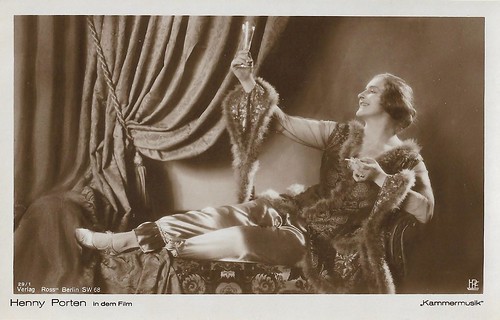
German postcard by Ross Verlag, Berlin, no. 29/1. Photo: HPF (Henny Porten-Froelich-Produktion). Henny Porten in Kammermusik/My Bachelor Husbands (Carl Froelich, 1925).
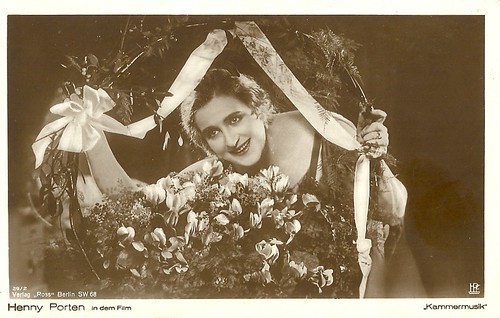
German postcard by Ross Verlag, Berlin, no. 29/2. Photo: HPF (Henny Porten-Froelich-Produktion). Henny Porten in Kammermusik/My Bachelor Husbands (Carl Froelich, 1925).
Married to a talented but very difficult artist
In Kammermusik/My Bachelor Husbands or Chamber Music (Carl Froelich, 1925), Cesare von Niemeyer ( Livio Pavanelli ) is a talented but very difficult artist who doubts that he will ever experience his breakthrough as a musician.
Cesare continually accuses his wife, Hilde von Niemeyer ( Henny Porten ) of being to blame and more than hindering his career with his alleged detention in her bourgeois world. At some point, it is enough for his wife and she finally releases her husband.
Cesare returns to the world of opera and, thanks to his generous patron, Herzogin von Siebenstein ( Ida Wüst ), he celebrates a great success. It doesn't take long before the powerful aristocrat falls in love with the artist.
Frau von Niemeyer, however, has followed her husband and has caught the attention of the young crown prince Bernhard ( Harry Halm ), a nephew of Herzogin von Siebenstein. Cesare soon disapproves of this, and he realises that the comfort of his wife's home is not as narrow-minded and petty-bourgeois as he previously thought. Cesare and Hilde return home as a couple.
Kammermusik/My Bachelor Husbands (Carl Froelich, 1925) was created in the winter of 1924/1925, passed film censorship on 14 March 1925 and premiered on 19 March 1925 as part of a press screening in the Berlin Primus Palast cinema. The public premiere was on 24 March 1925. Supporting actors in Kammermusik were Ferdinand von Alten (Hofintendant), Jacob Tiedtke (Hilde's father), and Helmut Henkel (Hilde's son).

German postcard by Ross Verlag, Berlin, no. 29/3. Photo: HPF (Henny Porten-Froelich-Produktion). Henny Porten , Ferdinand von Alten and Livio Pavanelli in Kammermusik/My Bachelor Husbands (Carl Froelich, 1925).
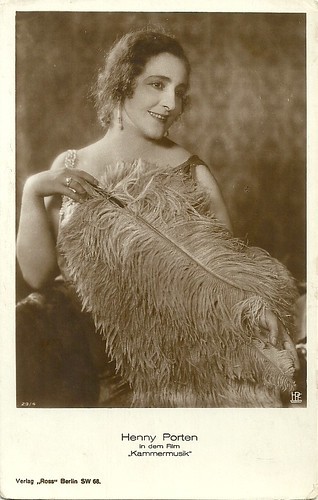
German postcard by Ross Verlag, Berlin, no. 29/4. Photo: HPF (Henny Porten-Froelich-Produktion). Henny Porten in Kammermusik/My Bachelor Husbands (Carl Froelich, 1925).
Sources: Wikipedia (English and German), and IMDb.

German postcard by Ross Verlag, Berlin, no. 29/1. Photo: HPF (Henny Porten-Froelich-Produktion). Henny Porten in Kammermusik/My Bachelor Husbands (Carl Froelich, 1925).

German postcard by Ross Verlag, Berlin, no. 29/2. Photo: HPF (Henny Porten-Froelich-Produktion). Henny Porten in Kammermusik/My Bachelor Husbands (Carl Froelich, 1925).
Married to a talented but very difficult artist
In Kammermusik/My Bachelor Husbands or Chamber Music (Carl Froelich, 1925), Cesare von Niemeyer ( Livio Pavanelli ) is a talented but very difficult artist who doubts that he will ever experience his breakthrough as a musician.
Cesare continually accuses his wife, Hilde von Niemeyer ( Henny Porten ) of being to blame and more than hindering his career with his alleged detention in her bourgeois world. At some point, it is enough for his wife and she finally releases her husband.
Cesare returns to the world of opera and, thanks to his generous patron, Herzogin von Siebenstein ( Ida Wüst ), he celebrates a great success. It doesn't take long before the powerful aristocrat falls in love with the artist.
Frau von Niemeyer, however, has followed her husband and has caught the attention of the young crown prince Bernhard ( Harry Halm ), a nephew of Herzogin von Siebenstein. Cesare soon disapproves of this, and he realises that the comfort of his wife's home is not as narrow-minded and petty-bourgeois as he previously thought. Cesare and Hilde return home as a couple.
Kammermusik/My Bachelor Husbands (Carl Froelich, 1925) was created in the winter of 1924/1925, passed film censorship on 14 March 1925 and premiered on 19 March 1925 as part of a press screening in the Berlin Primus Palast cinema. The public premiere was on 24 March 1925. Supporting actors in Kammermusik were Ferdinand von Alten (Hofintendant), Jacob Tiedtke (Hilde's father), and Helmut Henkel (Hilde's son).

German postcard by Ross Verlag, Berlin, no. 29/3. Photo: HPF (Henny Porten-Froelich-Produktion). Henny Porten , Ferdinand von Alten and Livio Pavanelli in Kammermusik/My Bachelor Husbands (Carl Froelich, 1925).

German postcard by Ross Verlag, Berlin, no. 29/4. Photo: HPF (Henny Porten-Froelich-Produktion). Henny Porten in Kammermusik/My Bachelor Husbands (Carl Froelich, 1925).
Sources: Wikipedia (English and German), and IMDb.
Published on June 08, 2020 22:00
June 7, 2020
Ferdinand von Alten
Ferdinand von Alten (1885-1933), born Baron von Lamezan auf Altenhofen, was a German stage and screen actor. He had a prolific career in the Weimar cinema and worked with both Ernst Lubitsch and Alfred Hitchcock. Ferdinand von Alten acted in a little over 100 films.
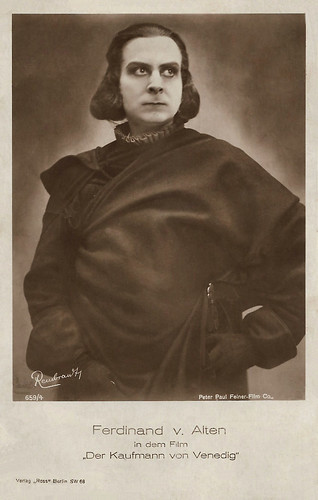
German postcard by Ross Verlag, Berlin, no. 659/4. Photo: Rembrandt / Peter Paul Felner-Film Co. Ferdinand von Alten as the Prince of Aragon in Der Kaufmann von Venedig/The Merchant of Venice (Peter Paul Felner, 1923).

German postcard by Ross Verlag, no. 700/8. Photo: Ufa. Publicity still for Kampf um die Scholle/Struggle for the Soil (Erich Waschneck, 1925) with Ferdinand von Alten and Margarete Schön .
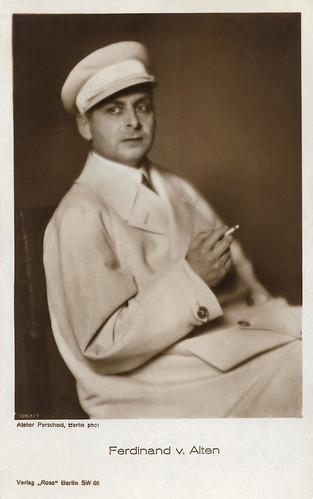
German postcard by Ross Verlag, no. 1063/7, 1927-1928. Photo: Atelier Perscheid, Berlin.
Elegant lovers, officers, and superiors
Ferdinand von Alten was born Theo von Alten, Baron von Lamezan auf Altenhofen in 1885 in St. Petersburg, then Russian Empire.
He began a military career like his ancestors had done, and became an officer. Yet, then he took acting lessons from reputed stage actor Albert Steinrück and decided to become an actor.
In 1911 he made his debut at the Hoftheater in Munich, where he worked until the end of the First World War. From 1918 he performed on the Berlin stages, particularly at the Deutsches Theater, where he was part of the ensemble during the 1920s.
He soon debuted in silent film and had his earliest known film part in the Henny Porten vehicle Die blaue Laterne (Rudolf Biebrach, 1918).
In the following years, he was often cast in medium and small roles, embodying elegant lovers, officers, and superiors.

German postcard. Editor unknown. Ferdinand von Alten, Hof-Schauspieler. This card dates from before 1919 when Von Alten worked as a stage actor at the Munich Hof-Theater (1911-1918).

German postcard by Rotophot in the Film-Sterne series, no. 567/2. Photo: Messter-Film, Berlin. Henny Porten and Ferdinand von Alten in Die blaue Laterne (Rudolf Biebrach, Messter 1918), based on the novel by Paul Lindau.

German postcard by Ross Verlag, no. 695/4. Photo: Maxim Film. Henny Porten , Ferdinand von Alten, and Friedrich Kayssler in Gräfin Donelli (G.W. Pabst, 1924). Von Alten played Baron von Trachwitz.
Lubitsch
From the late 1910s, Ferdinand von Alten alternated film companies. He acted at Berliner-Filmmanufaktur in films with Mady Christians , which were directed by Fred Sauer. Then followed Bayerische Film-Gesellschaft, Amboss-Film Dworsky, Cserépy-Film etc.
In 1920, Von Alten was Mark Smeaton in Ernst Lubitsch 's period piece Anna Boleyn (1920), starring Henny Porten and Emil Jannings .
In the same year, he also played Napoleon Bonaparte opposite Fern Andra in Madame Récamier (1920).
He also starred as detective Joe Deebs in Gentlemen-Gauner (Willy Zeyn, 1920). Von Alten would also star in subsequent Joe Deebs films, such as Das Geheimnis der Mumie (1921), Ein Erpressertrick (1921), and Das Handicap der Liebe (1921).
Other remarkable parts he played in the early 1920s were in Danton (Dimitri Buchowetzki, 1921) starring Emil Jannings , Othello (Dimitri Buchowetzki, 1922) again starring Emil Jannings, Der Kaufmann von Venedig (1923) with Henny Porten , and Gräfin Donelli (G.W. Pabst, 1924) again with Porten.

German postcard by Ross Verlag, Berlin, no. 29/3. Photo: HPF (Henny Porten-Froelich-Produktion). Henny Porten , Ferdinand von Alten and Livio Pavanelli in Kammermusik/My Bachelor Husbands (Carl Froelich, 1925).

German postcard by Ross Verlag, no. 700/5, 1925-1926. Photo: Kulturabteilung der UFA. Publicity still for Kampf um die Scholle/Struggle for the Soil (Erich Waschneck, 1925). In the middle, Ferdinand von Alten as Axel von Wulffshagen, at the races, squandering his father's money.
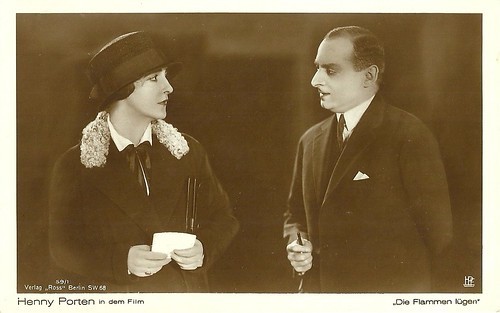
German postcard by Ross Verlag, no. 59/1. Photo: Henny Porten Film. Henny Porten and Ferdinand von Alten in Die Flammen lügen (Carl Froehlich, 1926).
Hitchcock
From the mid-1920s, Ferdinand von Alten had remarkable parts in Kampf um die Scholle (Erich Waschneck, 1925) with Oscar Marion , Der Student von Prag (Henrik Galeen, 1926) with Conrad Veidt , and Der Mann ohne Kopf (Nunzio Malasomma, 1927) with Carlo Aldini .
He co-starred again with Henny Porten in two more films, Kammermusik (Carl Froelich, 1925) and Die Flammen lügen (Carl Froehlich, 1926).
He also worked with Alfred Hitchcock in Champagne (Alfred Hitchcock, 1928) with Betty Balfour .
Other interesting films were Weib in Flammen (Max Reichmann, 1928) with Olga Tschechova , the early sound film Im Kampf mit der Unterwelt (Carlo Aldini, 1930) with Carlo Aldini , Gräfin Mariza (Richard Oswald, 1932) with Dorothea Wieck , and Die - oder keine (Carl Froehlich, 1932) starring Gitta Alpar and Max Hansen .
In addition, he acted in many minor parts in films. Von Alten's last part was a minor one in Das Meer ruft (Hans Hinrich, 1933), a fishermen's drama with Heinrich George , based on 'Terje Vigen' by Henrik Ibsen. Ferdinand von Alten had acted in a little over 100 films.
In 1933, Ferdinand von Alten died at the age of 47 from pleurisy and pneumonia, which he contracted during a theatre tour, and was buried at the St. Matthias Friedhof in Berlin.
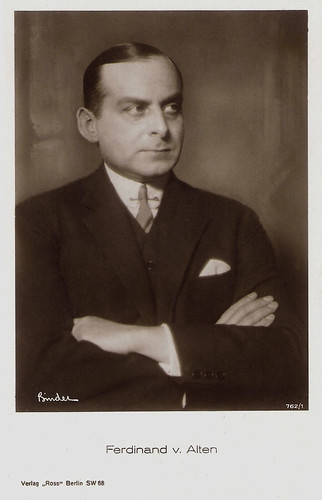
German postcard by Ross Verlag, no. 762/1, 1925-1926. Photo: Alex Binder.

German postcard by Ross Verlag, no. 762/2, 1925-1926. Photo: Alex Binder.
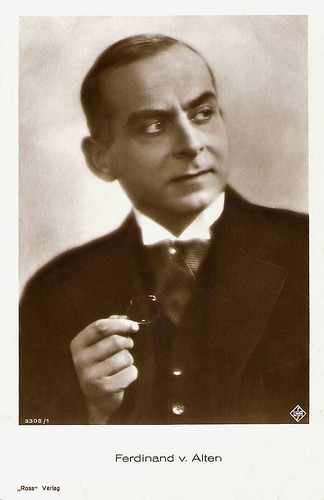
German postcard by Ross Verlag, no. 3308/1, 1928-1929. Photo: Ufa.
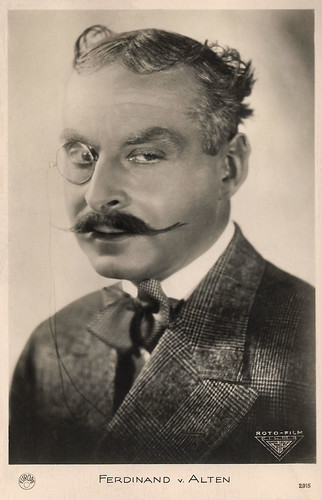
French postcard by Europe, no. 2915. Photo: Roto Film. Ferdinand von Alten in Gräfin Mariza/Countess Mariza (Richard Oswald, 1932).
Sources: Wikipedia (German), and .

German postcard by Ross Verlag, Berlin, no. 659/4. Photo: Rembrandt / Peter Paul Felner-Film Co. Ferdinand von Alten as the Prince of Aragon in Der Kaufmann von Venedig/The Merchant of Venice (Peter Paul Felner, 1923).

German postcard by Ross Verlag, no. 700/8. Photo: Ufa. Publicity still for Kampf um die Scholle/Struggle for the Soil (Erich Waschneck, 1925) with Ferdinand von Alten and Margarete Schön .

German postcard by Ross Verlag, no. 1063/7, 1927-1928. Photo: Atelier Perscheid, Berlin.
Elegant lovers, officers, and superiors
Ferdinand von Alten was born Theo von Alten, Baron von Lamezan auf Altenhofen in 1885 in St. Petersburg, then Russian Empire.
He began a military career like his ancestors had done, and became an officer. Yet, then he took acting lessons from reputed stage actor Albert Steinrück and decided to become an actor.
In 1911 he made his debut at the Hoftheater in Munich, where he worked until the end of the First World War. From 1918 he performed on the Berlin stages, particularly at the Deutsches Theater, where he was part of the ensemble during the 1920s.
He soon debuted in silent film and had his earliest known film part in the Henny Porten vehicle Die blaue Laterne (Rudolf Biebrach, 1918).
In the following years, he was often cast in medium and small roles, embodying elegant lovers, officers, and superiors.

German postcard. Editor unknown. Ferdinand von Alten, Hof-Schauspieler. This card dates from before 1919 when Von Alten worked as a stage actor at the Munich Hof-Theater (1911-1918).

German postcard by Rotophot in the Film-Sterne series, no. 567/2. Photo: Messter-Film, Berlin. Henny Porten and Ferdinand von Alten in Die blaue Laterne (Rudolf Biebrach, Messter 1918), based on the novel by Paul Lindau.

German postcard by Ross Verlag, no. 695/4. Photo: Maxim Film. Henny Porten , Ferdinand von Alten, and Friedrich Kayssler in Gräfin Donelli (G.W. Pabst, 1924). Von Alten played Baron von Trachwitz.
Lubitsch
From the late 1910s, Ferdinand von Alten alternated film companies. He acted at Berliner-Filmmanufaktur in films with Mady Christians , which were directed by Fred Sauer. Then followed Bayerische Film-Gesellschaft, Amboss-Film Dworsky, Cserépy-Film etc.
In 1920, Von Alten was Mark Smeaton in Ernst Lubitsch 's period piece Anna Boleyn (1920), starring Henny Porten and Emil Jannings .
In the same year, he also played Napoleon Bonaparte opposite Fern Andra in Madame Récamier (1920).
He also starred as detective Joe Deebs in Gentlemen-Gauner (Willy Zeyn, 1920). Von Alten would also star in subsequent Joe Deebs films, such as Das Geheimnis der Mumie (1921), Ein Erpressertrick (1921), and Das Handicap der Liebe (1921).
Other remarkable parts he played in the early 1920s were in Danton (Dimitri Buchowetzki, 1921) starring Emil Jannings , Othello (Dimitri Buchowetzki, 1922) again starring Emil Jannings, Der Kaufmann von Venedig (1923) with Henny Porten , and Gräfin Donelli (G.W. Pabst, 1924) again with Porten.

German postcard by Ross Verlag, Berlin, no. 29/3. Photo: HPF (Henny Porten-Froelich-Produktion). Henny Porten , Ferdinand von Alten and Livio Pavanelli in Kammermusik/My Bachelor Husbands (Carl Froelich, 1925).

German postcard by Ross Verlag, no. 700/5, 1925-1926. Photo: Kulturabteilung der UFA. Publicity still for Kampf um die Scholle/Struggle for the Soil (Erich Waschneck, 1925). In the middle, Ferdinand von Alten as Axel von Wulffshagen, at the races, squandering his father's money.

German postcard by Ross Verlag, no. 59/1. Photo: Henny Porten Film. Henny Porten and Ferdinand von Alten in Die Flammen lügen (Carl Froehlich, 1926).
Hitchcock
From the mid-1920s, Ferdinand von Alten had remarkable parts in Kampf um die Scholle (Erich Waschneck, 1925) with Oscar Marion , Der Student von Prag (Henrik Galeen, 1926) with Conrad Veidt , and Der Mann ohne Kopf (Nunzio Malasomma, 1927) with Carlo Aldini .
He co-starred again with Henny Porten in two more films, Kammermusik (Carl Froelich, 1925) and Die Flammen lügen (Carl Froehlich, 1926).
He also worked with Alfred Hitchcock in Champagne (Alfred Hitchcock, 1928) with Betty Balfour .
Other interesting films were Weib in Flammen (Max Reichmann, 1928) with Olga Tschechova , the early sound film Im Kampf mit der Unterwelt (Carlo Aldini, 1930) with Carlo Aldini , Gräfin Mariza (Richard Oswald, 1932) with Dorothea Wieck , and Die - oder keine (Carl Froehlich, 1932) starring Gitta Alpar and Max Hansen .
In addition, he acted in many minor parts in films. Von Alten's last part was a minor one in Das Meer ruft (Hans Hinrich, 1933), a fishermen's drama with Heinrich George , based on 'Terje Vigen' by Henrik Ibsen. Ferdinand von Alten had acted in a little over 100 films.
In 1933, Ferdinand von Alten died at the age of 47 from pleurisy and pneumonia, which he contracted during a theatre tour, and was buried at the St. Matthias Friedhof in Berlin.

German postcard by Ross Verlag, no. 762/1, 1925-1926. Photo: Alex Binder.

German postcard by Ross Verlag, no. 762/2, 1925-1926. Photo: Alex Binder.

German postcard by Ross Verlag, no. 3308/1, 1928-1929. Photo: Ufa.

French postcard by Europe, no. 2915. Photo: Roto Film. Ferdinand von Alten in Gräfin Mariza/Countess Mariza (Richard Oswald, 1932).
Sources: Wikipedia (German), and .
Published on June 07, 2020 22:00
June 6, 2020
Gia Scala
Gia Scala (1934-1972) was a beautiful, sensitive Italian-American actress and model. Despite roles in such classics as The Guns of Navarone (1961), she never reached her full potential in Hollywood. Later, she also worked in Italy. The circumstances of Scala's death at 36 by an overdose, have been questioned.
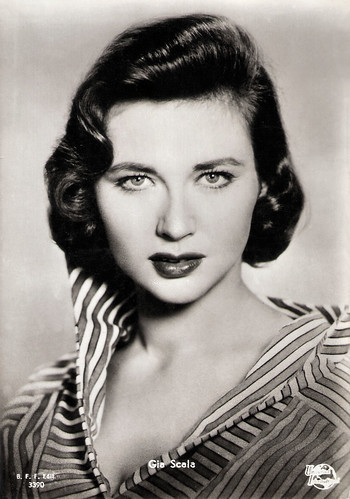
Italian postcard by B.F.F. Edit., no. 3390. Photo: Universal International.
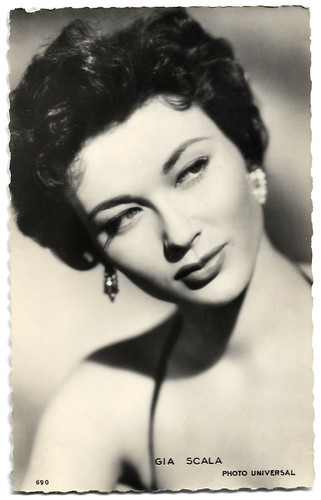
French postcard by Editions P.I., Paris, no. 690. Photo: Universal.
Cha Cha for Gia
Gia Scala was born Josephine Grace Johanna Scoglio in 1934, in Liverpool, England, to aristocratic Sicilian father Pietro Scoglio, and Irish mother Eileen O'Sullivan. She had one sister, Tina Scala, also an actress.
Scala was brought up in Messina and Mili San Marco in Sicily, the latter on the estate of her grandfather, Natale Scoglio, who was one of the largest citrus growers in Sicily. When Scala was 16, she moved to the United States to live with her aunt Agata in Whitestone, Queens, New York City.
In 1952, after graduating from Bayside High School, she moved to Manhattan to pursue acting. Scala supported herself by working at a travel agency. During this time, Scala studied acting with Stella Adler and the Actors Studio, where she met Steve McQueen. The two dated from 1952 to 1954.
Scala began to appear on game shows, including Stop the Music, where she later became host Bert Parks' assistant. There she was spotted by Maurice Bergman, an executive of Universal International located in New York City. In 1954, accompanied by her mother, Scala flew to Los Angeles to screen test for the role of Mary Magdalene in The Gallileans but the film ended up being scrapped.
Although she did not get the part, Peter Johnson at Universal was impressed with Scala's screen test. Scala had her first official job in Hollywood when she was given a non-speaking, uncredited part in All That Heaven Allows (Douglas Sirk, 1955), starring Jane Wyman and Rock Hudson . Despite her minor role in the film, Universal signed her to a contract, dyed her hair dark brown, had her four front teeth capped, and gave her the stage name Gia Scala.
Songwriter Henry Mancini met Scala on the set of Four Girls in Town (Jack Sher, 1957), with George Nader and Marianne Koch . Inspired by her beauty, he wrote 'Cha Cha for Gia', which appeared uncredited in the film. She also played in Tip on a Dead Jockey (Richard Thorpe, 1957) starring Robert Taylor, and the Film Noir The Garment Jungle (Vincent Sherman, Robert Aldrich, 1957), with Lee J. Cobb.
Scala became emotionally distraught following the death of her mother in 1957. She began to drink heavily as compensation which led to a few arrests.
In 1958, she became a naturalised American citizen. Scala soon after landed roles in such films as the romantic comedy The Tunnel of Love (Gene Kelly, 1958) with Doris Day , the Western Ride a Crooked Trail (Jesse Hibbs, 1958), with former World War II hero Audie Murphy and Walter Matthau, the war thriller The Two-Headed Spy (André De Toth, 1958) featuring Jack Hawkins , and The Angry Hills (Robert Aldrich, 1959) with Robert Mitchum .
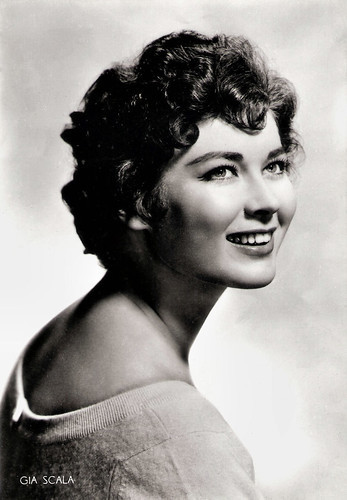
Italian postcard, no. 526.
A Greek resistance fighter, tortured by the Nazis
In 1959, Gia Scala married Don Burnett, an actor who later turned investment banker. During the 1960s, Scala made frequent appearances on American television in such series as Alfred Hitchcock Presents (1960), The Rogues (1964-1965), Convoy (1965), Voyage to the Bottom of the Sea (1965), Twelve O'Clock High (1965), and Tarzan (1967).
Gia's best-known film role came as Anna, a Greek resistance fighter in the epic The Guns of Navarone (J. Lee Thompson, 1961), starring Gregory Peck and David Niven. Presumably, Anna had been so horribly tortured by the Nazis that she became mute.
Due to her unreliability, Scala eventually lost her contract at Universal, which forced her to seek work overseas. She co-starred with her handsome husband in the Italian adventure film Il trionfo di Robin Hood/The Triumph of Robin Hood (Umberto Lenzi, 1962).
Scala kept having difficulties with alcohol and her career began to wane. Her last feature film was the Spanish-American comedy Operación Dalila/Operation Delilah (Luis de los Arcos, 1967) with Rory Calhoun. Her marriage burnt itself out, and, at one point, she threw herself off London's Waterloo Bridge in desperation. She would have drowned in the Thames River had a passing cab driver not plucked her out of the water in time. Her final acting role was in the episode The Artist Is for Framing of the series It Takes a Thief (1969) starring Robert Wagner.
After 10 years of marriage, Burnett left her and moved in with Rock Hudson . Gia and Don divorced in 1970. Her sportscar turned over on a winding canyon road in July 1971 and she lost part of her index finger. Gary Brumburgh at IMDb : "Gia's bouts with depression grew so severe that she was forced to undergo frequent psychiatric observations. In the midst of things, she tried to pick herself up emotionally by studying painting and staying close to her younger sister, actress Tina Scala. It was too late."
In 1972, 38-year-old Scala was found dead in her Hollywood Hills home. Los Angeles County Coroner Thomas Noguchi reported her cause of death was from an "acute ethanol and barbiturate intoxication" (an overdose of alcohol and sleeping pills) and was later ruled accidental. The circumstances of the still beautiful Scala's death have been questioned, with some believing it was a result of either murder or suicide rather than accidental. She had first attempted suicide in 1958, after the death of her mother. She later tried again, after her ex-husband, Don Burnett, married Ironside star Barbara Anderson, a year after their divorce.
Her sister believed that she did not intend to take her life nor that her death was accidental. Scala had a prescription for valium and three tablets were missing from the bottle, but valium is a benzodiazepine, not a barbiturate. Also, Scala was discovered nude sprawled across her bed and bruises were found on her body and blood was on her pillow. Scala is interred next to her mother, Eileen O'Sullivan-Scoglio, in the Holy Cross Cemetery in Culver City, California. In 2014, the author/researcher Sterling Saint James wrote a book about Gia Scala's life titled 'Gia Scala: The First Gia'. Tina Scala provided intimate details about her sister's life.
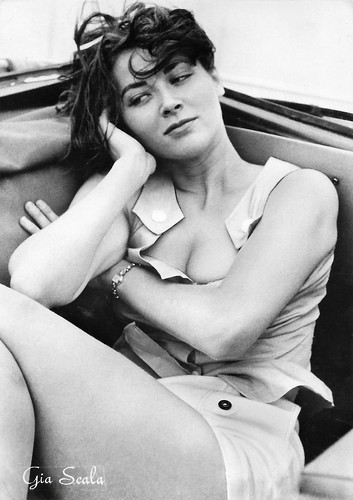
Italian postcard by Rotalfoto, Milano, no. 682.
Original Trailer The Guns of Navarone (1961). Source: IFILMuser (YouTube).
Sources: Wikipedia and .

Italian postcard by B.F.F. Edit., no. 3390. Photo: Universal International.

French postcard by Editions P.I., Paris, no. 690. Photo: Universal.
Cha Cha for Gia
Gia Scala was born Josephine Grace Johanna Scoglio in 1934, in Liverpool, England, to aristocratic Sicilian father Pietro Scoglio, and Irish mother Eileen O'Sullivan. She had one sister, Tina Scala, also an actress.
Scala was brought up in Messina and Mili San Marco in Sicily, the latter on the estate of her grandfather, Natale Scoglio, who was one of the largest citrus growers in Sicily. When Scala was 16, she moved to the United States to live with her aunt Agata in Whitestone, Queens, New York City.
In 1952, after graduating from Bayside High School, she moved to Manhattan to pursue acting. Scala supported herself by working at a travel agency. During this time, Scala studied acting with Stella Adler and the Actors Studio, where she met Steve McQueen. The two dated from 1952 to 1954.
Scala began to appear on game shows, including Stop the Music, where she later became host Bert Parks' assistant. There she was spotted by Maurice Bergman, an executive of Universal International located in New York City. In 1954, accompanied by her mother, Scala flew to Los Angeles to screen test for the role of Mary Magdalene in The Gallileans but the film ended up being scrapped.
Although she did not get the part, Peter Johnson at Universal was impressed with Scala's screen test. Scala had her first official job in Hollywood when she was given a non-speaking, uncredited part in All That Heaven Allows (Douglas Sirk, 1955), starring Jane Wyman and Rock Hudson . Despite her minor role in the film, Universal signed her to a contract, dyed her hair dark brown, had her four front teeth capped, and gave her the stage name Gia Scala.
Songwriter Henry Mancini met Scala on the set of Four Girls in Town (Jack Sher, 1957), with George Nader and Marianne Koch . Inspired by her beauty, he wrote 'Cha Cha for Gia', which appeared uncredited in the film. She also played in Tip on a Dead Jockey (Richard Thorpe, 1957) starring Robert Taylor, and the Film Noir The Garment Jungle (Vincent Sherman, Robert Aldrich, 1957), with Lee J. Cobb.
Scala became emotionally distraught following the death of her mother in 1957. She began to drink heavily as compensation which led to a few arrests.
In 1958, she became a naturalised American citizen. Scala soon after landed roles in such films as the romantic comedy The Tunnel of Love (Gene Kelly, 1958) with Doris Day , the Western Ride a Crooked Trail (Jesse Hibbs, 1958), with former World War II hero Audie Murphy and Walter Matthau, the war thriller The Two-Headed Spy (André De Toth, 1958) featuring Jack Hawkins , and The Angry Hills (Robert Aldrich, 1959) with Robert Mitchum .

Italian postcard, no. 526.
A Greek resistance fighter, tortured by the Nazis
In 1959, Gia Scala married Don Burnett, an actor who later turned investment banker. During the 1960s, Scala made frequent appearances on American television in such series as Alfred Hitchcock Presents (1960), The Rogues (1964-1965), Convoy (1965), Voyage to the Bottom of the Sea (1965), Twelve O'Clock High (1965), and Tarzan (1967).
Gia's best-known film role came as Anna, a Greek resistance fighter in the epic The Guns of Navarone (J. Lee Thompson, 1961), starring Gregory Peck and David Niven. Presumably, Anna had been so horribly tortured by the Nazis that she became mute.
Due to her unreliability, Scala eventually lost her contract at Universal, which forced her to seek work overseas. She co-starred with her handsome husband in the Italian adventure film Il trionfo di Robin Hood/The Triumph of Robin Hood (Umberto Lenzi, 1962).
Scala kept having difficulties with alcohol and her career began to wane. Her last feature film was the Spanish-American comedy Operación Dalila/Operation Delilah (Luis de los Arcos, 1967) with Rory Calhoun. Her marriage burnt itself out, and, at one point, she threw herself off London's Waterloo Bridge in desperation. She would have drowned in the Thames River had a passing cab driver not plucked her out of the water in time. Her final acting role was in the episode The Artist Is for Framing of the series It Takes a Thief (1969) starring Robert Wagner.
After 10 years of marriage, Burnett left her and moved in with Rock Hudson . Gia and Don divorced in 1970. Her sportscar turned over on a winding canyon road in July 1971 and she lost part of her index finger. Gary Brumburgh at IMDb : "Gia's bouts with depression grew so severe that she was forced to undergo frequent psychiatric observations. In the midst of things, she tried to pick herself up emotionally by studying painting and staying close to her younger sister, actress Tina Scala. It was too late."
In 1972, 38-year-old Scala was found dead in her Hollywood Hills home. Los Angeles County Coroner Thomas Noguchi reported her cause of death was from an "acute ethanol and barbiturate intoxication" (an overdose of alcohol and sleeping pills) and was later ruled accidental. The circumstances of the still beautiful Scala's death have been questioned, with some believing it was a result of either murder or suicide rather than accidental. She had first attempted suicide in 1958, after the death of her mother. She later tried again, after her ex-husband, Don Burnett, married Ironside star Barbara Anderson, a year after their divorce.
Her sister believed that she did not intend to take her life nor that her death was accidental. Scala had a prescription for valium and three tablets were missing from the bottle, but valium is a benzodiazepine, not a barbiturate. Also, Scala was discovered nude sprawled across her bed and bruises were found on her body and blood was on her pillow. Scala is interred next to her mother, Eileen O'Sullivan-Scoglio, in the Holy Cross Cemetery in Culver City, California. In 2014, the author/researcher Sterling Saint James wrote a book about Gia Scala's life titled 'Gia Scala: The First Gia'. Tina Scala provided intimate details about her sister's life.

Italian postcard by Rotalfoto, Milano, no. 682.
Original Trailer The Guns of Navarone (1961). Source: IFILMuser (YouTube).
Sources: Wikipedia and .
Published on June 06, 2020 22:00
June 5, 2020
The 'Künstler im Film' cigarette cards
A small part of our European film star postcard collection is formed by vintage cigarette cards. We simply can't resist these small, colourful treasures from the past. During the 1930s, Ross-Verlag in Berlin produced several series for German cigarette manufacturers. The cards were included in the cigarette packets and could be glued in special albums. For Zigarettenfabrik Monopol in Dresden, Ross made in the mid-1930s the series 'Künstler im Film' (Artists in Film) with 200 cards of 5,5 cm by 6,5 cm. In this post, EFSP reproduces 28 of the cards with international stars. The backsides contain info about when the star was born, how you could contact him or her (mostly through the studio) and the title(s) of his or her latest film(s).

German cigarette card by Ross Verlag in the 'Künstler im Film' series for Zigarettenfabrik Monopol, Dresden, Serie 1, image 1. Photo: Ufa.
Beautiful Lída Baarová (1914-2000) was a glamorous Czech film star who worked in Prague, Berlin, and Rome. A dangerous affair with Joseph Goebbels, the propaganda minister of the Third Reich, first enhanced and later seriously damaged her career.
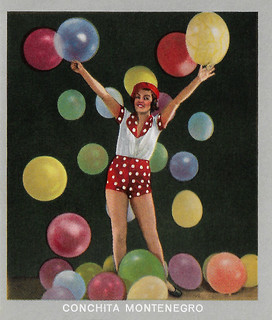
German cigarette card by Ross Verlag in the 'Künstler im Film' series for Zigarettenfabrik Monopol, Dresden, Serie 1, image 8. Photo: Metro-Goldwyn-Mayer.
Conchita Montenegro (1911-2007) was a Spanish model, dancer, and stage and screen actress. She starred in several Spanish productions, but also in French, German and American films.

German cigarette card by Ross Verlag in the 'Künstler im Film' series for Zigarettenfabrik Monopol, Dresden, Serie 1, image 13 (of 200). Photo: Ufa.
German actress Carola Höhn (1910-2005) had a 60 years lasting film career. She began as the elegant star of many Ufa productions and later became the acclaimed Grande Dame of the German post-war cinema.
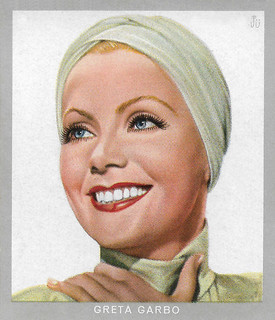
German cigarette card by Ross Verlag in the 'Künstler im Film' series for Zigarettenfabrik Monopol, Dresden, Serie 1, image 18. Photo: Metro-Goldwyn-Mayer. Greta Garbo in The Painted Veil (Richard Boleslawski, 1934).
Swedish Greta Garbo (1905-1990) was one of the greatest and most glamorous film stars ever produced by the Hollywood studio system. She was part of the Golden Age of the silent cinema of the 1920s and was one of the few actors who made a glorious transition to the talkies. She started her career in the European cinema and would always stay more popular in Europe than in the USA.
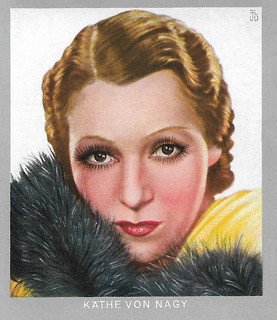
German cigarette card by Ross Verlag in the 'Künstler im Film' series for Zigarettenfabrik Monopol, Dresden, Serie 1, image 30 (of 200). Photo: Itala-Film.
Hungarian actress Käthe von Nagy (1904-1973) started as the ‘Backfish’ of German films of the late 1920s. In the early 1930s, she became a fashionable and charming star of the German and French cinema.
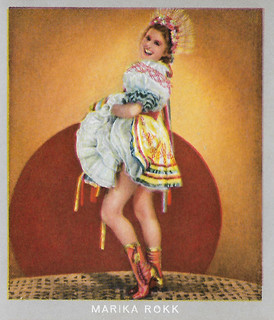
German cigarette card by Ross Verlag in the 'Künstler im Film' series for Zigarettenfabrik Monopol, Dresden, Serie 1, image 39 (of 200). Photo: Ufa.
Egyptian-born singer, dancer, and actress of Hungarian descent Marika Rökk (1913-2004) was the last film diva of the Ufa. She was an immensely talented musical performer who could tap with the rhythm and vitality of her Hollywood counterpart Eleanor Powell, and switch to balletic movements with the conviction of Cyd Charisse. Her trademark was her Hungarian accent.
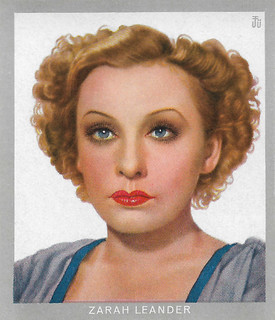
German cigarette card by Ross Verlag in the 'Künstler im Film' series for Zigarettenfabrik Monopol, Dresden, Serie 1, image 41 (of 200). Photo: Gloria-Syndikat.
Glamorous, mysterious diva Zarah Leander (1907-1981) was a Swedish actress and singer, who is now best remembered for her German songs and films from the late 1930s and early 1940s. With her fascinating and deep voice, she sang melancholic and a bit frivolous songs that were specifically composed for her. Zarah was for a time the best-paid film star of the Third Reich. In her Ufa vehicles, she always played the role of a cool femme fatale, independently minded, beautiful, passionate, self-confident and a bit sad. It gave her the nickname 'the Nazi Garbo', but a recent book claims that she was, in fact, a Soviet spy.
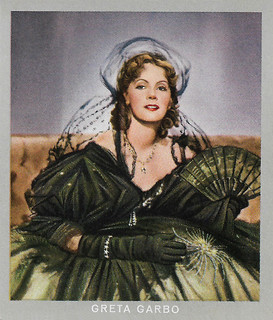
German cigarette card by Ross Verlag in the 'Künstler im Film' series for Zigarettenfabrik Monopol, Dresden, Serie 1, image 88 (from 200). Photo: Metro-Goldwyn-Mayer. Greta Garbo in Camille (George Cukor, 1936).
Swedish Greta Garbo (1905-1990) was one of the greatest and most glamorous film stars ever produced by the Hollywood studio system. She was part of the Golden Age of the silent cinema of the 1920s and was one of the few actors who made a glorious transition to the talkies. She started her career in the European cinema and would always stay more popular in Europe than in the USA.
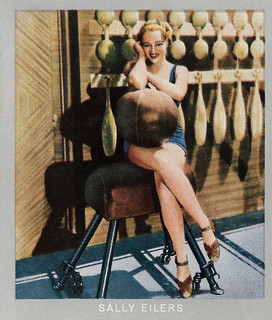
German cigarette card by Ross Verlag in the 'Künstler im Film' series for Zigarettenfabrik Monopol, Dresden, Serie 1, image 104 (of 200). Photo: 20th Century Fox.
American actress Sally Eilers (1908-1978) was a popular Hollywood star in the early-1930s. She was tagged 'the most beautiful girl in movies'.
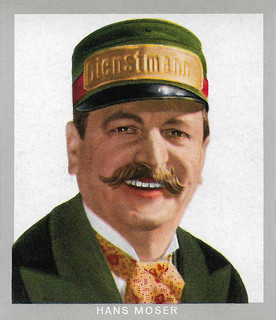
German cigarette card by Ross Verlag in the 'Künstler im Film' series for Zigarettenfabrik Monopol, Dresden, Serie 1, image 110 (of 200). Photo: Manassé-Ricoll. Hans Moser in Der Dienstmann (Adolf Rosen, 1932).
Austrian actor Hans Moser (1880-1964) appeared in over 150 films. During his long career, from the 1920s up to his death, he became very popular as the mumbling factotum in comedy films. Moser was particularly associated with the genre of the Wiener Film.
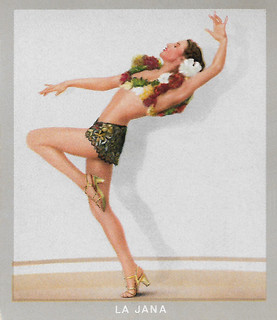
German cigarette card by Ross Verlag in the 'Künstler im Film' series for Zigarettenfabrik Monopol, Dresden, Serie 1, image 115 (of 200). Photo: Dührkoop.
Sexy German dancer and film actress La Jana (1905-1940) was the most popular showgirl of Berlin in the 1930s. She appeared in 25 European films, often dancing in exotic costumes. In 1940, she suddenly died of pneumonia and pleurisy.
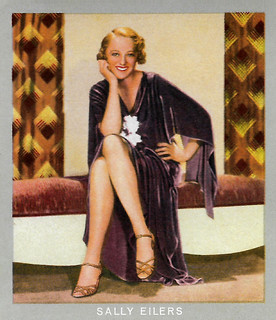
German cigarette card by Ross Verlag in the 'Künstler im Film' series for Zigarettenfabrik Monopol, Dresden, Serie 1, image 116 (of 200). Photo: Fox-Film.
American actress Sally Eilers (1908-1978) was a popular Hollywood star in the early-1930s. She was tagged 'the most beautiful girl in movies'.
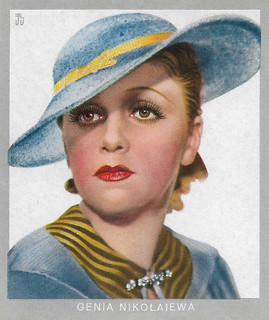
German cigarette card by Ross Verlag in the 'Künstler im Film' series for Zigarettenfabrik Monopol, Dresden, Serie 1, image 121. Photo: Ariel / Tobis / Rota.
Russian-born ballet dancer and actress Genia Nikolaieva (1904-2001) worked in the German cinema during the 1930s. In 1938 she emigrated to the United States, where she became ‘one of the most beautiful studio secretaries for Warner Bros'.
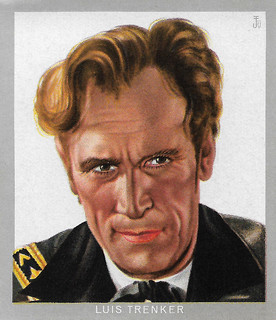
German cigarette card by Ross Verlag in the 'Künstler im Film' series for Zigarettenfabrik Monopol, Dresden, Serie 1, image 125 (of 200). Photo: Trenker / Tobis / Rota.
Luis Trenker (1892-1990) was an Austrian-Italian ski champion, mountain climber, architect, film director, and actor. He portrayed rugged, daring outdoorsmen in the Mountain Film, the genre which seemed to be created especially for him. His films glorified epic struggles such as colonization and wars for freedom and were set against spectacular, usually-mountainous landscapes.
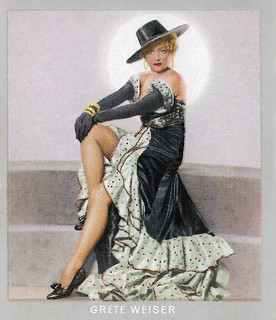
German cigarette card by Ross Verlag in the 'Künstler im Film' series for Zigarettenfabrik Monopol, Dresden, Serie 1, image 130. Photo: Ufa
Grethe Weiser (1903-1970) was a German singer, comedian, film and stage actress. She made more than 140 films.
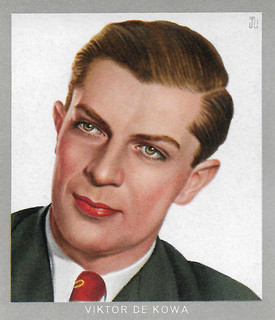
German cigarette card by Ross Verlag in the 'Künstler im Film' series for Zigarettenfabrik Monopol, Dresden, Serie 1, image 133 (of 200). Photo: Binder, Berlin.
Viktor de Kowa (1904-1973) was a German actor, singer, director and comedy writer. In the 1930s he became one of the most prominent and beloved comedy actors of the German cinema.
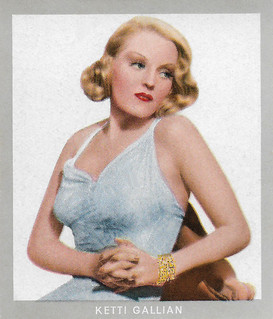
German cigarette card by Ross Verlag in the 'Künstler im Film' series for Zigarettenfabrik Monopol, Dresden, Serie 1, image 134 (of 200). Photo: Paramount.
Ketti Gallian (1912-1972) was a blonde French actress, who starred in films by Paramount and Fox during the 1930s. Her Hollywood career was not a success and she returned to France, where she acted in films till 1956.
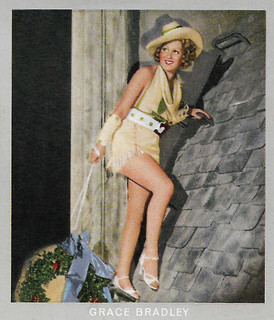
German cigarette card by Ross Verlag in the 'Künstler im Film' series for Zigarettenfabrik Monopol, Dresden, Serie 1, image 141 (of 200). Photo: Paramount.
Grace Bradley (1913-2010) was a petite, seductive and sassy American actress who played 'good-time' girls in many second feature thrillers and musicals of the 1930s and 1940s. She was the fifth and last wife of William 'Hoppalong Cassidy' Boyd.
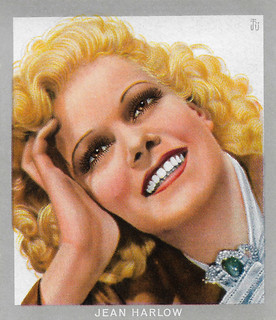
German cigarette card by Ross Verlag in the 'Künstler im Film' series for Zigarettenfabrik Monopol, Dresden, Serie 1, image 143 (of 200). Photo: Metro-Goldwyn-Mayer Studios.
American film actress Jean Harlow (1911–1937) was one of the sex symbols of the 1930s.
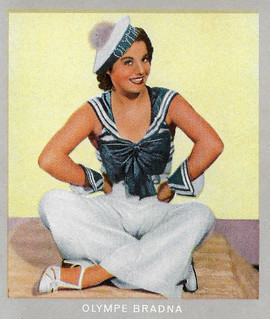
German cigarette card by Ross Verlag in the 'Künstler im Film' series for Zigarettenfabrik Monopol, Dresden, Serie 1, image 146 (of 200). Photo: Paramount.
Brunette leading lady Olympe Bradna (1920-2012) was a French dancer and actress, who danced in Paris, Stockholm, New York City, and other world capitals. In Hollywood, she appeared in more than a dozen films and starred opposite Ronald Reagan, George Raft and Gary Cooper. In the majority of her films, she played the ornamental love interest to sporting champs or war heroes and had little else to do.
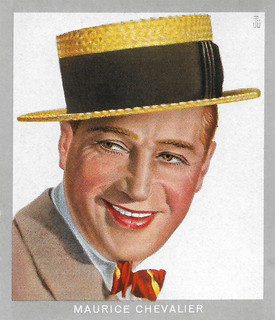
German cigarette card by Ross Verlag in the 'Künstler im Film' series for Zigarettenfabrik Monopol, Dresden, Serie 1, image 148 (of 200). Photo: Paramount.
Maurice Chevalier (1888-1972) was a French actor, singer, and entertainer with a very successful Hollywood career. His trademark was a casual straw hat, which he always wore on stage with a cane and a tuxedo.
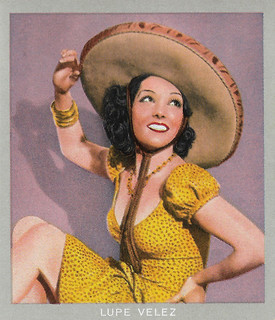
German cigarette card by Ross Verlag in the 'Künstler im Film' series for Zigarettenfabrik Monopol, Dresden, Serie 1, image 152 (of 200). Photo: Paramount. Lupe Velez in The Broken Wing (Lloyd Corrigan, 1932).
Lupe Velez (1908-1944), was one of the first Mexican actresses to succeed in Hollywood. Her nicknames were 'The Mexican Spitfire' and 'Hot Pepper'. She was the leading lady in such silent films as The Gaucho (1927), Lady of the Pavements (1928), and Wolf Song (1929). During the 1930s, her well-known explosive screen persona was exploited in a series of successful films like Hot Pepper (1933), Strictly Dynamite (1934), and Hollywood Party (1934). In the 1940s, Vélez's popularity peaked after appearing in the Mexican Spitfire films, a series created to capitalise on Vélez's well-documented fiery personality. She had several highly publicised romances and a stormy marriage. In 1944, Vélez died of an intentional overdose of the barbiturate drug Seconal. Her death and the circumstances surrounding it have been the subject of speculation and controversy.
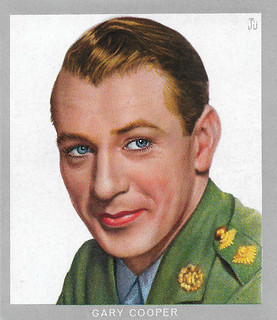
German cigarette card by Ross Verlag in the 'Künstler im Film' series for Zigarettenfabrik Monopol, Dresden, Serie 1, image 162 (of 200). Photo: Metro-Goldwyn-Mayer.
American screen legend Gary Cooper (1901-1961) is well remembered for his stoic, understated acting style in more than one hundred Westerns, comedies and dramas. He received five Oscar nominations and won twice for his roles as Alvin York in Sergeant York (1941) and as Will Kane in High Noon (1952).
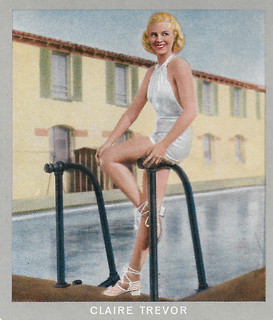
German cigarette card by Ross Verlag in the 'Künstler im Film' series for Zigarettenfabrik Monopol, Dresden, Serie 1, image 164 (of 200). Photo: 20th Century Fox.
American actress Claire Trevor (1910-2000) appeared in 68 feature films from 1933 to 1982. She often played the hard-boiled blonde or another type of shady lady. She won the Oscar for Best Supporting Actress for her role in Key Largo (1948) and received nominations for her roles in Dead End (1937) and The High and the Mighty (1954). But she is now best known for John Ford's classic Western Stagecoach (1939) with John Wayne.
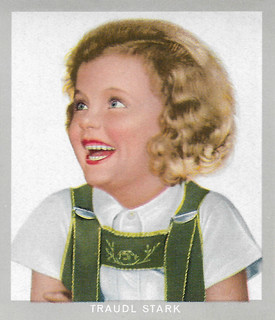
German cigarette card by Ross Verlag in the 'Künstler im Film' series for Zigarettenfabrik Monopol, Dresden, Serie 1, image 172 (of 200). Photo: Mondial-Film.
Austrian child actress Traudl Stark (1930) was the Shirley Temple of the German cinema. Between 1935 and 1940 she made a dozen popular films in Austria.
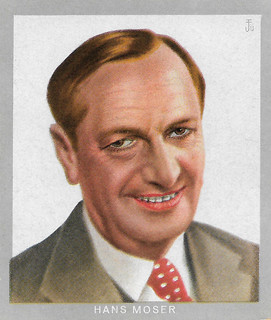
German cigarette card by Ross Verlag in the 'Künstler im Film' series for Zigarettenfabrik Monopol, Dresden, Serie 1, image 189 (of 200). Photo: Syndikat-Film.
Austrian actor Hans Moser (1880-1964) appeared in over 150 films. During his long career, from the 1920s up to his death, he became very popular as the mumbling factotum in comedy films. Moser was particularly associated with the genre of the Wiener Film.
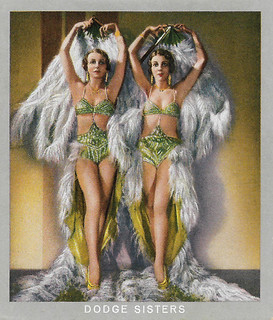
German cigarette card by Ross Verlag in the 'Künstler im Film' series for Zigarettenfabrik Monopol, Dresden, Serie 1, image 192 (of 200). Photo: Metro-Goldwyn-Mayer. The Dodge Sisters in The March of Time (Charles Reisner, 1931)
The Dodge Sisters were two American showgirls, who were known in the USA and Europe during the Jazz Age as ‘the two birds of Paradise’. The Dodge Twins sang, danced and dressed as birds and whistled. They seemingly emerged out of nowhere in the mid-1920s with a singing and dancing act that took Europe by storm. Beth and Betty Dodge were known for such films as Die schönsten Beine von Berlin/The most beautiful legs of Berlin (1927), Unter Ausschluß der Öffentlichkeit/Closed to the public (1927), and Wir schalten um auf Hollywood/We switch to Hollywood (1931).
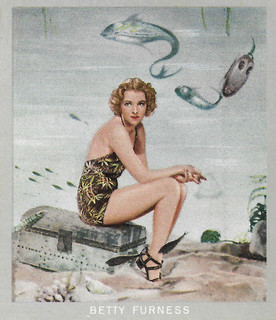
German cigarette card by Ross Verlag in the 'Künstler im Film' series for Zigarettenfabrik Monopol, Dresden, Serie 1, image 199 (of 200). Photo: Metro-Goldwyn-Mayer.
Betty Furness (1916-1994) was an American actress, a consumer advocate, and a current affairs commentator.

German cigarette card by Ross Verlag in the 'Künstler im Film' series for Zigarettenfabrik Monopol, Dresden, Serie 1, image 1. Photo: Ufa.
Beautiful Lída Baarová (1914-2000) was a glamorous Czech film star who worked in Prague, Berlin, and Rome. A dangerous affair with Joseph Goebbels, the propaganda minister of the Third Reich, first enhanced and later seriously damaged her career.

German cigarette card by Ross Verlag in the 'Künstler im Film' series for Zigarettenfabrik Monopol, Dresden, Serie 1, image 8. Photo: Metro-Goldwyn-Mayer.
Conchita Montenegro (1911-2007) was a Spanish model, dancer, and stage and screen actress. She starred in several Spanish productions, but also in French, German and American films.

German cigarette card by Ross Verlag in the 'Künstler im Film' series for Zigarettenfabrik Monopol, Dresden, Serie 1, image 13 (of 200). Photo: Ufa.
German actress Carola Höhn (1910-2005) had a 60 years lasting film career. She began as the elegant star of many Ufa productions and later became the acclaimed Grande Dame of the German post-war cinema.

German cigarette card by Ross Verlag in the 'Künstler im Film' series for Zigarettenfabrik Monopol, Dresden, Serie 1, image 18. Photo: Metro-Goldwyn-Mayer. Greta Garbo in The Painted Veil (Richard Boleslawski, 1934).
Swedish Greta Garbo (1905-1990) was one of the greatest and most glamorous film stars ever produced by the Hollywood studio system. She was part of the Golden Age of the silent cinema of the 1920s and was one of the few actors who made a glorious transition to the talkies. She started her career in the European cinema and would always stay more popular in Europe than in the USA.

German cigarette card by Ross Verlag in the 'Künstler im Film' series for Zigarettenfabrik Monopol, Dresden, Serie 1, image 30 (of 200). Photo: Itala-Film.
Hungarian actress Käthe von Nagy (1904-1973) started as the ‘Backfish’ of German films of the late 1920s. In the early 1930s, she became a fashionable and charming star of the German and French cinema.

German cigarette card by Ross Verlag in the 'Künstler im Film' series for Zigarettenfabrik Monopol, Dresden, Serie 1, image 39 (of 200). Photo: Ufa.
Egyptian-born singer, dancer, and actress of Hungarian descent Marika Rökk (1913-2004) was the last film diva of the Ufa. She was an immensely talented musical performer who could tap with the rhythm and vitality of her Hollywood counterpart Eleanor Powell, and switch to balletic movements with the conviction of Cyd Charisse. Her trademark was her Hungarian accent.

German cigarette card by Ross Verlag in the 'Künstler im Film' series for Zigarettenfabrik Monopol, Dresden, Serie 1, image 41 (of 200). Photo: Gloria-Syndikat.
Glamorous, mysterious diva Zarah Leander (1907-1981) was a Swedish actress and singer, who is now best remembered for her German songs and films from the late 1930s and early 1940s. With her fascinating and deep voice, she sang melancholic and a bit frivolous songs that were specifically composed for her. Zarah was for a time the best-paid film star of the Third Reich. In her Ufa vehicles, she always played the role of a cool femme fatale, independently minded, beautiful, passionate, self-confident and a bit sad. It gave her the nickname 'the Nazi Garbo', but a recent book claims that she was, in fact, a Soviet spy.

German cigarette card by Ross Verlag in the 'Künstler im Film' series for Zigarettenfabrik Monopol, Dresden, Serie 1, image 88 (from 200). Photo: Metro-Goldwyn-Mayer. Greta Garbo in Camille (George Cukor, 1936).
Swedish Greta Garbo (1905-1990) was one of the greatest and most glamorous film stars ever produced by the Hollywood studio system. She was part of the Golden Age of the silent cinema of the 1920s and was one of the few actors who made a glorious transition to the talkies. She started her career in the European cinema and would always stay more popular in Europe than in the USA.

German cigarette card by Ross Verlag in the 'Künstler im Film' series for Zigarettenfabrik Monopol, Dresden, Serie 1, image 104 (of 200). Photo: 20th Century Fox.
American actress Sally Eilers (1908-1978) was a popular Hollywood star in the early-1930s. She was tagged 'the most beautiful girl in movies'.

German cigarette card by Ross Verlag in the 'Künstler im Film' series for Zigarettenfabrik Monopol, Dresden, Serie 1, image 110 (of 200). Photo: Manassé-Ricoll. Hans Moser in Der Dienstmann (Adolf Rosen, 1932).
Austrian actor Hans Moser (1880-1964) appeared in over 150 films. During his long career, from the 1920s up to his death, he became very popular as the mumbling factotum in comedy films. Moser was particularly associated with the genre of the Wiener Film.

German cigarette card by Ross Verlag in the 'Künstler im Film' series for Zigarettenfabrik Monopol, Dresden, Serie 1, image 115 (of 200). Photo: Dührkoop.
Sexy German dancer and film actress La Jana (1905-1940) was the most popular showgirl of Berlin in the 1930s. She appeared in 25 European films, often dancing in exotic costumes. In 1940, she suddenly died of pneumonia and pleurisy.

German cigarette card by Ross Verlag in the 'Künstler im Film' series for Zigarettenfabrik Monopol, Dresden, Serie 1, image 116 (of 200). Photo: Fox-Film.
American actress Sally Eilers (1908-1978) was a popular Hollywood star in the early-1930s. She was tagged 'the most beautiful girl in movies'.

German cigarette card by Ross Verlag in the 'Künstler im Film' series for Zigarettenfabrik Monopol, Dresden, Serie 1, image 121. Photo: Ariel / Tobis / Rota.
Russian-born ballet dancer and actress Genia Nikolaieva (1904-2001) worked in the German cinema during the 1930s. In 1938 she emigrated to the United States, where she became ‘one of the most beautiful studio secretaries for Warner Bros'.

German cigarette card by Ross Verlag in the 'Künstler im Film' series for Zigarettenfabrik Monopol, Dresden, Serie 1, image 125 (of 200). Photo: Trenker / Tobis / Rota.
Luis Trenker (1892-1990) was an Austrian-Italian ski champion, mountain climber, architect, film director, and actor. He portrayed rugged, daring outdoorsmen in the Mountain Film, the genre which seemed to be created especially for him. His films glorified epic struggles such as colonization and wars for freedom and were set against spectacular, usually-mountainous landscapes.

German cigarette card by Ross Verlag in the 'Künstler im Film' series for Zigarettenfabrik Monopol, Dresden, Serie 1, image 130. Photo: Ufa
Grethe Weiser (1903-1970) was a German singer, comedian, film and stage actress. She made more than 140 films.

German cigarette card by Ross Verlag in the 'Künstler im Film' series for Zigarettenfabrik Monopol, Dresden, Serie 1, image 133 (of 200). Photo: Binder, Berlin.
Viktor de Kowa (1904-1973) was a German actor, singer, director and comedy writer. In the 1930s he became one of the most prominent and beloved comedy actors of the German cinema.

German cigarette card by Ross Verlag in the 'Künstler im Film' series for Zigarettenfabrik Monopol, Dresden, Serie 1, image 134 (of 200). Photo: Paramount.
Ketti Gallian (1912-1972) was a blonde French actress, who starred in films by Paramount and Fox during the 1930s. Her Hollywood career was not a success and she returned to France, where she acted in films till 1956.

German cigarette card by Ross Verlag in the 'Künstler im Film' series for Zigarettenfabrik Monopol, Dresden, Serie 1, image 141 (of 200). Photo: Paramount.
Grace Bradley (1913-2010) was a petite, seductive and sassy American actress who played 'good-time' girls in many second feature thrillers and musicals of the 1930s and 1940s. She was the fifth and last wife of William 'Hoppalong Cassidy' Boyd.

German cigarette card by Ross Verlag in the 'Künstler im Film' series for Zigarettenfabrik Monopol, Dresden, Serie 1, image 143 (of 200). Photo: Metro-Goldwyn-Mayer Studios.
American film actress Jean Harlow (1911–1937) was one of the sex symbols of the 1930s.

German cigarette card by Ross Verlag in the 'Künstler im Film' series for Zigarettenfabrik Monopol, Dresden, Serie 1, image 146 (of 200). Photo: Paramount.
Brunette leading lady Olympe Bradna (1920-2012) was a French dancer and actress, who danced in Paris, Stockholm, New York City, and other world capitals. In Hollywood, she appeared in more than a dozen films and starred opposite Ronald Reagan, George Raft and Gary Cooper. In the majority of her films, she played the ornamental love interest to sporting champs or war heroes and had little else to do.

German cigarette card by Ross Verlag in the 'Künstler im Film' series for Zigarettenfabrik Monopol, Dresden, Serie 1, image 148 (of 200). Photo: Paramount.
Maurice Chevalier (1888-1972) was a French actor, singer, and entertainer with a very successful Hollywood career. His trademark was a casual straw hat, which he always wore on stage with a cane and a tuxedo.

German cigarette card by Ross Verlag in the 'Künstler im Film' series for Zigarettenfabrik Monopol, Dresden, Serie 1, image 152 (of 200). Photo: Paramount. Lupe Velez in The Broken Wing (Lloyd Corrigan, 1932).
Lupe Velez (1908-1944), was one of the first Mexican actresses to succeed in Hollywood. Her nicknames were 'The Mexican Spitfire' and 'Hot Pepper'. She was the leading lady in such silent films as The Gaucho (1927), Lady of the Pavements (1928), and Wolf Song (1929). During the 1930s, her well-known explosive screen persona was exploited in a series of successful films like Hot Pepper (1933), Strictly Dynamite (1934), and Hollywood Party (1934). In the 1940s, Vélez's popularity peaked after appearing in the Mexican Spitfire films, a series created to capitalise on Vélez's well-documented fiery personality. She had several highly publicised romances and a stormy marriage. In 1944, Vélez died of an intentional overdose of the barbiturate drug Seconal. Her death and the circumstances surrounding it have been the subject of speculation and controversy.

German cigarette card by Ross Verlag in the 'Künstler im Film' series for Zigarettenfabrik Monopol, Dresden, Serie 1, image 162 (of 200). Photo: Metro-Goldwyn-Mayer.
American screen legend Gary Cooper (1901-1961) is well remembered for his stoic, understated acting style in more than one hundred Westerns, comedies and dramas. He received five Oscar nominations and won twice for his roles as Alvin York in Sergeant York (1941) and as Will Kane in High Noon (1952).

German cigarette card by Ross Verlag in the 'Künstler im Film' series for Zigarettenfabrik Monopol, Dresden, Serie 1, image 164 (of 200). Photo: 20th Century Fox.
American actress Claire Trevor (1910-2000) appeared in 68 feature films from 1933 to 1982. She often played the hard-boiled blonde or another type of shady lady. She won the Oscar for Best Supporting Actress for her role in Key Largo (1948) and received nominations for her roles in Dead End (1937) and The High and the Mighty (1954). But she is now best known for John Ford's classic Western Stagecoach (1939) with John Wayne.

German cigarette card by Ross Verlag in the 'Künstler im Film' series for Zigarettenfabrik Monopol, Dresden, Serie 1, image 172 (of 200). Photo: Mondial-Film.
Austrian child actress Traudl Stark (1930) was the Shirley Temple of the German cinema. Between 1935 and 1940 she made a dozen popular films in Austria.

German cigarette card by Ross Verlag in the 'Künstler im Film' series for Zigarettenfabrik Monopol, Dresden, Serie 1, image 189 (of 200). Photo: Syndikat-Film.
Austrian actor Hans Moser (1880-1964) appeared in over 150 films. During his long career, from the 1920s up to his death, he became very popular as the mumbling factotum in comedy films. Moser was particularly associated with the genre of the Wiener Film.

German cigarette card by Ross Verlag in the 'Künstler im Film' series for Zigarettenfabrik Monopol, Dresden, Serie 1, image 192 (of 200). Photo: Metro-Goldwyn-Mayer. The Dodge Sisters in The March of Time (Charles Reisner, 1931)
The Dodge Sisters were two American showgirls, who were known in the USA and Europe during the Jazz Age as ‘the two birds of Paradise’. The Dodge Twins sang, danced and dressed as birds and whistled. They seemingly emerged out of nowhere in the mid-1920s with a singing and dancing act that took Europe by storm. Beth and Betty Dodge were known for such films as Die schönsten Beine von Berlin/The most beautiful legs of Berlin (1927), Unter Ausschluß der Öffentlichkeit/Closed to the public (1927), and Wir schalten um auf Hollywood/We switch to Hollywood (1931).

German cigarette card by Ross Verlag in the 'Künstler im Film' series for Zigarettenfabrik Monopol, Dresden, Serie 1, image 199 (of 200). Photo: Metro-Goldwyn-Mayer.
Betty Furness (1916-1994) was an American actress, a consumer advocate, and a current affairs commentator.
Published on June 05, 2020 22:00
Paul van Yperen's Blog
- Paul van Yperen's profile
- 13 followers
Paul van Yperen isn't a Goodreads Author
(yet),
but they
do have a blog,
so here are some recent posts imported from
their feed.



